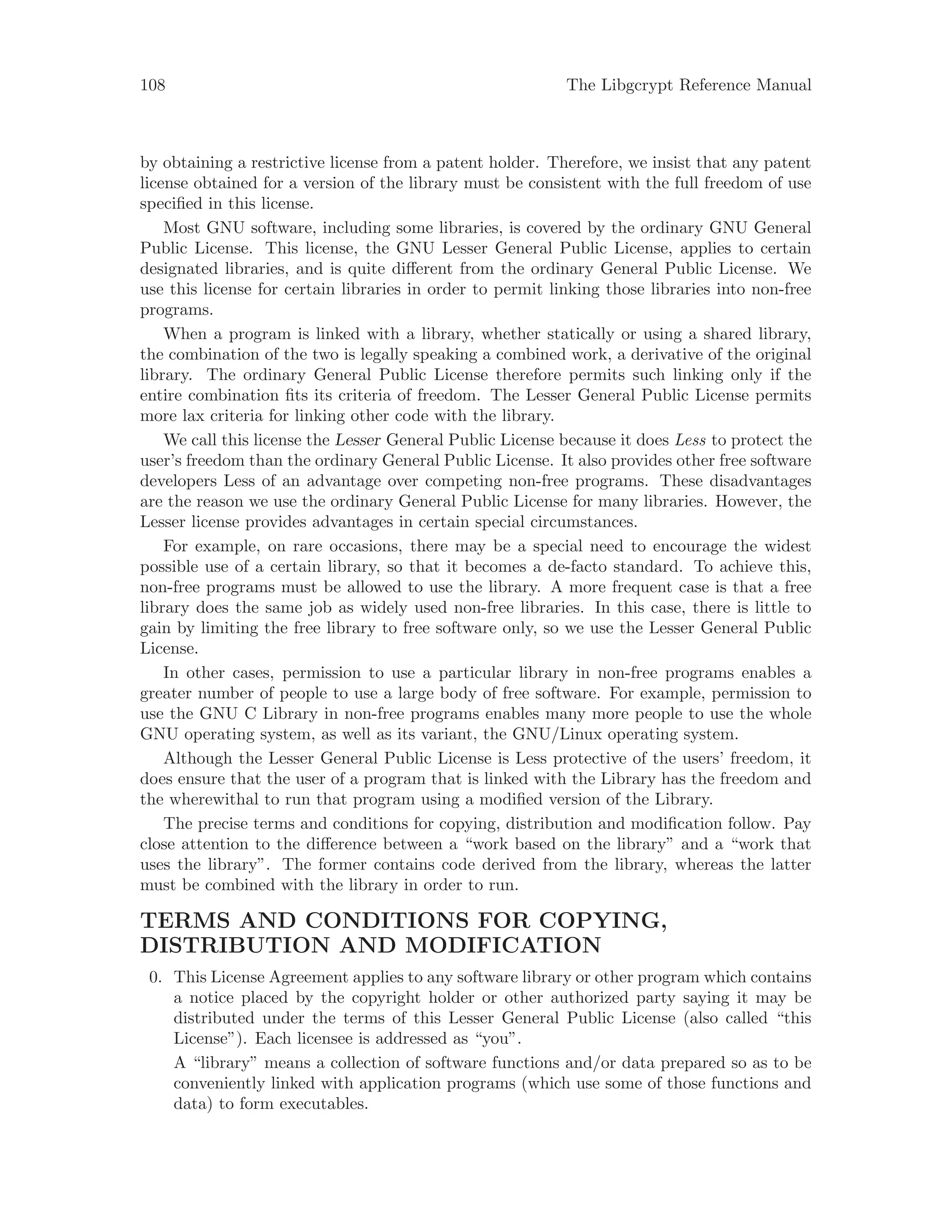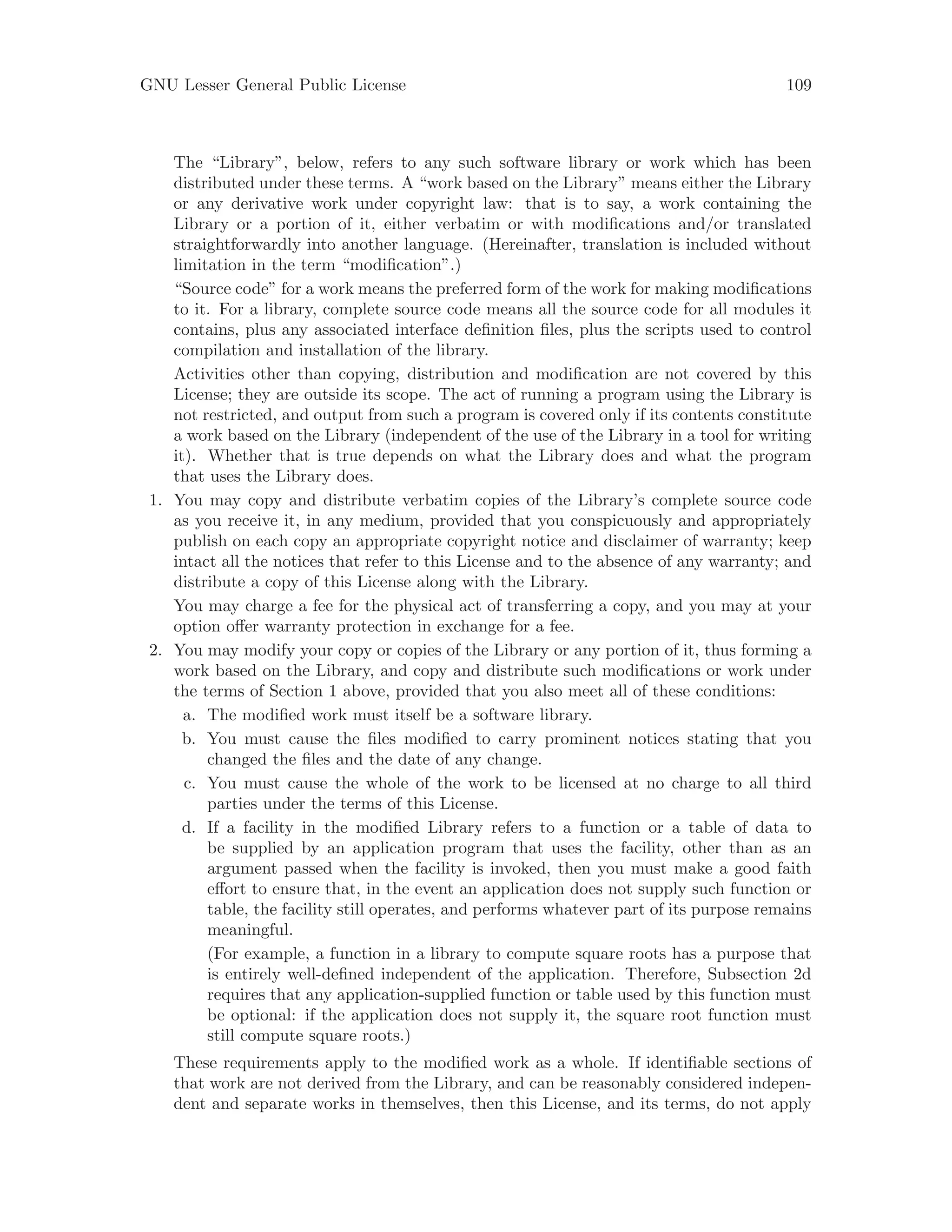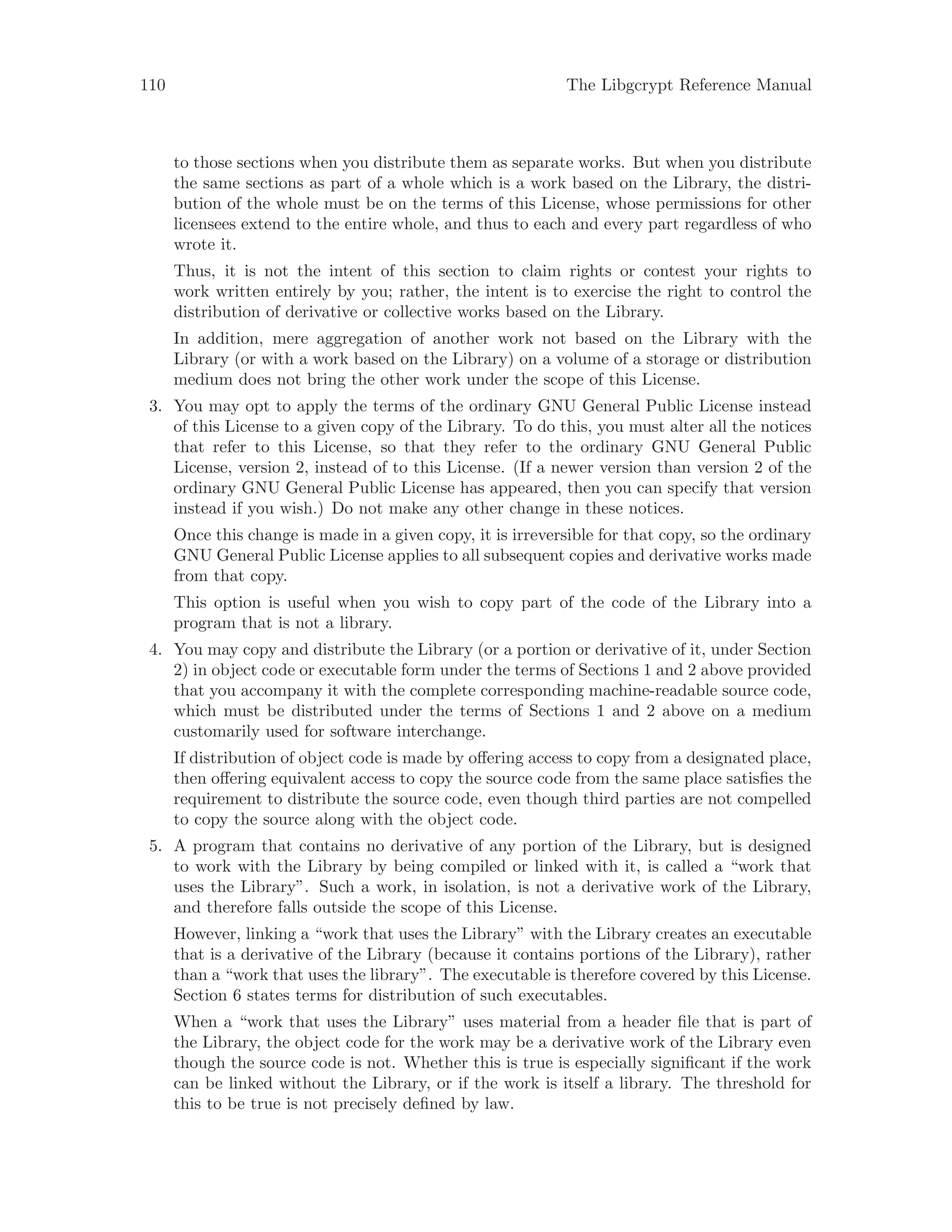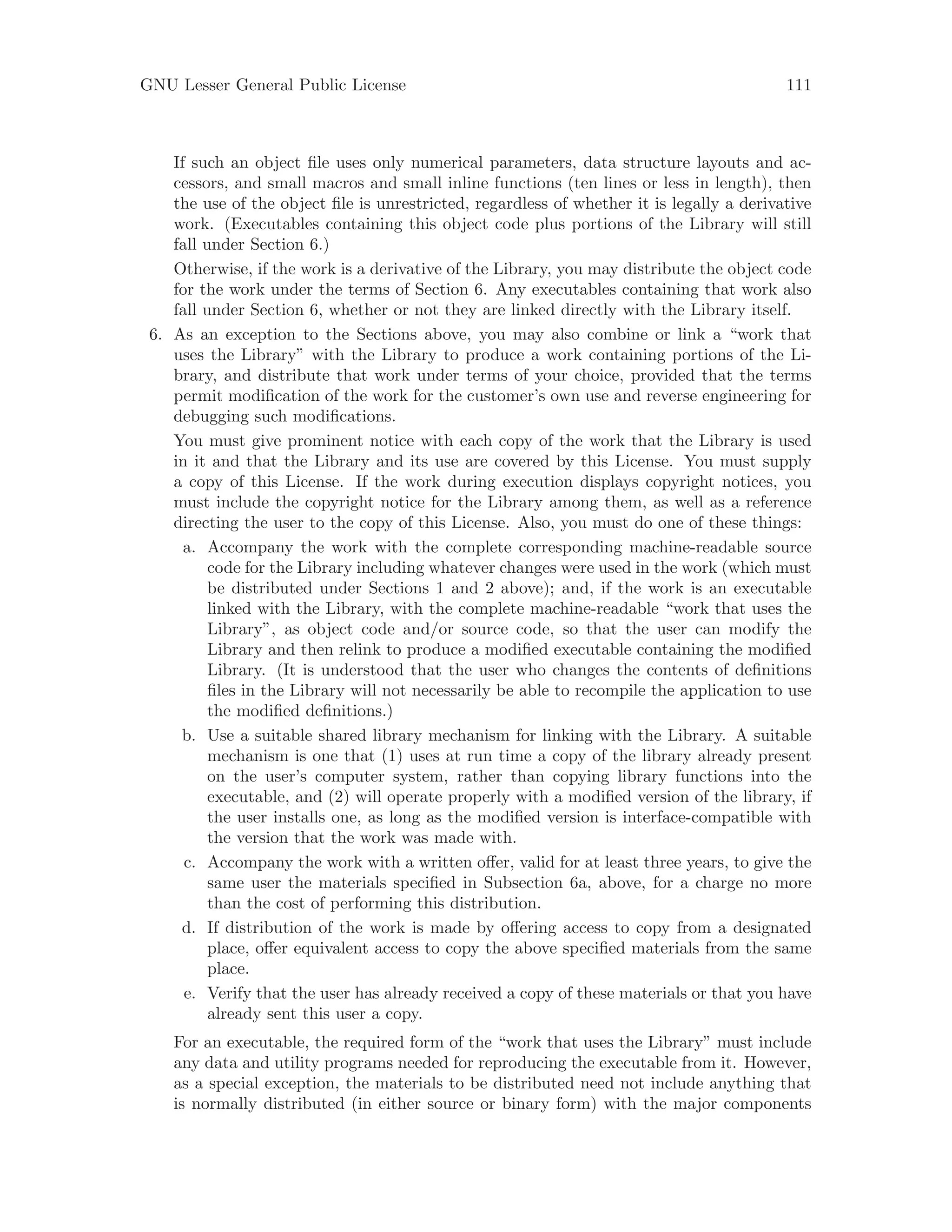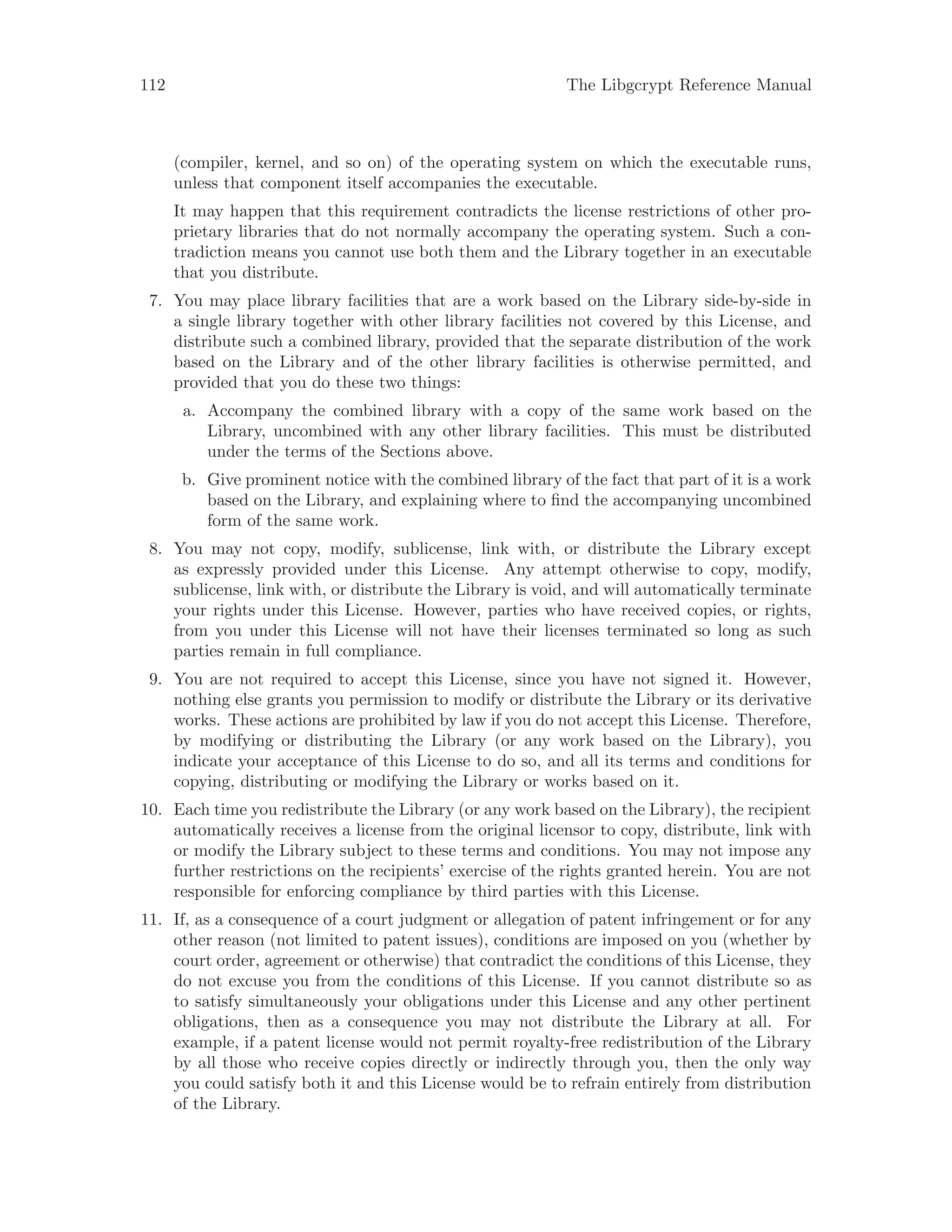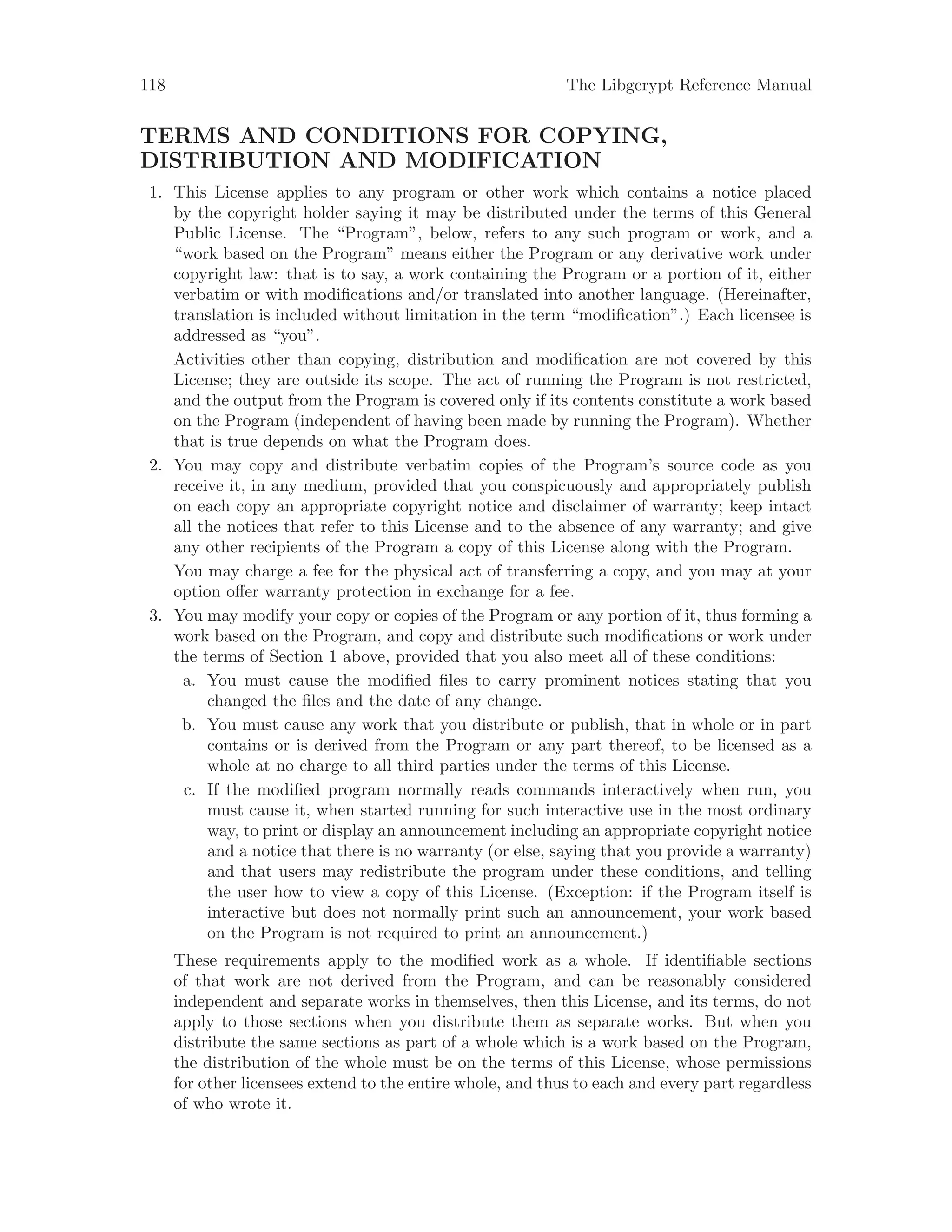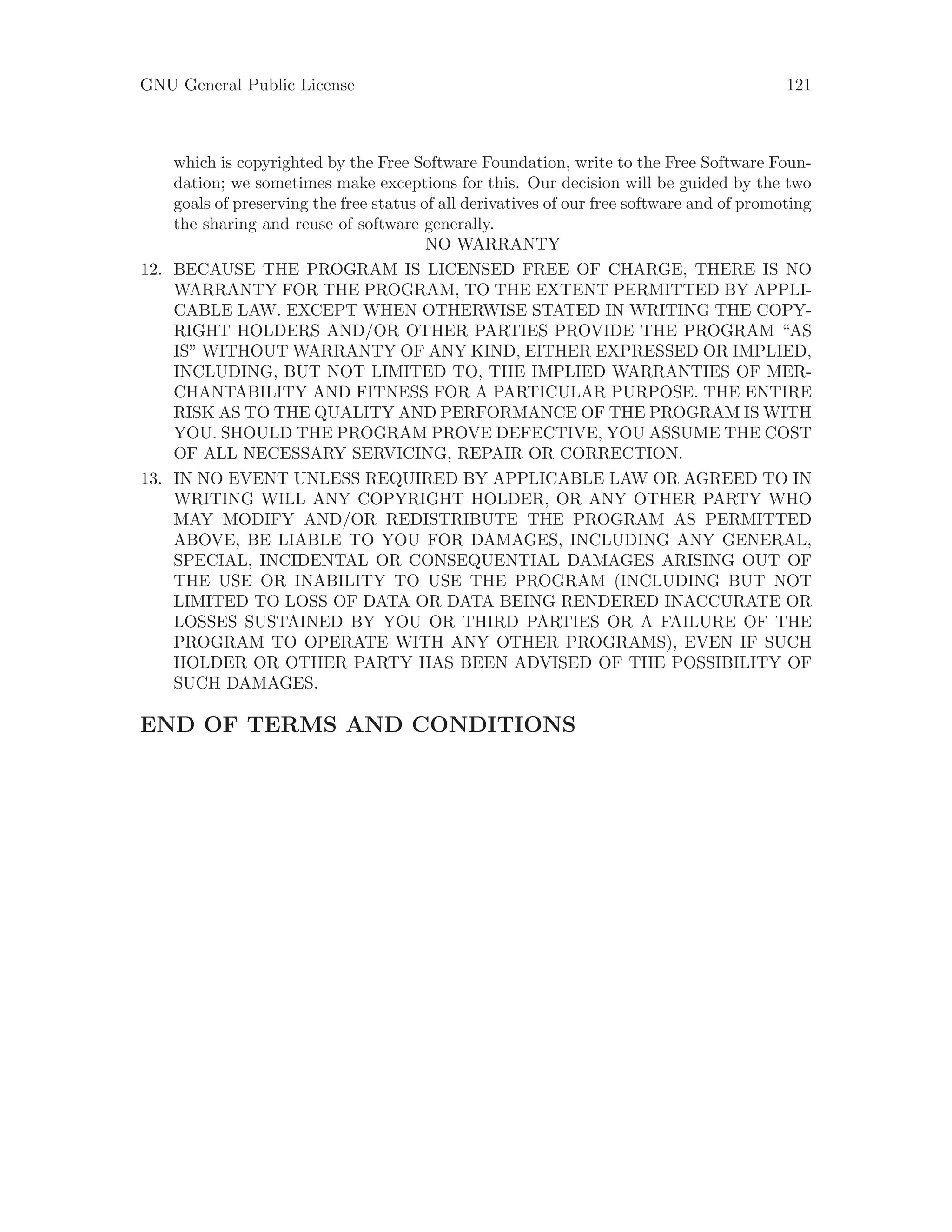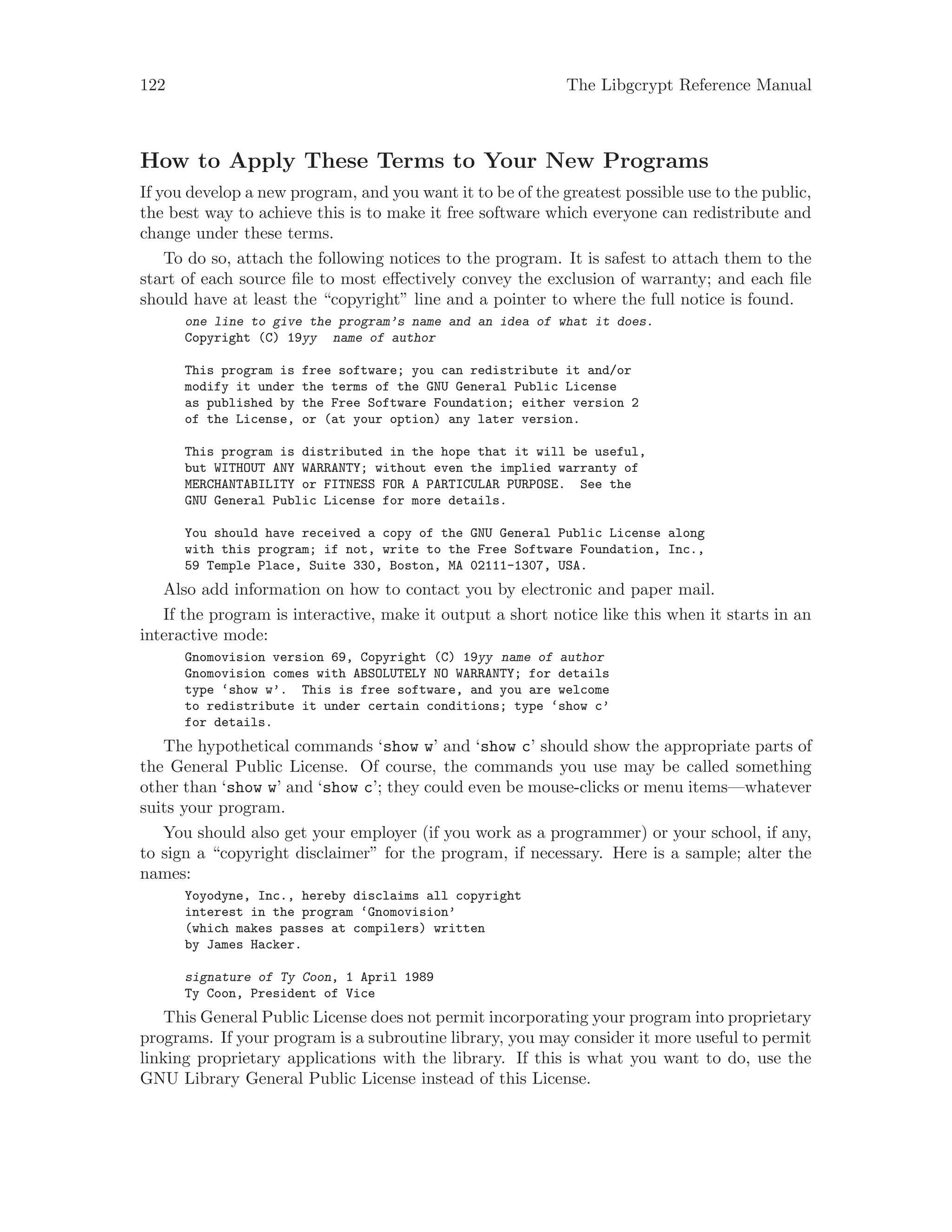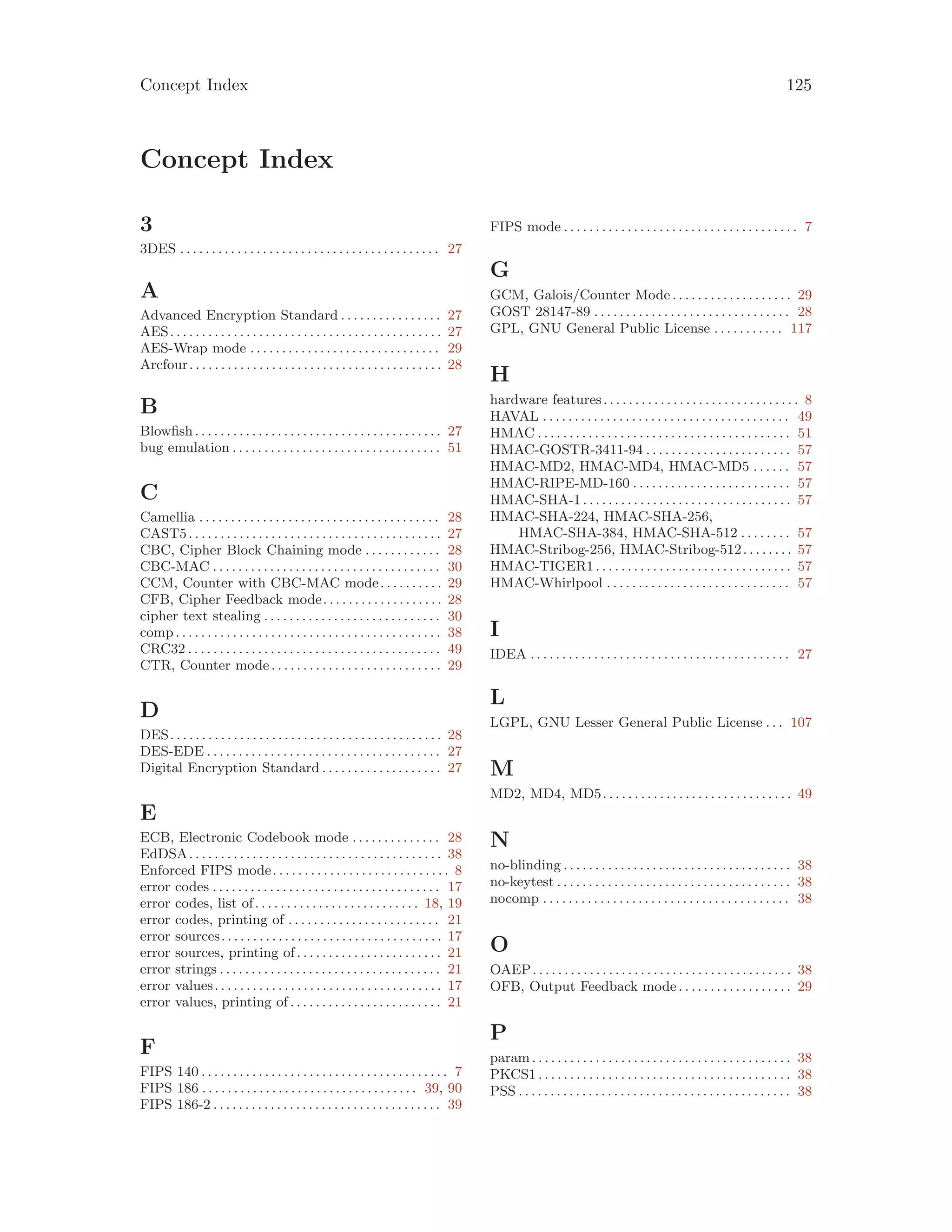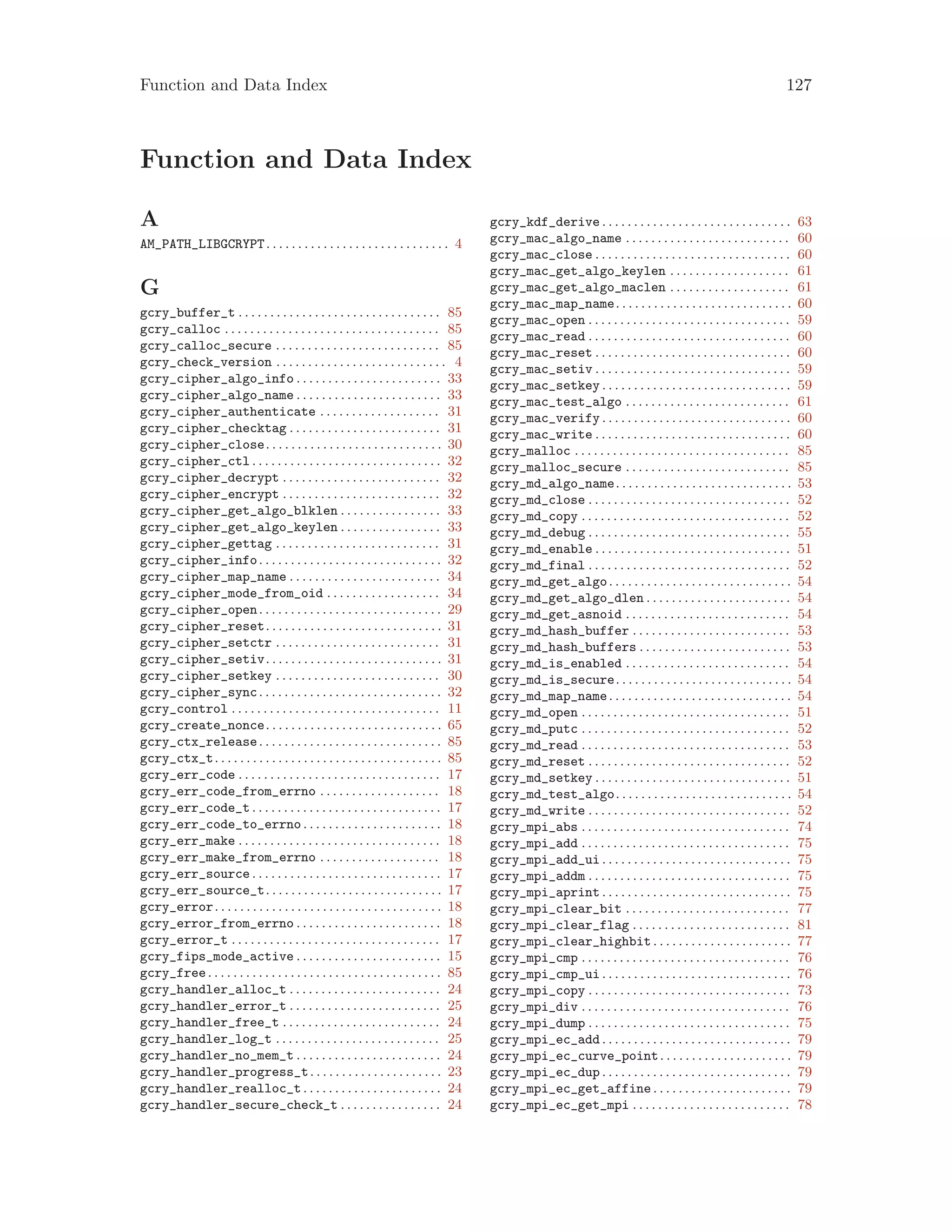This document is a reference manual for Libgcrypt version 1.6.4, which was released on September 7, 2015. Libgcrypt is a cryptographic library developed by GNU that provides cryptographic primitives like symmetric ciphers, public-key ciphers, hashes, and MACs. The manual provides documentation on using the various cryptographic algorithms and functions provided by Libgcrypt. It also covers topics like error handling, multi-threading, and the use of self-tests and FIPS mode. The manual is published under the GNU GPL license.
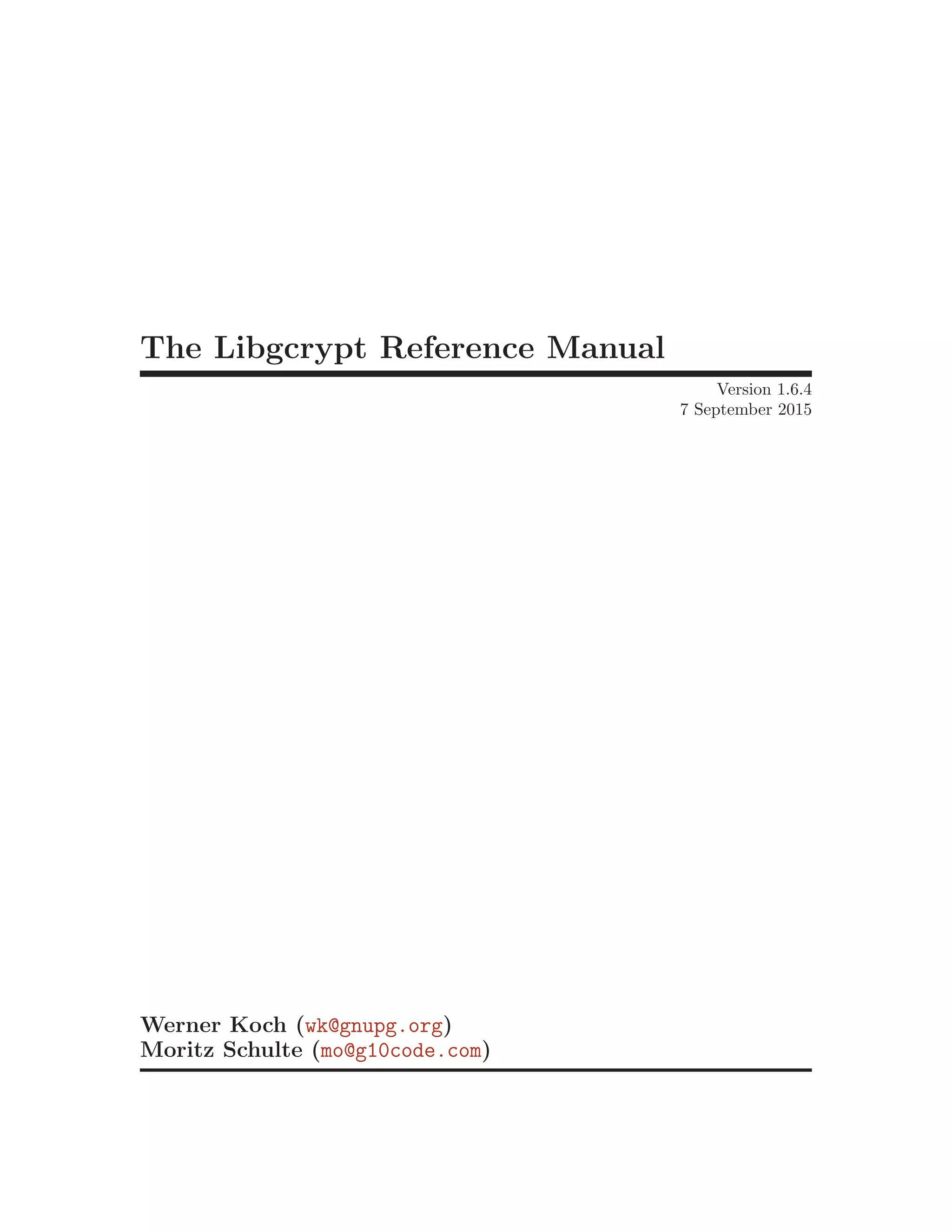



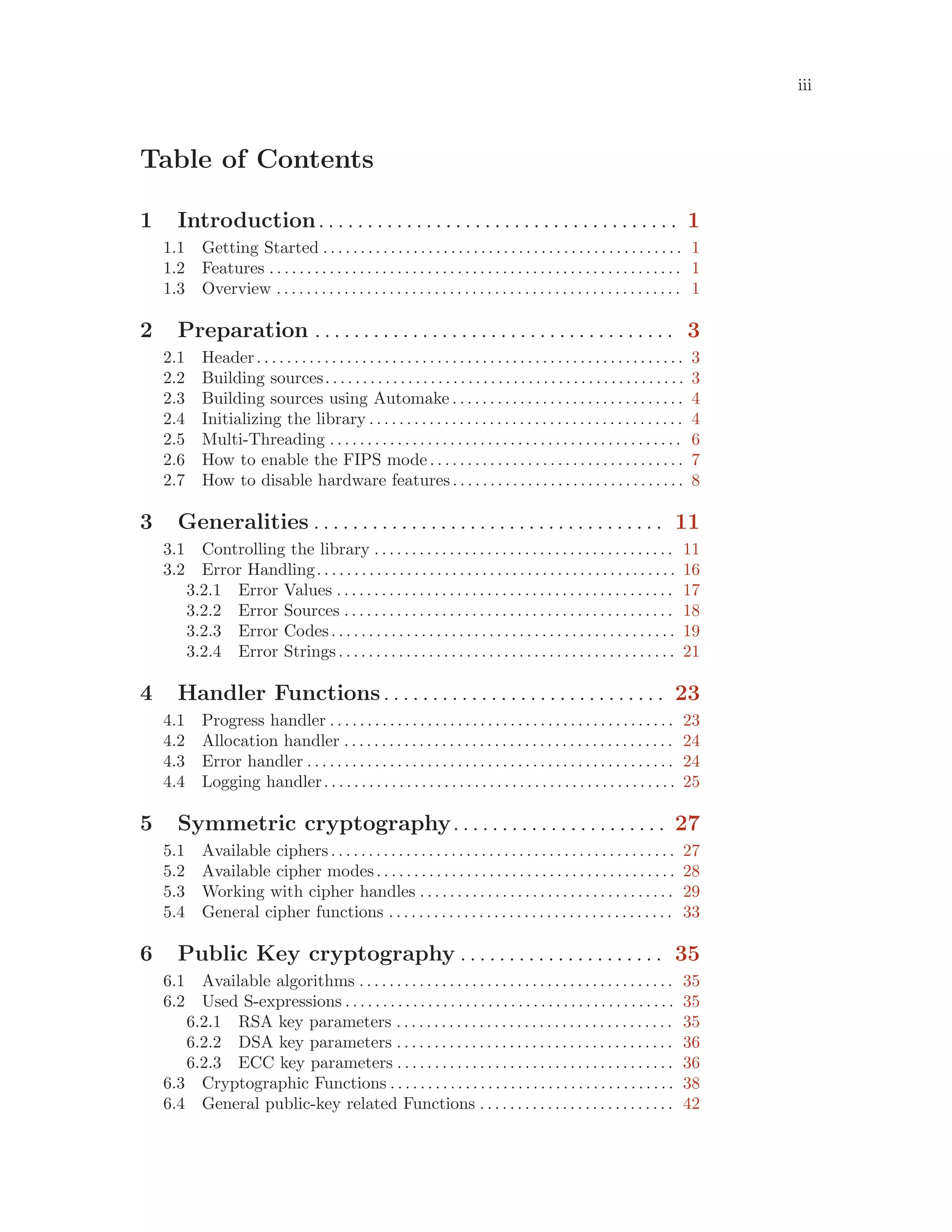
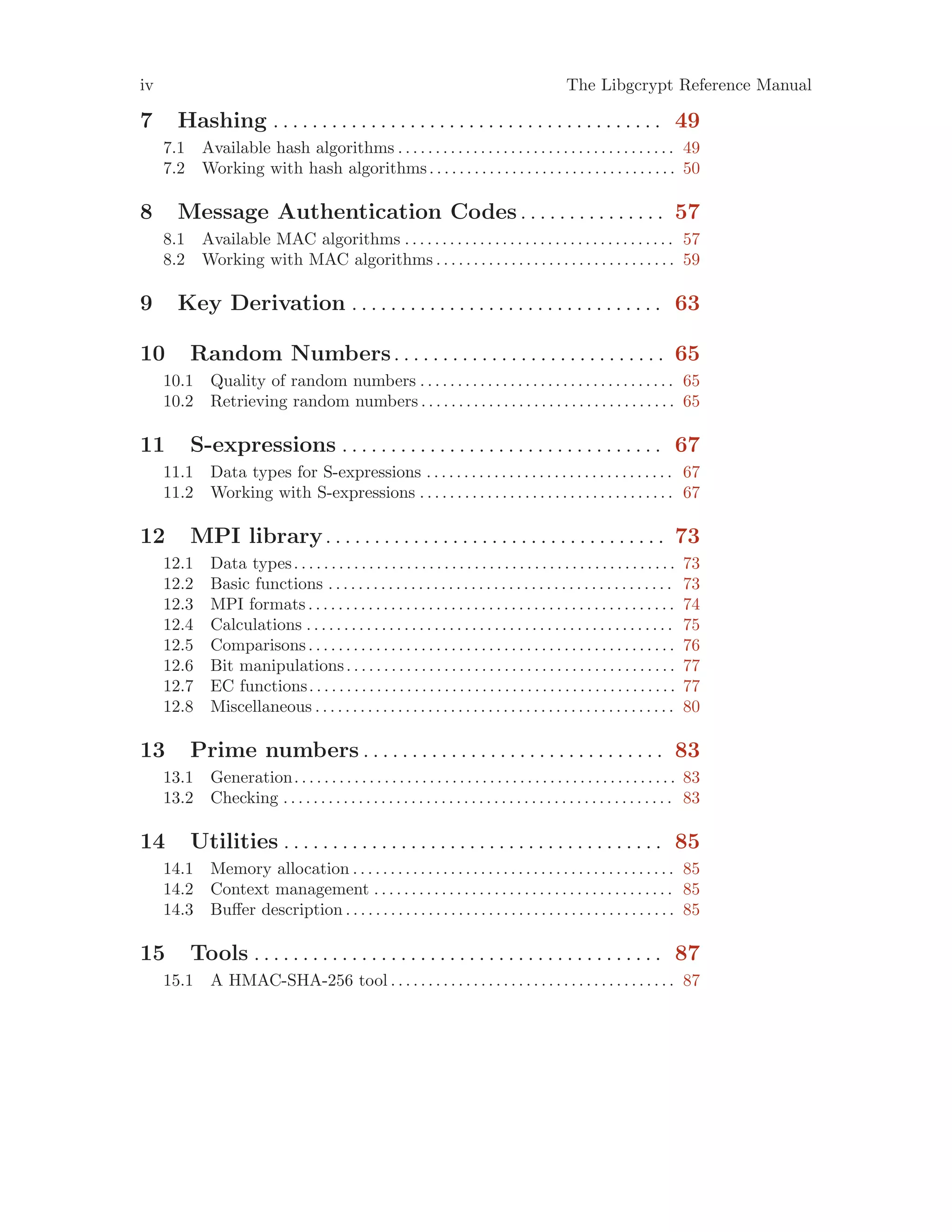
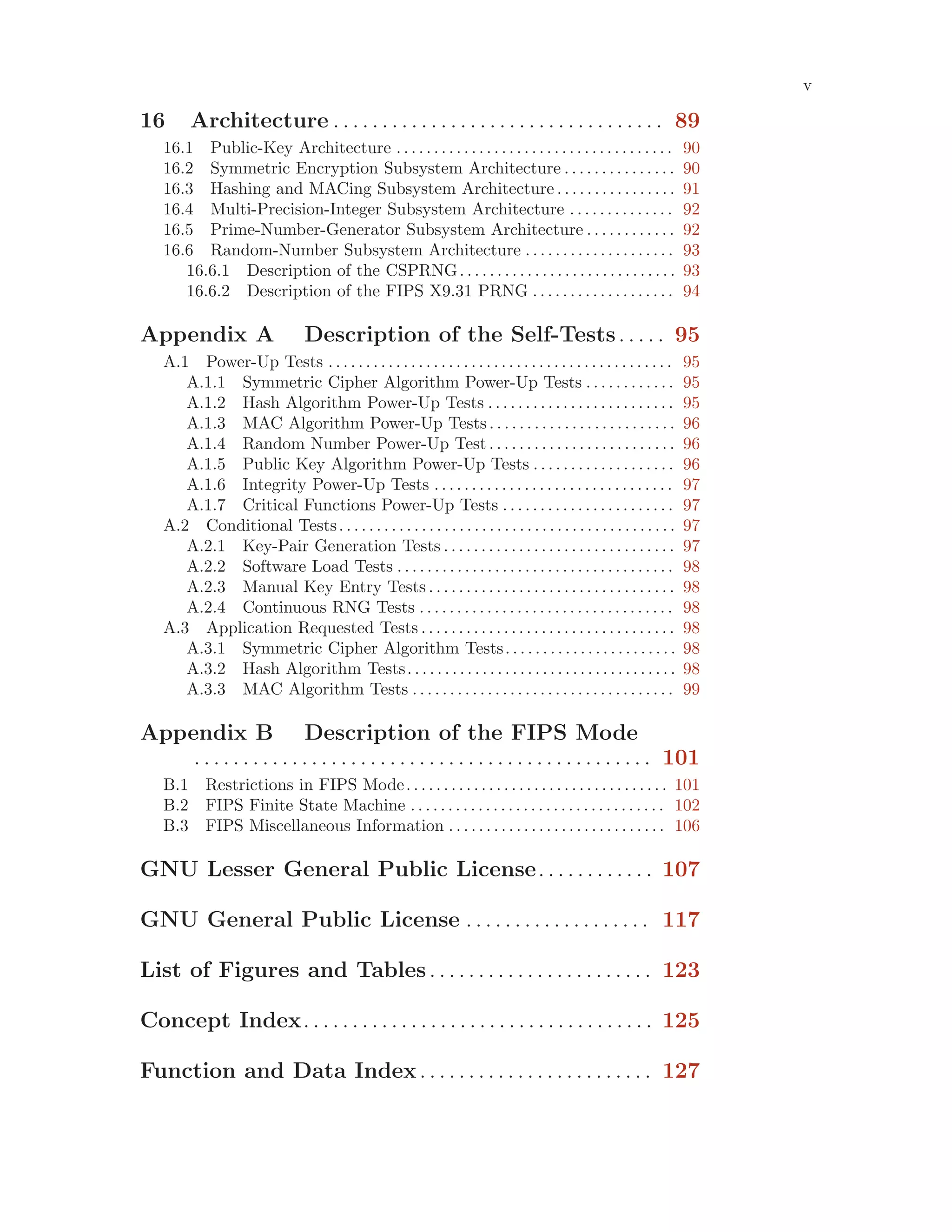

![Chapter 1: Introduction 1
1 Introduction
Libgcrypt is a library providing cryptographic building blocks.
1.1 Getting Started
This manual documents the Libgcrypt library application programming interface (API). All
functions and data types provided by the library are explained.
The reader is assumed to possess basic knowledge about applied cryptography.
This manual can be used in several ways. If read from the beginning to the end, it gives
a good introduction into the library and how it can be used in an application. Forward
references are included where necessary. Later on, the manual can be used as a reference
manual to get just the information needed about any particular interface of the library.
Experienced programmers might want to start looking at the examples at the end of the
manual, and then only read up those parts of the interface which are unclear.
1.2 Features
Libgcrypt might have a couple of advantages over other libraries doing a similar job.
It’s Free Software
Anybody can use, modify, and redistribute it under the terms of the GNU
Lesser General Public License (see [Library Copying], page 107). Note, that
some parts (which are in general not needed by applications) are subject to the
terms of the GNU General Public License (see [Copying], page 117); please see
the README file of the distribution for of list of these parts.
It encapsulates the low level cryptography
Libgcrypt provides a high level interface to cryptographic building blocks using
an extensible and flexible API.
1.3 Overview
The Libgcrypt library is fully thread-safe, where it makes sense to be thread-safe. Not
thread-safe are some cryptographic functions that modify a certain context stored in han-
dles. If the user really intents to use such functions from different threads on the same
handle, he has to take care of the serialization of such functions himself. If not described
otherwise, every function is thread-safe.
Libgcrypt depends on the library ‘libgpg-error’, which contains common error handling
related code for GnuPG components.](https://image.slidesharecdn.com/gcrypt-170906152619/75/Gcrypt-9-2048.jpg)

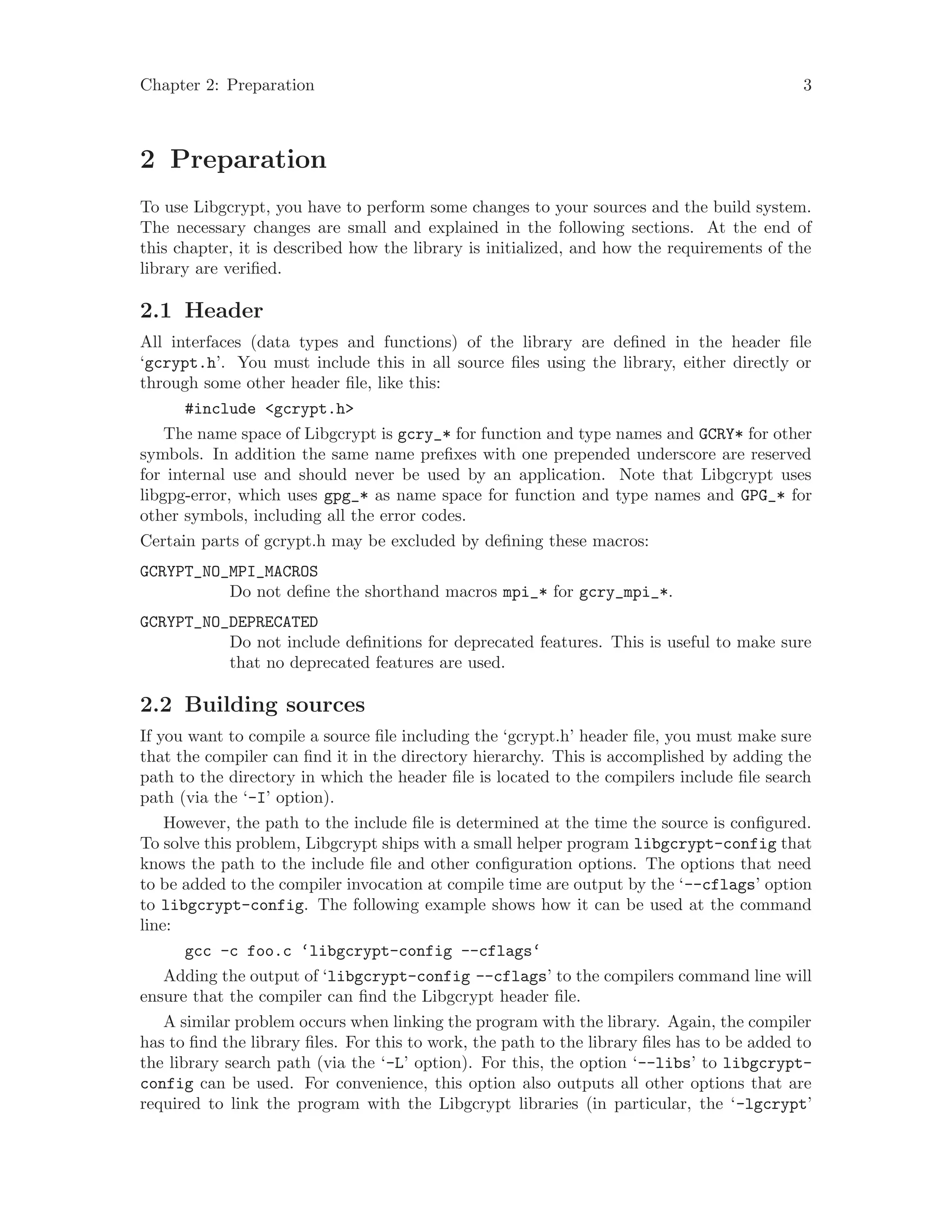
![4 The Libgcrypt Reference Manual
option). The example shows how to link ‘foo.o’ with the Libgcrypt library to a program
foo.
gcc -o foo foo.o ‘libgcrypt-config --libs‘
Of course you can also combine both examples to a single command by specifying both
options to libgcrypt-config:
gcc -o foo foo.c ‘libgcrypt-config --cflags --libs‘
2.3 Building sources using Automake
It is much easier if you use GNU Automake instead of writing your own Makefiles. If you
do that, you do not have to worry about finding and invoking the libgcrypt-config script
at all. Libgcrypt provides an extension to Automake that does all the work for you.
[Macro]AM_PATH_LIBGCRYPT ([minimum-version], [action-if-found],
[action-if-not-found])
Check whether Libgcrypt (at least version minimum-version, if given) exists on the
host system. If it is found, execute action-if-found, otherwise do action-if-not-found,
if given.
Additionally, the function defines LIBGCRYPT_CFLAGS to the flags needed for compi-
lation of the program to find the ‘gcrypt.h’ header file, and LIBGCRYPT_LIBS to the
linker flags needed to link the program to the Libgcrypt library.
You can use the defined Autoconf variables like this in your ‘Makefile.am’:
AM_CPPFLAGS = $(LIBGCRYPT_CFLAGS)
LDADD = $(LIBGCRYPT_LIBS)
2.4 Initializing the library
Before the library can be used, it must initialize itself. This is achieved by invoking the
function gcry_check_version described below.
Also, it is often desirable to check that the version of Libgcrypt used is indeed one
which fits all requirements. Even with binary compatibility, new features may have been
introduced, but due to problem with the dynamic linker an old version may actually be
used. So you may want to check that the version is okay right after program startup.
[Function]const char * gcry_check_version (const char *req_version)
The function gcry_check_version initializes some subsystems used by Libgcrypt
and must be invoked before any other function in the library, with the exception of
the GCRYCTL_SET_THREAD_CBS command (called via the gcry_control function). See
Section 2.5 [Multi-Threading], page 6.
Furthermore, this function returns the version number of the library. It can also verify
that the version number is higher than a certain required version number req version,
if this value is not a null pointer.
Libgcrypt uses a concept known as secure memory, which is a region of memory set aside
for storing sensitive data. Because such memory is a scarce resource, it needs to be setup
in advanced to a fixed size. Further, most operating systems have special requirements on](https://image.slidesharecdn.com/gcrypt-170906152619/75/Gcrypt-12-2048.jpg)
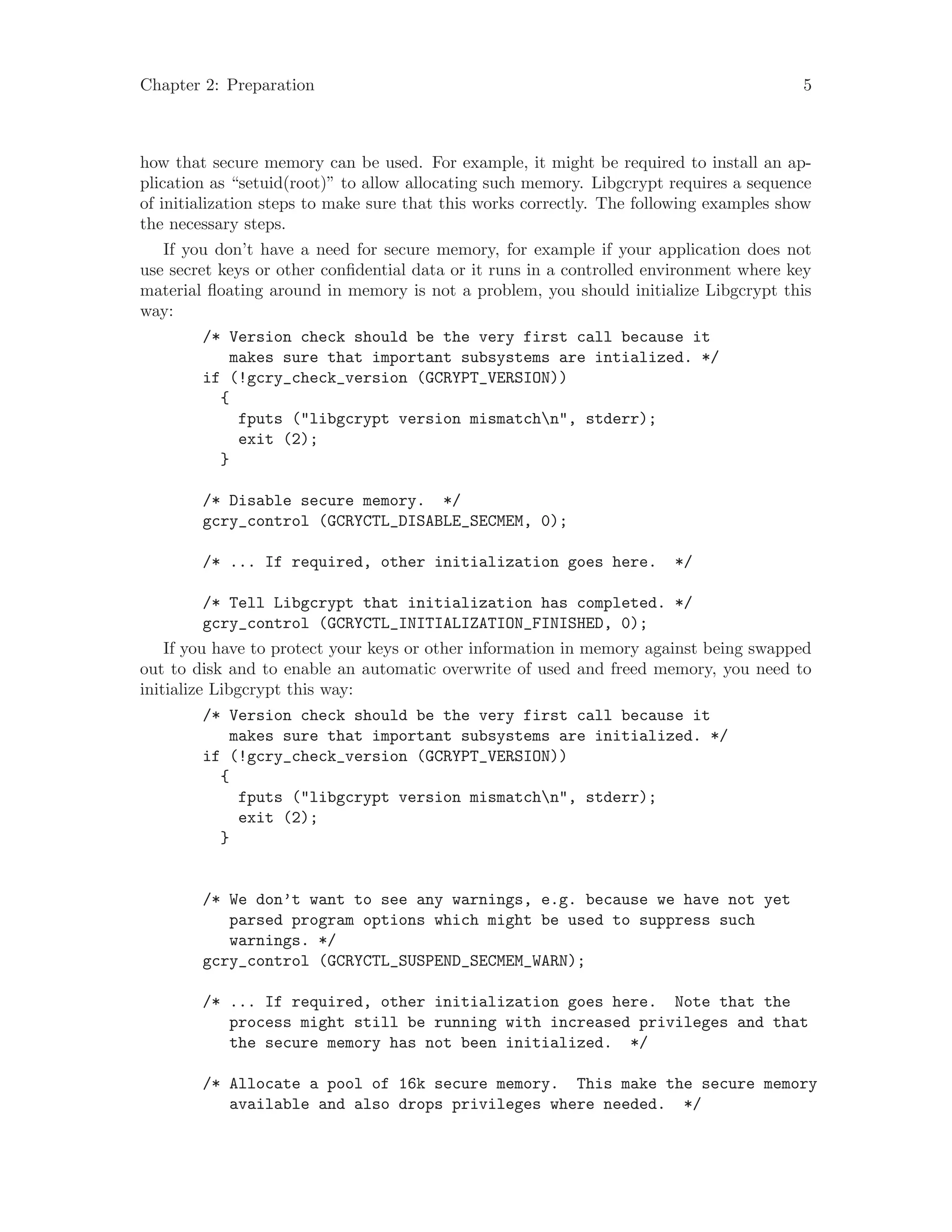
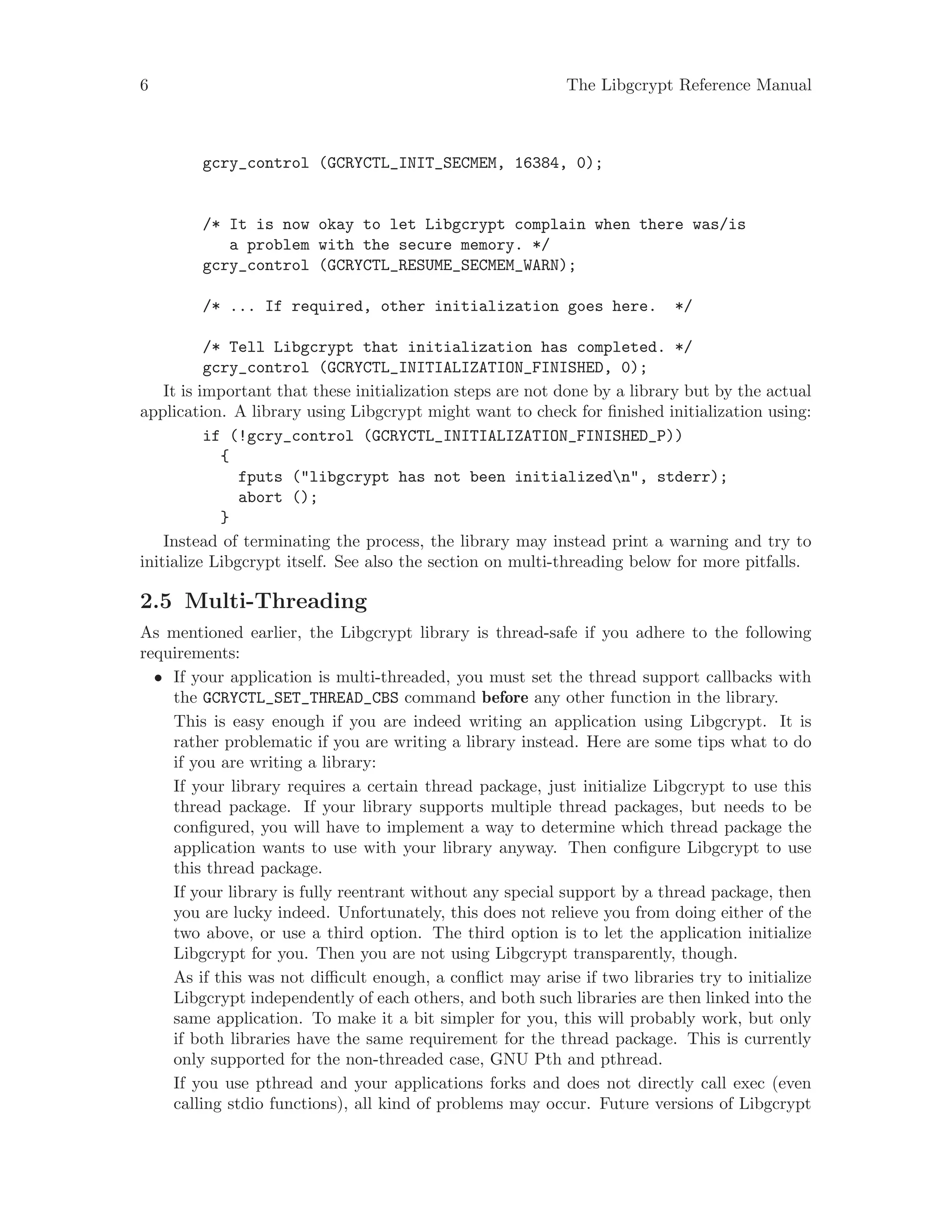
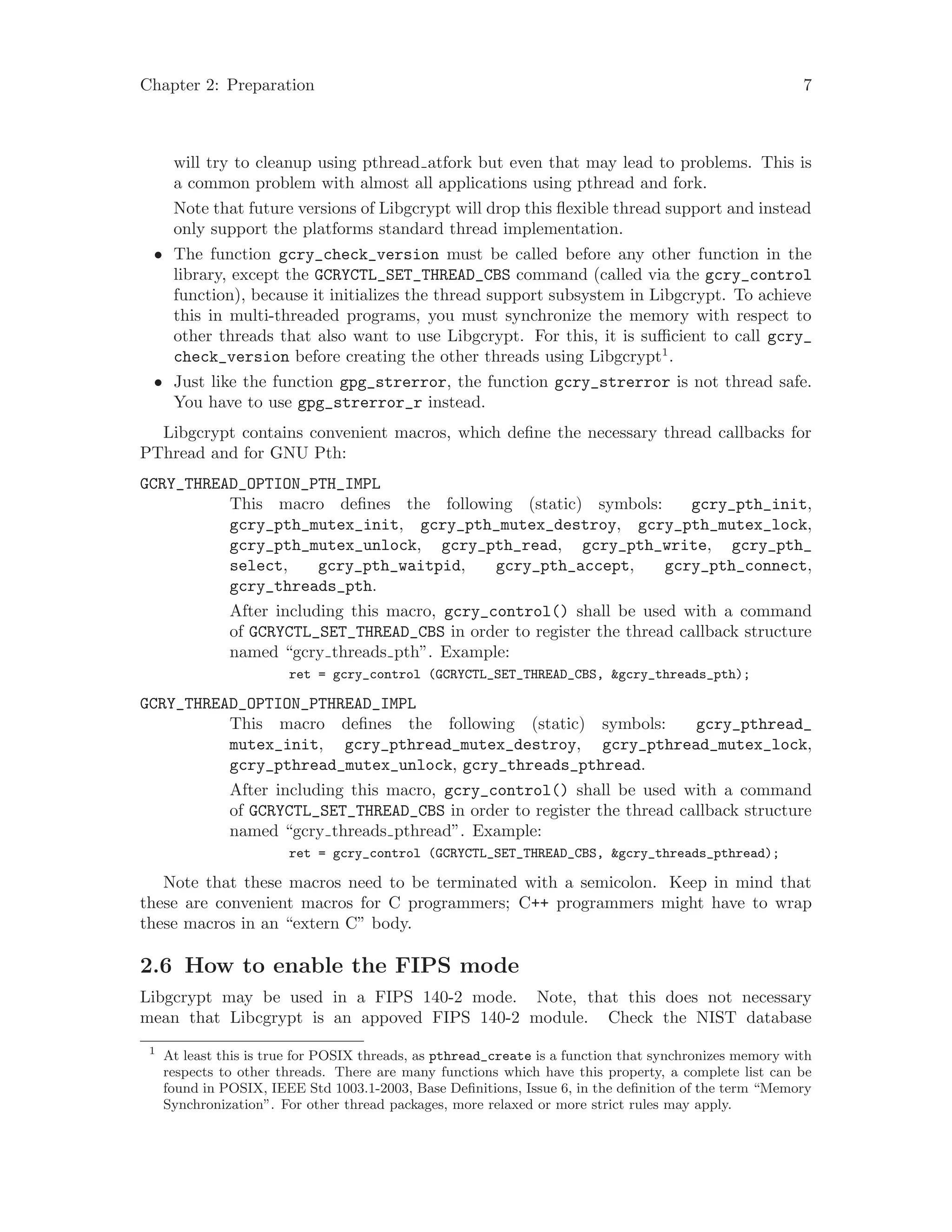
![8 The Libgcrypt Reference Manual
at http://csrc.nist.gov/groups/STM/cmvp/ to see what versions of Libgcrypt are
approved.
Because FIPS 140 has certain restrictions on the use of cryptography which are not
always wanted, Libgcrypt needs to be put into FIPS mode explicitly. Three alternative
mechanisms are provided to switch Libgcrypt into this mode:
• If the file ‘/proc/sys/crypto/fips_enabled’ exists and contains a numeric value other
than 0, Libgcrypt is put into FIPS mode at initialization time. Obviously this works
only on systems with a proc file system (i.e. GNU/Linux).
• If the file ‘/etc/gcrypt/fips_enabled’ exists, Libgcrypt is put into FIPS mode at
initialization time. Note that this filename is hardwired and does not depend on any
configuration options.
• If the application requests FIPS mode using the control command GCRYCTL_FORCE_
FIPS_MODE. This must be done prior to any initialization (i.e. before gcry_check_
version).
In addition to the standard FIPS mode, Libgcrypt may also be put into an Enforced
FIPS mode by writing a non-zero value into the file ‘/etc/gcrypt/fips_enabled’ or by
using the control command GCRYCTL_SET_ENFORCED_FIPS_FLAG before any other calls to
libgcrypt. The Enforced FIPS mode helps to detect applications which don’t fulfill all
requirements for using Libgcrypt in FIPS mode (see Appendix B [FIPS Mode], page 101).
Once Libgcrypt has been put into FIPS mode, it is not possible to switch back to standard
mode without terminating the process first. If the logging verbosity level of Libgcrypt has
been set to at least 2, the state transitions and the self-tests are logged.
2.7 How to disable hardware features
Libgcrypt makes use of certain hardware features. If the use of a feature is not desired it
may be either be disabled by a program or globally using a configuration file. The currently
supported features are
padlock-rng
padlock-aes
padlock-sha
padlock-mmul
intel-cpu
intel-bmi2
intel-ssse3
intel-pclmul
intel-aesni
intel-rdrand
intel-avx
intel-avx2
arm-neon
To disable a feature for all processes using Libgcrypt 1.6 or newer, create the file
‘/etc/gcrypt/hwf.deny’ and put each feature not to be used on a single line. Empty
lines, white space, and lines prefixed with a hash mark are ignored. The file should be
world readable.](https://image.slidesharecdn.com/gcrypt-170906152619/75/Gcrypt-16-2048.jpg)


![Chapter 3: Generalities 11
3 Generalities
3.1 Controlling the library
[Function]gcry_error_t gcry_control (enum gcry ctl cmds cmd, ...)
This function can be used to influence the general behavior of Libgcrypt in several
ways. Depending on cmd, more arguments can or have to be provided.
GCRYCTL_ENABLE_M_GUARD; Arguments: none
This command enables the built-in memory guard. It must not be used
to activate the memory guard after the memory management has already
been used; therefore it can ONLY be used before gcry_check_version.
Note that the memory guard is NOT used when the user of the library
has set his own memory management callbacks.
GCRYCTL_ENABLE_QUICK_RANDOM; Arguments: none
This command inhibits the use the very secure random quality level
(GCRY_VERY_STRONG_RANDOM) and degrades all request down to GCRY_
STRONG_RANDOM. In general this is not recommended. However, for some
applications the extra quality random Libgcrypt tries to create is not jus-
tified and this option may help to get better performance. Please check
with a crypto expert whether this option can be used for your application.
This option can only be used at initialization time.
GCRYCTL_DUMP_RANDOM_STATS; Arguments: none
This command dumps random number generator related statistics to the
library’s logging stream.
GCRYCTL_DUMP_MEMORY_STATS; Arguments: none
This command dumps memory management related statistics to the li-
brary’s logging stream.
GCRYCTL_DUMP_SECMEM_STATS; Arguments: none
This command dumps secure memory management related statistics to
the library’s logging stream.
GCRYCTL_DROP_PRIVS; Arguments: none
This command disables the use of secure memory and drops the privileges
of the current process. This command has not much use; the suggested
way to disable secure memory is to use GCRYCTL_DISABLE_SECMEM right
after initialization.
GCRYCTL_DISABLE_SECMEM; Arguments: none
This command disables the use of secure memory. If this command is
used in FIPS mode, FIPS mode will be disabled and the function gcry_
fips_mode_active returns false. However, in Enforced FIPS mode this
command has no effect at all.
Many applications do not require secure memory, so they should disable
it right away. This command should be executed right after gcry_check_
version.](https://image.slidesharecdn.com/gcrypt-170906152619/75/Gcrypt-19-2048.jpg)
![12 The Libgcrypt Reference Manual
GCRYCTL_DISABLE_LOCKED_SECMEM; Arguments: none
This command disables the use of the mlock call for secure memory.
Disabling the use of mlock may for example be done if an encrypted swap
space is in use. This command should be executed right after gcry_
check_version.
GCRYCTL_DISABLE_PRIV_DROP; Arguments: none
This command sets a global flag to tell the secure memory subsystem
that it shall not drop privileges after secure memory has been allocated.
This command is commonly used right after gcry_check_version but
may also be used right away at program startup. It won’t have an effect
after the secure memory pool has been initialized. WARNING: A process
running setuid(root) is a severe security risk. Processes making use of
Libgcrypt or other complex code should drop these extra privileges as
soon as possible. If this command has been used the caller is responsible
for dropping the privileges.
GCRYCTL_INIT_SECMEM; Arguments: int nbytes
This command is used to allocate a pool of secure memory and thus
enabling the use of secure memory. It also drops all extra privileges the
process has (i.e. if it is run as setuid (root)). If the argument nbytes
is 0, secure memory will be disabled. The minimum amount of secure
memory allocated is currently 16384 bytes; you may thus use a value of
1 to request that default size.
GCRYCTL_TERM_SECMEM; Arguments: none
This command zeroises the secure memory and destroys the handler.
The secure memory pool may not be used anymore after running this
command. If the secure memory pool as already been destroyed, this
command has no effect. Applications might want to run this command
from their exit handler to make sure that the secure memory gets properly
destroyed. This command is not necessarily thread-safe but that should
not be needed in cleanup code. It may be called from a signal handler.
GCRYCTL_DISABLE_SECMEM_WARN; Arguments: none
Disable warning messages about problems with the secure memory sub-
system. This command should be run right after gcry_check_version.
GCRYCTL_SUSPEND_SECMEM_WARN; Arguments: none
Postpone warning messages from the secure memory subsystem. See [the
initialization example], page 5, on how to use it.
GCRYCTL_RESUME_SECMEM_WARN; Arguments: none
Resume warning messages from the secure memory subsystem. See [the
initialization example], page 6, on how to use it.
GCRYCTL_USE_SECURE_RNDPOOL; Arguments: none
This command tells the PRNG to store random numbers in secure mem-
ory. This command should be run right after gcry_check_version and
not later than the command GCRYCTL INIT SECMEM. Note that in
FIPS mode the secure memory is always used.](https://image.slidesharecdn.com/gcrypt-170906152619/75/Gcrypt-20-2048.jpg)
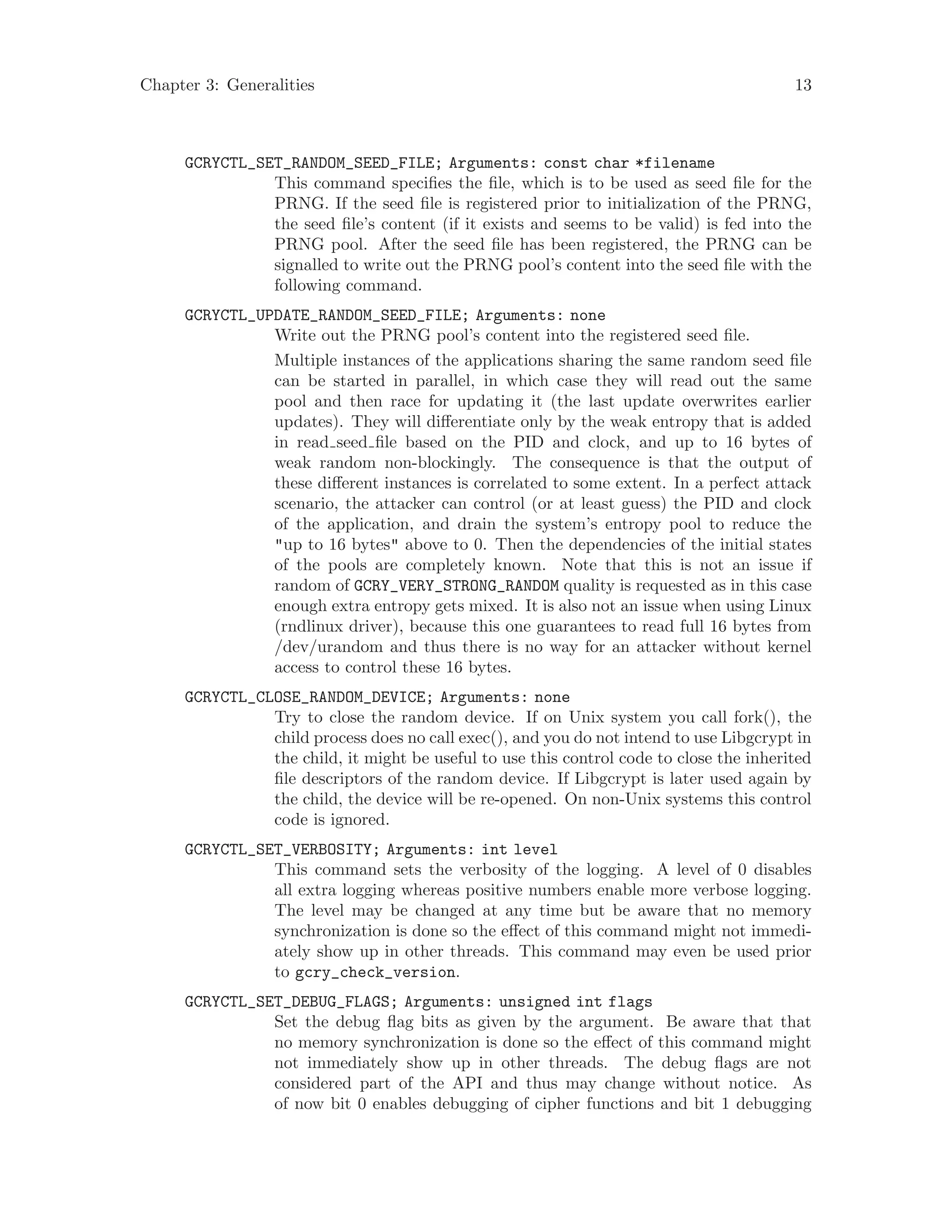
![14 The Libgcrypt Reference Manual
of multi-precision-integers. This command may even be used prior to
gcry_check_version.
GCRYCTL_CLEAR_DEBUG_FLAGS; Arguments: unsigned int flags
Set the debug flag bits as given by the argument. Be aware that that no
memory synchronization is done so the effect of this command might not
immediately show up in other threads. This command may even be used
prior to gcry_check_version.
GCRYCTL_DISABLE_INTERNAL_LOCKING; Arguments: none
This command does nothing. It exists only for backward compatibility.
GCRYCTL_ANY_INITIALIZATION_P; Arguments: none
This command returns true if the library has been basically initialized.
Such a basic initialization happens implicitly with many commands to get
certain internal subsystems running. The common and suggested way to
do this basic initialization is by calling gcry check version.
GCRYCTL_INITIALIZATION_FINISHED; Arguments: none
This command tells the library that the application has finished the ini-
tialization.
GCRYCTL_INITIALIZATION_FINISHED_P; Arguments: none
This command returns true if the command
GCRYCTL INITIALIZATION FINISHED has already been run.
GCRYCTL_SET_THREAD_CBS; Arguments: struct ath_ops *ath_ops
This command registers a thread-callback structure. See Section 2.5
[Multi-Threading], page 6.
GCRYCTL_FAST_POLL; Arguments: none
Run a fast random poll.
GCRYCTL_SET_RNDEGD_SOCKET; Arguments: const char *filename
This command may be used to override the default name of the EGD
socket to connect to. It may be used only during initialization as it is
not thread safe. Changing the socket name again is not supported. The
function may return an error if the given filename is too long for a local
socket name.
EGD is an alternative random gatherer, used only on systems lacking a
proper random device.
GCRYCTL_PRINT_CONFIG; Arguments: FILE *stream
This command dumps information pertaining to the configuration of the
library to the given stream. If NULL is given for stream, the log system
is used. This command may be used before the initialization has been
finished but not before a gcry_check_version.
GCRYCTL_OPERATIONAL_P; Arguments: none
This command returns true if the library is in an operational state. This
information makes only sense in FIPS mode. In contrast to other func-
tions, this is a pure test function and won’t put the library into FIPS](https://image.slidesharecdn.com/gcrypt-170906152619/75/Gcrypt-22-2048.jpg)
![Chapter 3: Generalities 15
mode or change the internal state. This command may be used before
the initialization has been finished but not before a gcry_check_version.
GCRYCTL_FIPS_MODE_P; Arguments: none
This command returns true if the library is in FIPS mode. Note, that
this is no indication about the current state of the library. This command
may be used before the initialization has been finished but not before
a gcry_check_version. An application may use this command or the
convenience macro below to check whether FIPS mode is actually active.
[Function]int gcry_fips_mode_active (void)
Returns true if the FIPS mode is active. Note that this is imple-
mented as a macro.
GCRYCTL_FORCE_FIPS_MODE; Arguments: none
Running this command puts the library into FIPS mode. If the library is
already in FIPS mode, a self-test is triggered and thus the library will be
put into operational state. This command may be used before a call to
gcry_check_version and that is actually the recommended way to let an
application switch the library into FIPS mode. Note that Libgcrypt will
reject an attempt to switch to fips mode during or after the initialization.
GCRYCTL_SET_ENFORCED_FIPS_FLAG; Arguments: none
Running this command sets the internal flag that puts the library into
the enforced FIPS mode during the FIPS mode initialization. This com-
mand does not affect the library if the library is not put into the FIPS
mode and it must be used before any other libgcrypt library calls that
initialize the library such as gcry_check_version. Note that Libgcrypt
will reject an attempt to switch to the enforced fips mode during or after
the initialization.
GCRYCTL_SET_PREFERRED_RNG_TYPE; Arguments: int
These are advisory commands to select a certain random number gen-
erator. They are only advisory because libraries may not know what
an application actually wants or vice versa. Thus Libgcrypt employs a
priority check to select the actually used RNG. If an applications se-
lects a lower priority RNG but a library requests a higher priority RNG
Libgcrypt will switch to the higher priority RNG. Applications and li-
braries should use these control codes before gcry_check_version. The
available generators are:
GCRY_RNG_TYPE_STANDARD
A conservative standard generator based on the “Continu-
ously Seeded Pseudo Random Number Generator” designed
by Peter Gutmann.
GCRY_RNG_TYPE_FIPS
A deterministic random number generator conforming to he
document “NIST-Recommended Random Number Genera-
tor Based on ANSI X9.31 Appendix A.2.4 Using the 3-Key](https://image.slidesharecdn.com/gcrypt-170906152619/75/Gcrypt-23-2048.jpg)
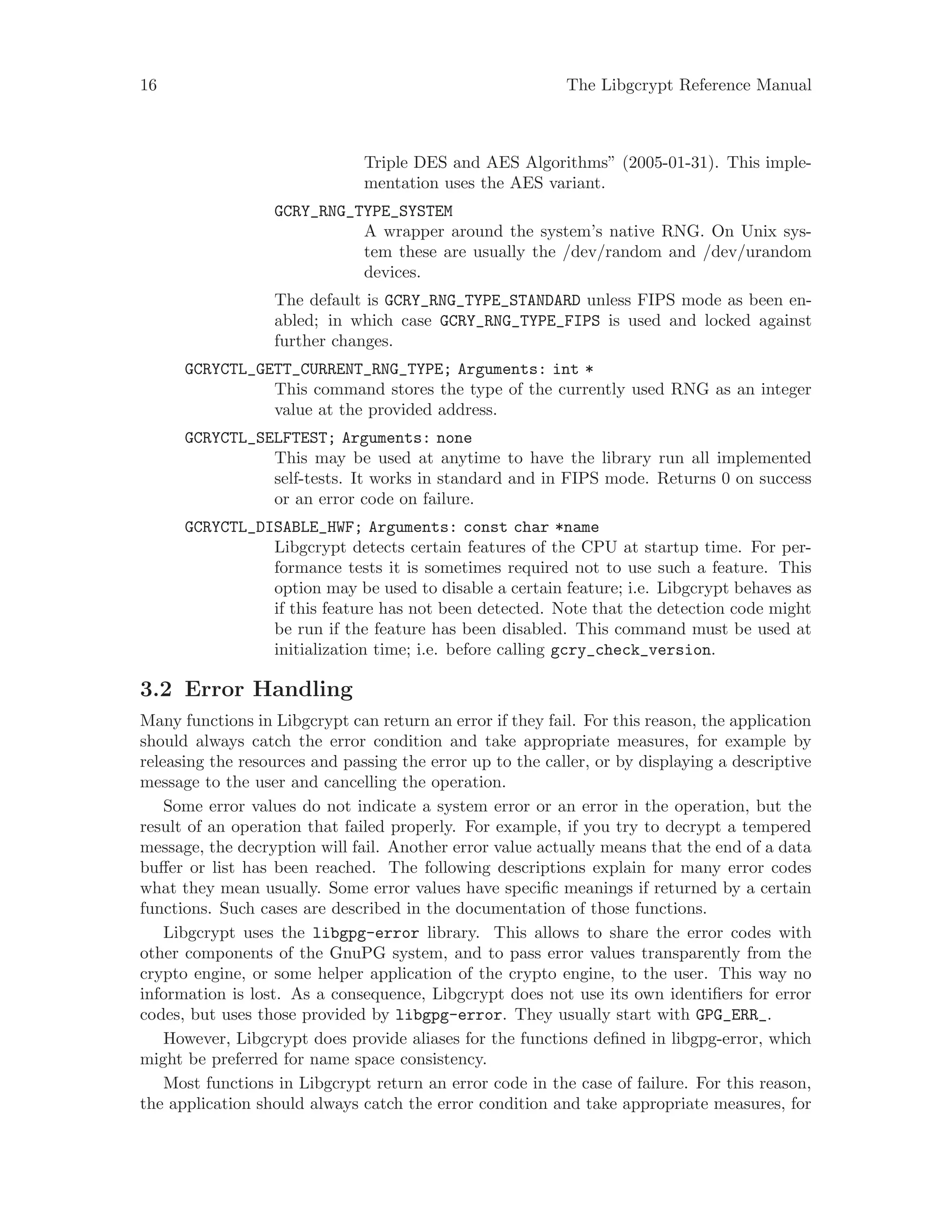
![Chapter 3: Generalities 17
example by releasing the resources and passing the error up to the caller, or by displaying
a descriptive message to the user and canceling the operation.
Some error values do not indicate a system error or an error in the operation, but the
result of an operation that failed properly.
GnuPG components, including Libgcrypt, use an extra library named libgpg-error to
provide a common error handling scheme. For more information on libgpg-error, see the
according manual.
3.2.1 Error Values
[Data type]gcry_err_code_t
The gcry_err_code_t type is an alias for the libgpg-error type gpg_err_code_t.
The error code indicates the type of an error, or the reason why an operation failed.
A list of important error codes can be found in the next section.
[Data type]gcry_err_source_t
The gcry_err_source_t type is an alias for the libgpg-error type gpg_err_
source_t. The error source has not a precisely defined meaning. Sometimes it is
the place where the error happened, sometimes it is the place where an error was
encoded into an error value. Usually the error source will give an indication to where
to look for the problem. This is not always true, but it is attempted to achieve this
goal.
A list of important error sources can be found in the next section.
[Data type]gcry_error_t
The gcry_error_t type is an alias for the libgpg-error type gpg_error_t. An
error value like this has always two components, an error code and an error source.
Both together form the error value.
Thus, the error value can not be directly compared against an error code, but the
accessor functions described below must be used. However, it is guaranteed that only
0 is used to indicate success (GPG_ERR_NO_ERROR), and that in this case all other parts
of the error value are set to 0, too.
Note that in Libgcrypt, the error source is used purely for diagnostic purposes. Only
the error code should be checked to test for a certain outcome of a function. The
manual only documents the error code part of an error value. The error source is left
unspecified and might be anything.
[Function]gcry_err_code_t gcry_err_code (gcry error t err)
The static inline function gcry_err_code returns the gcry_err_code_t component
of the error value err. This function must be used to extract the error code from an
error value in order to compare it with the GPG_ERR_* error code macros.
[Function]gcry_err_source_t gcry_err_source (gcry error t err)
The static inline function gcry_err_source returns the gcry_err_source_t compo-
nent of the error value err. This function must be used to extract the error source
from an error value in order to compare it with the GPG_ERR_SOURCE_* error source
macros.](https://image.slidesharecdn.com/gcrypt-170906152619/75/Gcrypt-25-2048.jpg)
![18 The Libgcrypt Reference Manual
[Function]gcry_error_t gcry_err_make (gcry err source t source,
gcry err code t code)
The static inline function gcry_err_make returns the error value consisting of the
error source source and the error code code.
This function can be used in callback functions to construct an error value to return
it to the library.
[Function]gcry_error_t gcry_error (gcry err code t code)
The static inline function gcry_error returns the error value consisting of the default
error source and the error code code.
For GCRY applications, the default error source is GPG_ERR_SOURCE_USER_1. You can
define GCRY_ERR_SOURCE_DEFAULT before including ‘gcrypt.h’ to change this default.
This function can be used in callback functions to construct an error value to return
it to the library.
The libgpg-error library provides error codes for all system error numbers it knows
about. If err is an unknown error number, the error code GPG_ERR_UNKNOWN_ERRNO is used.
The following functions can be used to construct error values from system errno numbers.
[Function]gcry_error_t gcry_err_make_from_errno
(gcry err source t source, int err)
The function gcry_err_make_from_errno is like gcry_err_make, but it takes a sys-
tem error like errno instead of a gcry_err_code_t error code.
[Function]gcry_error_t gcry_error_from_errno (int err)
The function gcry_error_from_errno is like gcry_error, but it takes a system error
like errno instead of a gcry_err_code_t error code.
Sometimes you might want to map system error numbers to error codes directly, or map
an error code representing a system error back to the system error number. The following
functions can be used to do that.
[Function]gcry_err_code_t gcry_err_code_from_errno (int err)
The function gcry_err_code_from_errno returns the error code for the system error
err. If err is not a known system error, the function returns GPG_ERR_UNKNOWN_ERRNO.
[Function]int gcry_err_code_to_errno (gcry err code t err)
The function gcry_err_code_to_errno returns the system error for the error code
err. If err is not an error code representing a system error, or if this system error is
not defined on this system, the function returns 0.
3.2.2 Error Sources
The library libgpg-error defines an error source for every component of the GnuPG
system. The error source part of an error value is not well defined. As such it is mainly
useful to improve the diagnostic error message for the user.
If the error code part of an error value is 0, the whole error value will be 0. In this case
the error source part is of course GPG_ERR_SOURCE_UNKNOWN.
The list of error sources that might occur in applications using Libgcrypt is:](https://image.slidesharecdn.com/gcrypt-170906152619/75/Gcrypt-26-2048.jpg)
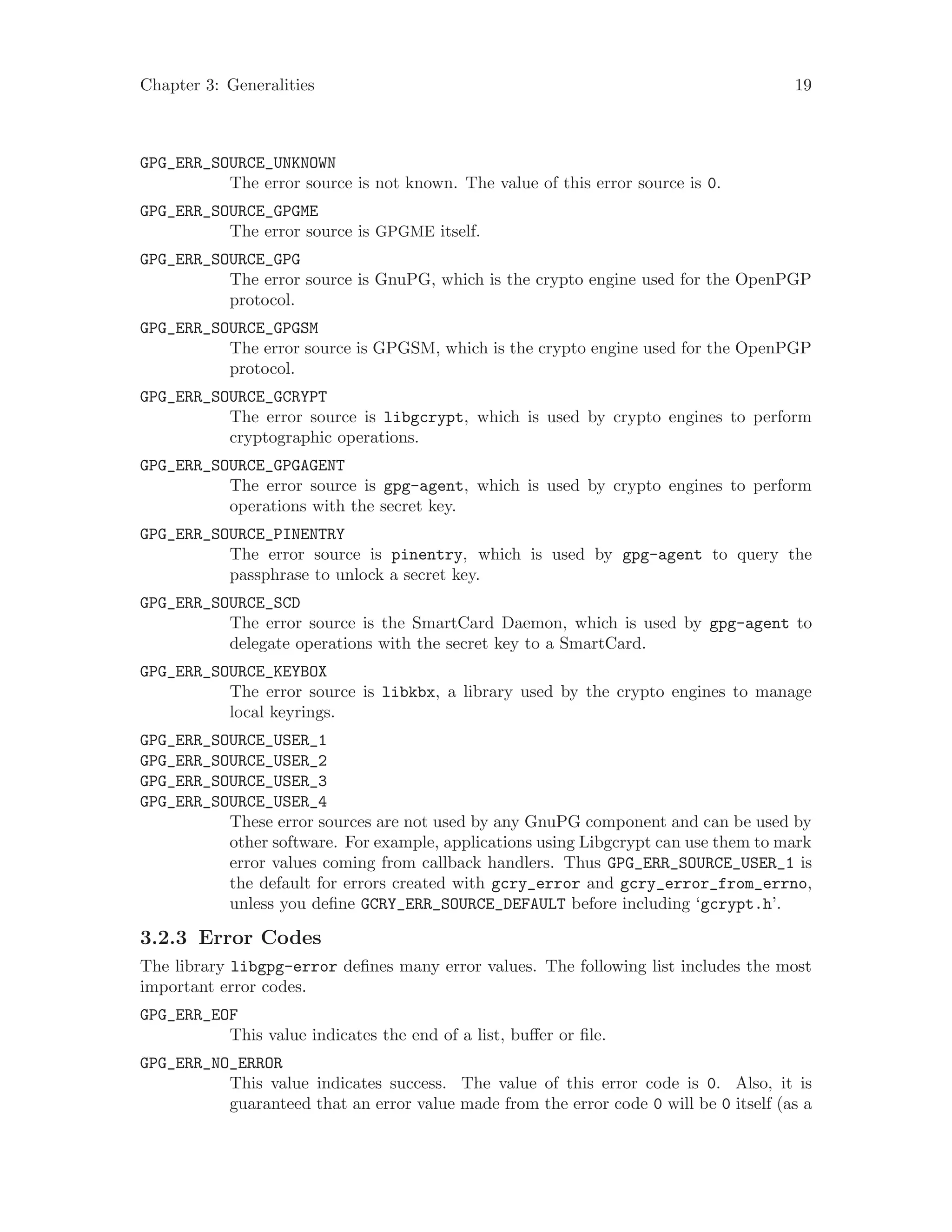
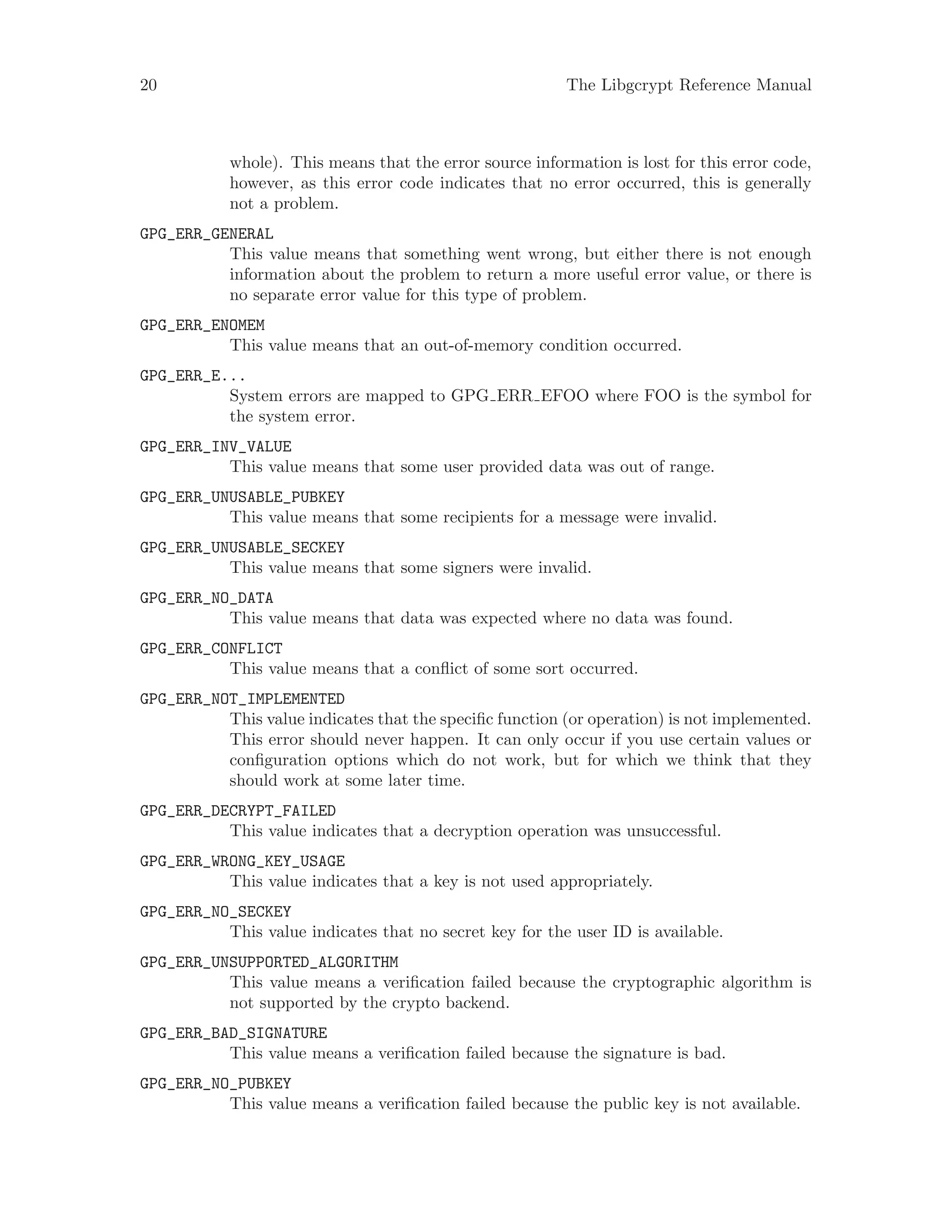
![Chapter 3: Generalities 21
GPG_ERR_NOT_OPERATIONAL
This value means that the library is not yet in state which allows to use this
function. This error code is in particular returned if Libgcrypt is operated in
FIPS mode and the internal state of the library does not yet or not anymore
allow the use of a service.
This error code is only available with newer libgpg-error versions, thus you
might see “invalid error code” when passing this to gpg_strerror. The numeric
value of this error code is 176.
GPG_ERR_USER_1
GPG_ERR_USER_2
...
GPG_ERR_USER_16
These error codes are not used by any GnuPG component and can be freely
used by other software. Applications using Libgcrypt might use them to mark
specific errors returned by callback handlers if no suitable error codes (including
the system errors) for these errors exist already.
3.2.4 Error Strings
[Function]const char * gcry_strerror (gcry error t err)
The function gcry_strerror returns a pointer to a statically allocated string con-
taining a description of the error code contained in the error value err. This string
can be used to output a diagnostic message to the user.
[Function]const char * gcry_strsource (gcry error t err)
The function gcry_strsource returns a pointer to a statically allocated string con-
taining a description of the error source contained in the error value err. This string
can be used to output a diagnostic message to the user.
The following example illustrates the use of the functions described above:
{
gcry_cipher_hd_t handle;
gcry_error_t err = 0;
err = gcry_cipher_open (&handle, GCRY_CIPHER_AES,
GCRY_CIPHER_MODE_CBC, 0);
if (err)
{
fprintf (stderr, "Failure: %s/%sn",
gcry_strsource (err),
gcry_strerror (err));
}
}](https://image.slidesharecdn.com/gcrypt-170906152619/75/Gcrypt-29-2048.jpg)

![Chapter 4: Handler Functions 23
4 Handler Functions
Libgcrypt makes it possible to install so called ‘handler functions’, which get called by
Libgcrypt in case of certain events.
4.1 Progress handler
It is often useful to retrieve some feedback while long running operations are performed.
[Data type]gcry_handler_progress_t
Progress handler functions have to be of the type gcry_handler_progress_t, which
is defined as:
void (*gcry_handler_progress_t) (void *, const char *, int, int, int)
The following function may be used to register a handler function for this purpose.
[Function]void gcry_set_progress_handler (gcry handler progress t cb, void
*cb_data)
This function installs cb as the ‘Progress handler’ function. It may be used only
during initialization. cb must be defined as follows:
void
my_progress_handler (void *cb_data, const char *what,
int printchar, int current, int total)
{
/* Do something. */
}
A description of the arguments of the progress handler function follows.
cb data The argument provided in the call to gcry_set_progress_handler.
what A string identifying the type of the progress output. The following values
for what are defined:
need_entropy
Not enough entropy is available. total holds the number of
required bytes.
wait_dev_random
Waiting to re-open a random device. total gives the number
of seconds until the next try.
primegen Values for printchar:
n Prime generated.
! Need to refresh the pool of prime numbers.
<, > Number of bits adjusted.
^ Searching for a generator.
. Fermat test on 10 candidates failed.
: Restart with a new random value.
+ Rabin Miller test passed.](https://image.slidesharecdn.com/gcrypt-170906152619/75/Gcrypt-31-2048.jpg)
![24 The Libgcrypt Reference Manual
4.2 Allocation handler
It is possible to make Libgcrypt use special memory allocation functions instead of the
built-in ones.
Memory allocation functions are of the following types:
[Data type]gcry_handler_alloc_t
This type is defined as: void *(*gcry_handler_alloc_t) (size_t n).
[Data type]gcry_handler_secure_check_t
This type is defined as: int *(*gcry_handler_secure_check_t) (const void *).
[Data type]gcry_handler_realloc_t
This type is defined as: void *(*gcry_handler_realloc_t) (void *p, size_t n).
[Data type]gcry_handler_free_t
This type is defined as: void *(*gcry_handler_free_t) (void *).
Special memory allocation functions can be installed with the following function:
[Function]void gcry_set_allocation_handler (gcry handler alloc t
func_alloc, gcry handler alloc t func_alloc_secure,
gcry handler secure check t func_secure_check, gcry handler realloc t
func_realloc, gcry handler free t func_free)
Install the provided functions and use them instead of the built-in functions for doing
memory allocation. Using this function is in general not recommended because the
standard Libgcrypt allocation functions are guaranteed to zeroize memory if needed.
This function may be used only during initialization and may not be used in fips
mode.
4.3 Error handler
The following functions may be used to register handler functions that are called by
Libgcrypt in case certain error conditions occur. They may and should be registered prior
to calling gcry_check_version.
[Data type]gcry_handler_no_mem_t
This type is defined as: int (*gcry_handler_no_mem_t) (void *, size_t,
unsigned int)
[Function]void gcry_set_outofcore_handler (gcry handler no mem t
func_no_mem, void *cb_data)
This function registers func no mem as ‘out-of-core handler’, which means that it will
be called in the case of not having enough memory available. The handler is called
with 3 arguments: The first one is the pointer cb data as set with this function, the
second is the requested memory size and the last being a flag. If bit 0 of the flag is set,
secure memory has been requested. The handler should either return true to indicate
that Libgcrypt should try again allocating memory or return false to let Libgcrypt
use its default fatal error handler.](https://image.slidesharecdn.com/gcrypt-170906152619/75/Gcrypt-32-2048.jpg)
![Chapter 4: Handler Functions 25
[Data type]gcry_handler_error_t
This type is defined as: void (*gcry_handler_error_t) (void *, int, const char
*)
[Function]void gcry_set_fatalerror_handler (gcry handler error t
func_error, void *cb_data)
This function registers func error as ‘error handler’, which means that it will be called
in error conditions.
4.4 Logging handler
[Data type]gcry_handler_log_t
This type is defined as: void (*gcry_handler_log_t) (void *, int, const char
*, va_list)
[Function]void gcry_set_log_handler (gcry handler log t func_log, void
*cb_data)
This function registers func log as ‘logging handler’, which means that it will be
called in case Libgcrypt wants to log a message. This function may and should be
used prior to calling gcry_check_version.](https://image.slidesharecdn.com/gcrypt-170906152619/75/Gcrypt-33-2048.jpg)

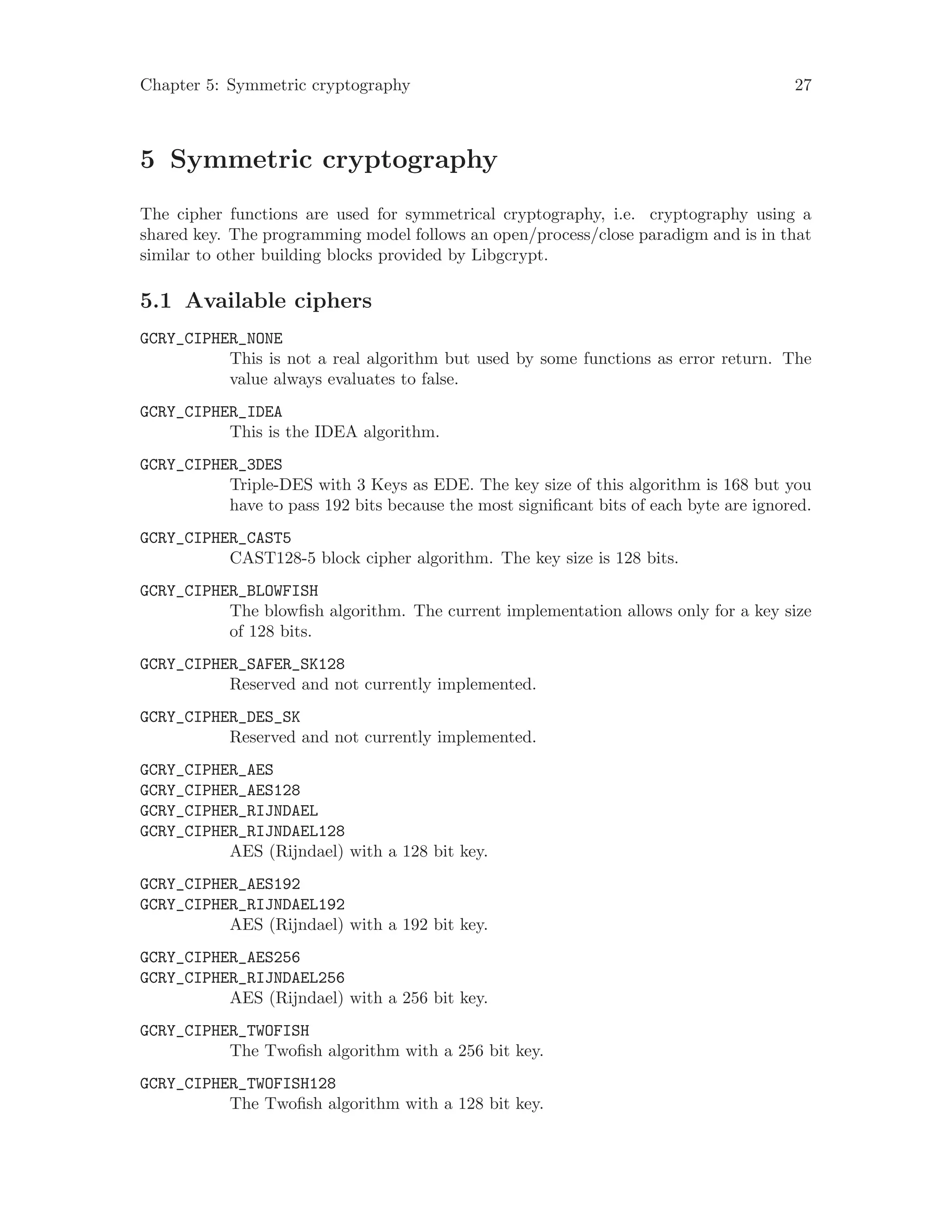
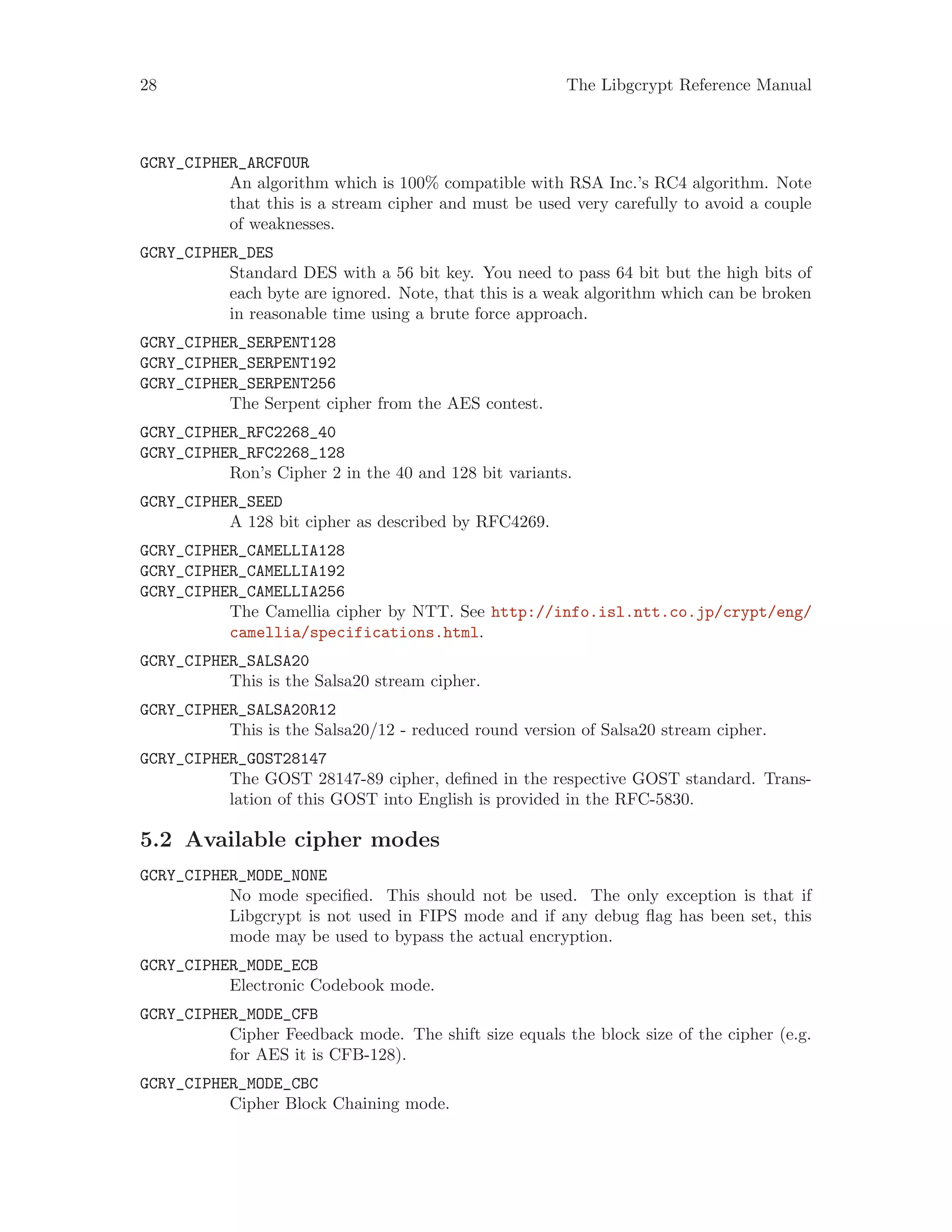
![Chapter 5: Symmetric cryptography 29
GCRY_CIPHER_MODE_STREAM
Stream mode, only to be used with stream cipher algorithms.
GCRY_CIPHER_MODE_OFB
Output Feedback mode.
GCRY_CIPHER_MODE_CTR
Counter mode.
GCRY_CIPHER_MODE_AESWRAP
This mode is used to implement the AES-Wrap algorithm according to RFC-
3394. It may be used with any 128 bit block length algorithm, however the
specs require one of the 3 AES algorithms. These special conditions apply: If
gcry_cipher_setiv has not been used the standard IV is used; if it has been
used the lower 64 bit of the IV are used as the Alternative Initial Value. On
encryption the provided output buffer must be 64 bit (8 byte) larger than the
input buffer; in-place encryption is still allowed. On decryption the output
buffer may be specified 64 bit (8 byte) shorter than then input buffer. As per
specs the input length must be at least 128 bits and the length must be a
multiple of 64 bits.
GCRY_CIPHER_MODE_CCM
Counter with CBC-MAC mode is an Authenticated Encryption with Associated
Data (AEAD) block cipher mode, which is specified in ’NIST Special Publica-
tion 800-38C’ and RFC 3610.
GCRY_CIPHER_MODE_GCM
Galois/Counter Mode (GCM) is an Authenticated Encryption with Associated
Data (AEAD) block cipher mode, which is specified in ’NIST Special Publica-
tion 800-38D’.
5.3 Working with cipher handles
To use a cipher algorithm, you must first allocate an according handle. This is to be done
using the open function:
[Function]gcry_error_t gcry_cipher_open (gcry cipher hd t *hd, int algo, int
mode, unsigned int flags)
This function creates the context handle required for most of the other cipher functions
and returns a handle to it in ‘hd’. In case of an error, an according error code is
returned.
The ID of algorithm to use must be specified via algo. See See Section 5.1 [Available
ciphers], page 27, for a list of supported ciphers and the according constants.
Besides using the constants directly, the function gcry_cipher_map_name may be
used to convert the textual name of an algorithm into the according numeric ID.
The cipher mode to use must be specified via mode. See See Section 5.2 [Avail-
able cipher modes], page 28, for a list of supported cipher modes and the according
constants. Note that some modes are incompatible with some algorithms - in par-
ticular, stream mode (GCRY_CIPHER_MODE_STREAM) only works with stream ciphers.](https://image.slidesharecdn.com/gcrypt-170906152619/75/Gcrypt-37-2048.jpg)
![30 The Libgcrypt Reference Manual
The block cipher modes (GCRY_CIPHER_MODE_ECB, GCRY_CIPHER_MODE_CBC, GCRY_
CIPHER_MODE_CFB, GCRY_CIPHER_MODE_OFB and GCRY_CIPHER_MODE_CTR) will work
with any block cipher algorithm. GCRY_CIPHER_MODE_CCM and GCRY_CIPHER_MODE_
GCM modes will only work with block cipher algorithms which have the block size of
16 bytes.
The third argument flags can either be passed as 0 or as the bit-wise OR of the
following constants.
GCRY_CIPHER_SECURE
Make sure that all operations are allocated in secure memory. This is
useful when the key material is highly confidential.
GCRY_CIPHER_ENABLE_SYNC
This flag enables the CFB sync mode, which is a special feature of
Libgcrypt’s CFB mode implementation to allow for OpenPGP’s CFB
variant. See gcry_cipher_sync.
GCRY_CIPHER_CBC_CTS
Enable cipher text stealing (CTS) for the CBC mode. Cannot be used
simultaneous as GCRY CIPHER CBC MAC. CTS mode makes it pos-
sible to transform data of almost arbitrary size (only limitation is that it
must be greater than the algorithm’s block size).
GCRY_CIPHER_CBC_MAC
Compute CBC-MAC keyed checksums. This is the same as CBC
mode, but only output the last block. Cannot be used simultaneous as
GCRY CIPHER CBC CTS.
Use the following function to release an existing handle:
[Function]void gcry_cipher_close (gcry cipher hd t h)
This function releases the context created by gcry_cipher_open. It also zeroises all
sensitive information associated with this cipher handle.
In order to use a handle for performing cryptographic operations, a ‘key’ has to be set
first:
[Function]gcry_error_t gcry_cipher_setkey (gcry cipher hd t h, const void
*k, size t l)
Set the key k used for encryption or decryption in the context denoted by the handle
h. The length l (in bytes) of the key k must match the required length of the algorithm
set for this context or be in the allowed range for algorithms with variable key size.
The function checks this and returns an error if there is a problem. A caller should
always check for an error.
Most crypto modes requires an initialization vector (IV), which usually is a non-secret
random string acting as a kind of salt value. The CTR mode requires a counter, which is
also similar to a salt value. To set the IV or CTR, use these functions:](https://image.slidesharecdn.com/gcrypt-170906152619/75/Gcrypt-38-2048.jpg)
![Chapter 5: Symmetric cryptography 31
[Function]gcry_error_t gcry_cipher_setiv (gcry cipher hd t h, const void *k,
size t l)
Set the initialization vector used for encryption or decryption. The vector is passed
as the buffer K of length l bytes and copied to internal data structures. The function
checks that the IV matches the requirement of the selected algorithm and mode.
This function is also used with the Salsa20 stream cipher to set or update the required
nonce. In this case it needs to be called after setting the key.
This function is also used with the AEAD cipher modes to set or update the required
nonce.
[Function]gcry_error_t gcry_cipher_setctr (gcry cipher hd t h, const void
*c, size t l)
Set the counter vector used for encryption or decryption. The counter is passed as the
buffer c of length l bytes and copied to internal data structures. The function checks
that the counter matches the requirement of the selected algorithm (i.e., it must be
the same size as the block size).
[Function]gcry_error_t gcry_cipher_reset (gcry cipher hd t h)
Set the given handle’s context back to the state it had after the last call to
gcry cipher setkey and clear the initialization vector.
Note that gcry cipher reset is implemented as a macro.
Authenticated Encryption with Associated Data (AEAD) block cipher modes require
the handling of the authentication tag and the additional authenticated data, which can be
done by using the following functions:
[Function]gcry_error_t gcry_cipher_authenticate (gcry cipher hd t h, const
void *abuf, size t abuflen)
Process the buffer abuf of length abuflen as the additional authenticated data (AAD)
for AEAD cipher modes.
[Function]gcry_error_t gcry_cipher_gettag (gcry cipher hd t h, void *tag,
size t taglen)
This function is used to read the authentication tag after encryption. The function
finalizes and outputs the authentication tag to the buffer tag of length taglen bytes.
[Function]gcry_error_t gcry_cipher_checktag (gcry cipher hd t h, const void
*tag, size t taglen)
Check the authentication tag after decryption. The authentication tag is passed
as the buffer tag of length taglen bytes and compared to internal authentication
tag computed during decryption. Error code GPG_ERR_CHECKSUM is returned if the
authentication tag in the buffer tag does not match the authentication tag calculated
during decryption.
The actual encryption and decryption is done by using one of the following functions.
They may be used as often as required to process all the data.](https://image.slidesharecdn.com/gcrypt-170906152619/75/Gcrypt-39-2048.jpg)
![32 The Libgcrypt Reference Manual
[Function]gcry_error_t gcry_cipher_encrypt (gcry cipher hd t h, unsigned
char *out, size t outsize, const unsigned char *in, size t inlen)
gcry_cipher_encrypt is used to encrypt the data. This function can either work in
place or with two buffers. It uses the cipher context already setup and described by
the handle h. There are 2 ways to use the function: If in is passed as NULL and inlen
is 0, in-place encryption of the data in out or length outsize takes place. With in
being not NULL, inlen bytes are encrypted to the buffer out which must have at least
a size of inlen. outsize must be set to the allocated size of out, so that the function
can check that there is sufficient space. Note that overlapping buffers are not allowed.
Depending on the selected algorithms and encryption mode, the length of the buffers
must be a multiple of the block size.
The function returns 0 on success or an error code.
[Function]gcry_error_t gcry_cipher_decrypt (gcry cipher hd t h, unsigned
char *out, size t outsize, const unsigned char *in, size t inlen)
gcry_cipher_decrypt is used to decrypt the data. This function can either work in
place or with two buffers. It uses the cipher context already setup and described by
the handle h. There are 2 ways to use the function: If in is passed as NULL and inlen
is 0, in-place decryption of the data in out or length outsize takes place. With in
being not NULL, inlen bytes are decrypted to the buffer out which must have at least
a size of inlen. outsize must be set to the allocated size of out, so that the function
can check that there is sufficient space. Note that overlapping buffers are not allowed.
Depending on the selected algorithms and encryption mode, the length of the buffers
must be a multiple of the block size.
The function returns 0 on success or an error code.
OpenPGP (as defined in RFC-2440) requires a special sync operation in some places.
The following function is used for this:
[Function]gcry_error_t gcry_cipher_sync (gcry cipher hd t h)
Perform the OpenPGP sync operation on context h. Note that this is a no-op unless
the context was created with the flag GCRY_CIPHER_ENABLE_SYNC
Some of the described functions are implemented as macros utilizing a catch-all control
function. This control function is rarely used directly but there is nothing which would
inhibit it:
[Function]gcry_error_t gcry_cipher_ctl (gcry cipher hd t h, int cmd, void
*buffer, size t buflen)
gcry_cipher_ctl controls various aspects of the cipher module and specific cipher
contexts. Usually some more specialized functions or macros are used for this pur-
pose. The semantics of the function and its parameters depends on the the command
cmd and the passed context handle h. Please see the comments in the source code
(src/global.c) for details.
[Function]gcry_error_t gcry_cipher_info (gcry cipher hd t h, int what, void
*buffer, size t *nbytes)
gcry_cipher_info is used to retrieve various information about a cipher context or
the cipher module in general.](https://image.slidesharecdn.com/gcrypt-170906152619/75/Gcrypt-40-2048.jpg)
![Chapter 5: Symmetric cryptography 33
Currently no information is available.
5.4 General cipher functions
To work with the algorithms, several functions are available to map algorithm names to
the internal identifiers, as well as ways to retrieve information about an algorithm or the
current cipher context.
[Function]gcry_error_t gcry_cipher_algo_info (int algo, int what, void
*buffer, size t *nbytes)
This function is used to retrieve information on a specific algorithm. You pass the
cipher algorithm ID as algo and the type of information requested as what. The
result is either returned as the return code of the function or copied to the provided
buffer whose allocated length must be available in an integer variable with the address
passed in nbytes. This variable will also receive the actual used length of the buffer.
Here is a list of supported codes for what:
GCRYCTL_GET_KEYLEN:
Return the length of the key. If the algorithm supports multiple key
lengths, the maximum supported value is returned. The length is re-
turned as number of octets (bytes) and not as number of bits in nbytes;
buffer must be zero. Note that it is usually better to use the convenience
function gcry_cipher_get_algo_keylen.
GCRYCTL_GET_BLKLEN:
Return the block length of the algorithm. The length is returned as a
number of octets in nbytes; buffer must be zero. Note that it is usually
better to use the convenience function gcry_cipher_get_algo_blklen.
GCRYCTL_TEST_ALGO:
Returns 0 when the specified algorithm is available for use. buffer and
nbytes must be zero.
[Function]size_t gcry_cipher_get_algo_keylen (algo)
This function returns length of the key for algorithm algo. If the algorithm supports
multiple key lengths, the maximum supported key length is returned. On error 0 is
returned. The key length is returned as number of octets.
This is a convenience functions which should be preferred over gcry_cipher_algo_
info because it allows for proper type checking.
[Function]size_t gcry_cipher_get_algo_blklen (int algo)
This functions returns the block-length of the algorithm algo counted in octets. On
error 0 is returned.
This is a convenience functions which should be preferred over gcry_cipher_algo_
info because it allows for proper type checking.
[Function]const char * gcry_cipher_algo_name (int algo)
gcry_cipher_algo_name returns a string with the name of the cipher algorithm algo.
If the algorithm is not known or another error occurred, the string "?" is returned.
This function should not be used to test for the availability of an algorithm.](https://image.slidesharecdn.com/gcrypt-170906152619/75/Gcrypt-41-2048.jpg)
![34 The Libgcrypt Reference Manual
[Function]int gcry_cipher_map_name (const char *name)
gcry_cipher_map_name returns the algorithm identifier for the cipher algorithm de-
scribed by the string name. If this algorithm is not available 0 is returned.
[Function]int gcry_cipher_mode_from_oid (const char *string)
Return the cipher mode associated with an ASN.1 object identifier. The object identi-
fier is expected to be in the IETF-style dotted decimal notation. The function returns
0 for an unknown object identifier or when no mode is associated with it.](https://image.slidesharecdn.com/gcrypt-170906152619/75/Gcrypt-42-2048.jpg)
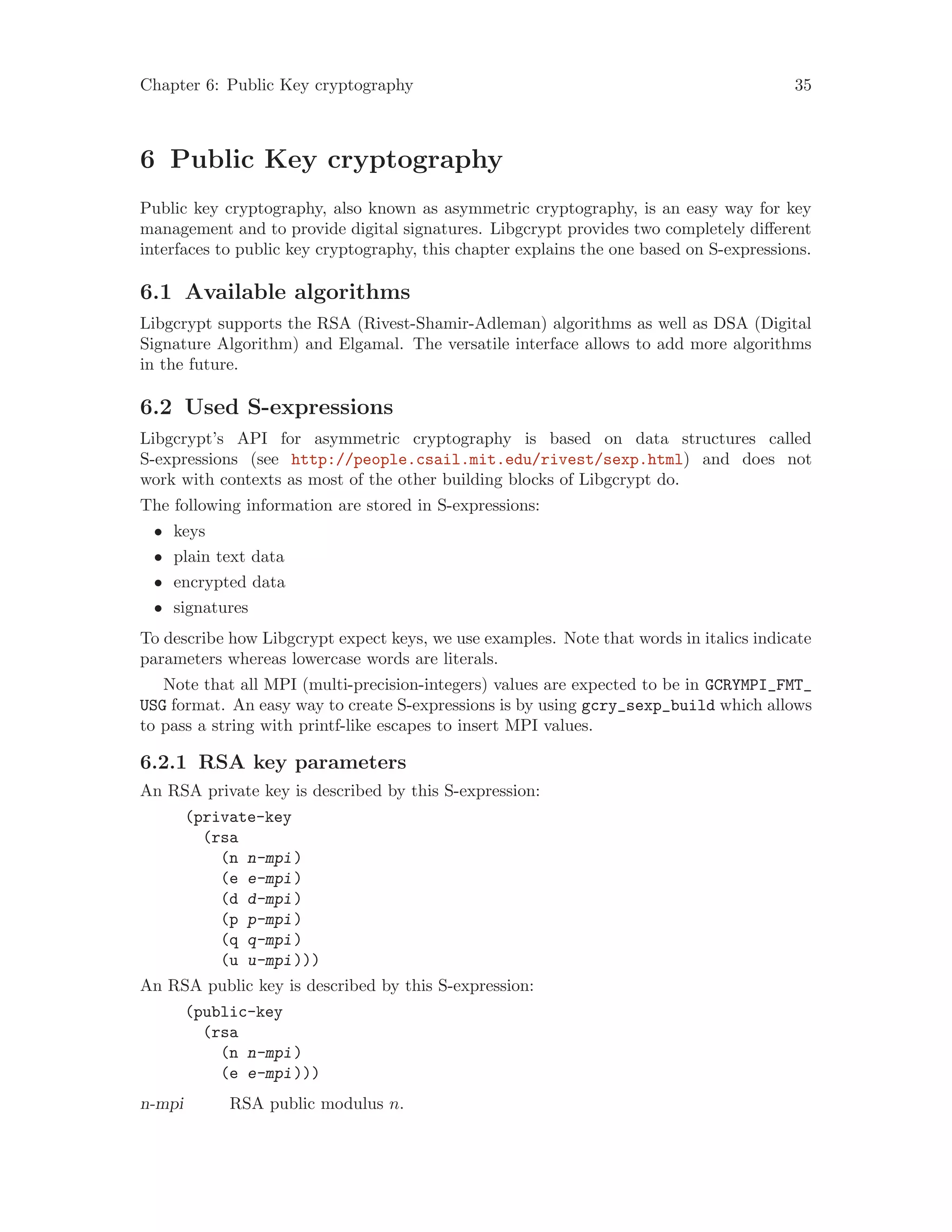
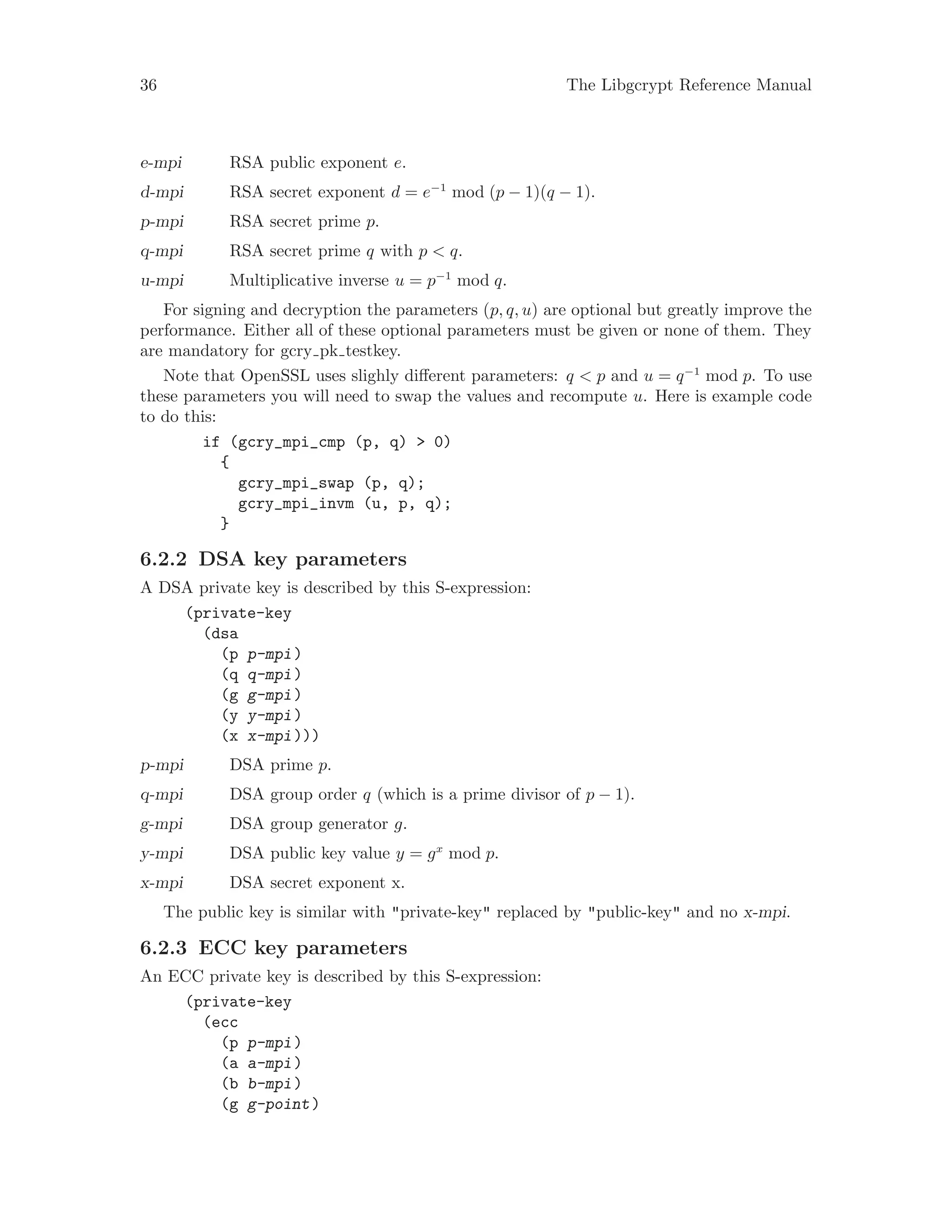
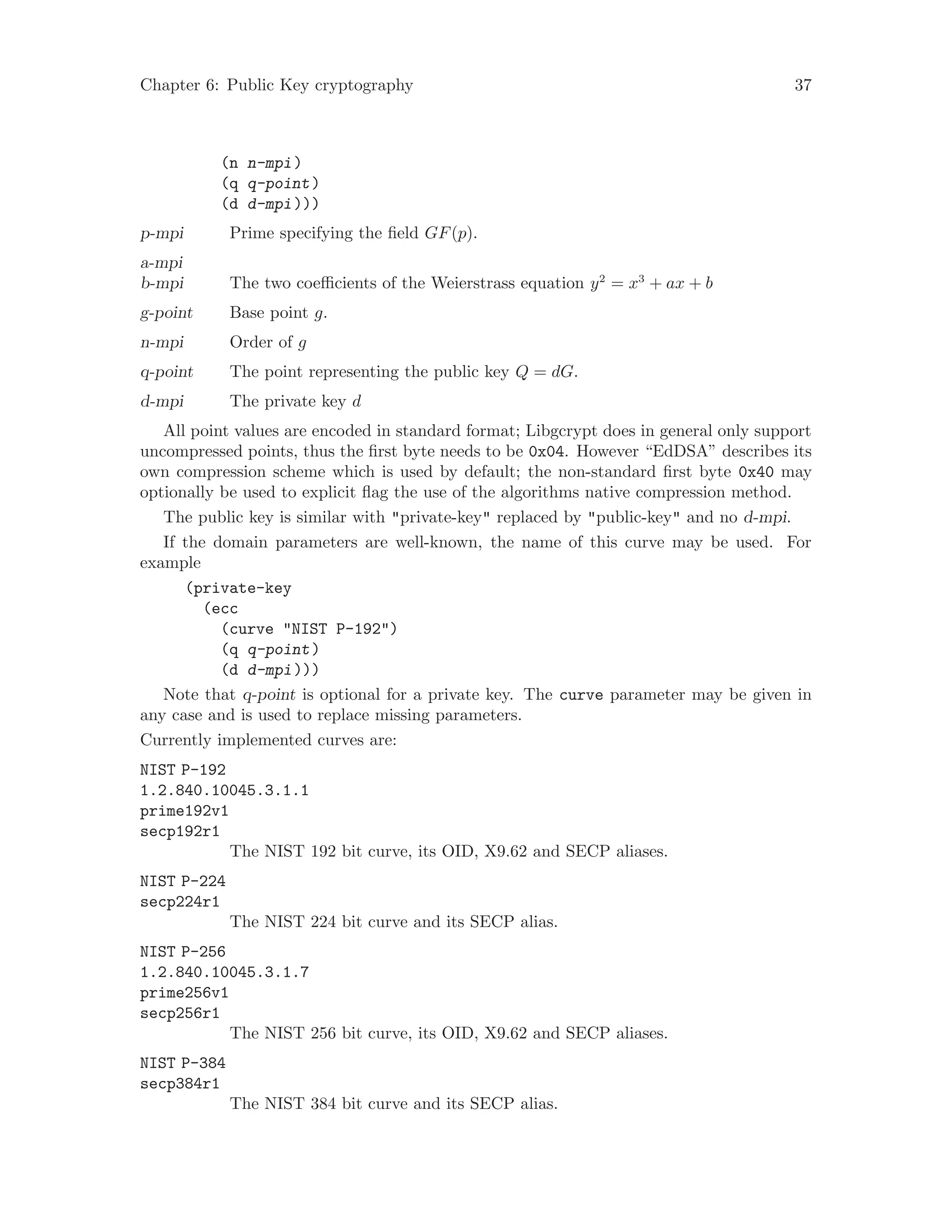
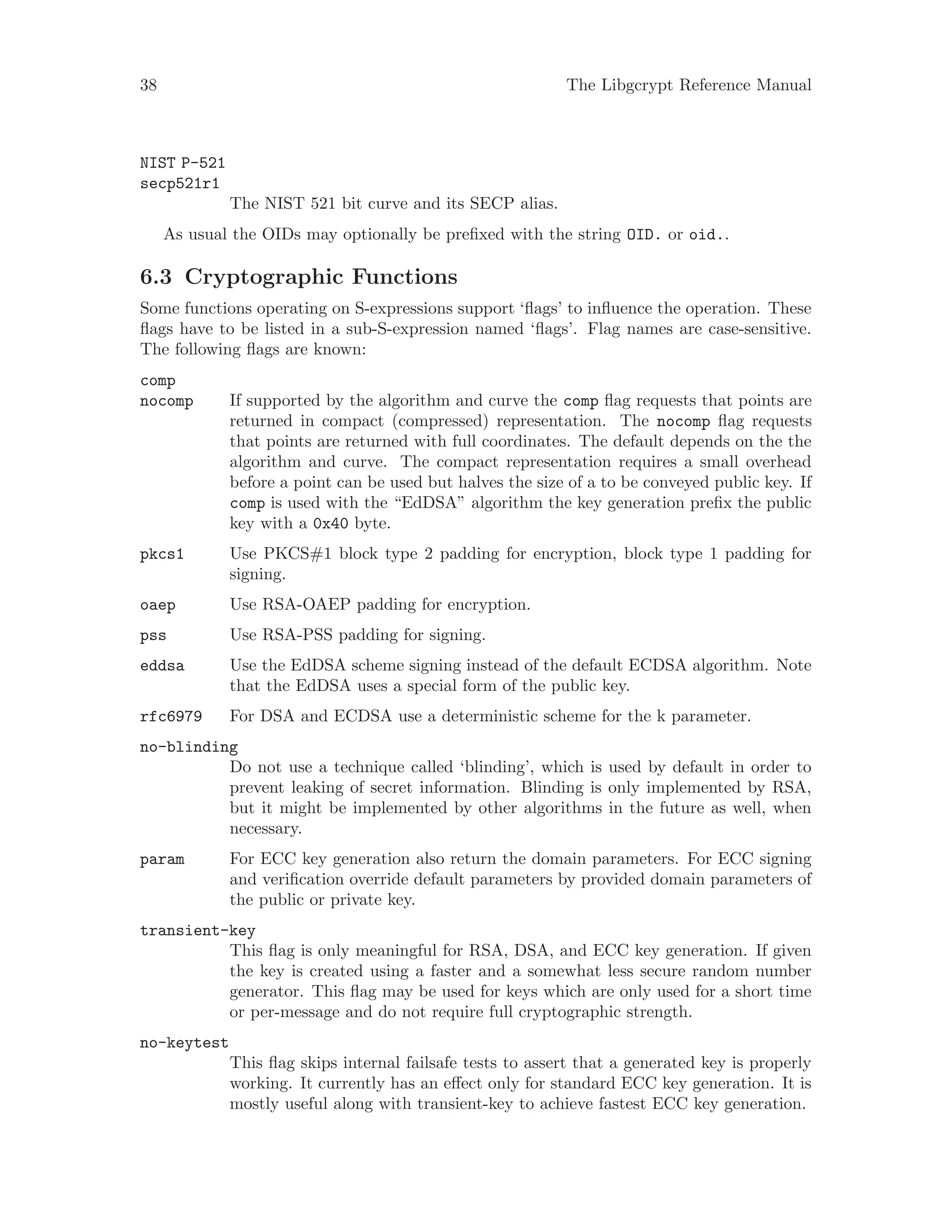
![Chapter 6: Public Key cryptography 39
use-x931 Force the use of the ANSI X9.31 key generation algorithm instead of the default
algorithm. This flag is only meaningful for RSA key generation and usually not
required. Note that this algorithm is implicitly used if either derive-parms is
given or Libgcrypt is in FIPS mode.
use-fips186
Force the use of the FIPS 186 key generation algorithm instead of the default
algorithm. This flag is only meaningful for DSA and usually not required.
Note that this algorithm is implicitly used if either derive-parms is given or
Libgcrypt is in FIPS mode. As of now FIPS 186-2 is implemented; after the
approval of FIPS 186-3 the code will be changed to implement 186-3.
use-fips186-2
Force the use of the FIPS 186-2 key generation algorithm instead of the default
algorithm. This algorithm is slightly different from FIPS 186-3 and allows only
1024 bit keys. This flag is only meaningful for DSA and only required for FIPS
testing backward compatibility.
Now that we know the key basics, we can carry on and explain how to encrypt and decrypt
data. In almost all cases the data is a random session key which is in turn used for the
actual encryption of the real data. There are 2 functions to do this:
[Function]gcry_error_t gcry_pk_encrypt (gcry sexp t *r_ciph,
gcry sexp t data, gcry sexp t pkey)
Obviously a public key must be provided for encryption. It is expected as an ap-
propriate S-expression (see above) in pkey. The data to be encrypted can either be
in the simple old format, which is a very simple S-expression consisting only of one
MPI, or it may be a more complex S-expression which also allows to specify flags for
operation, like e.g. padding rules.
If you don’t want to let Libgcrypt handle the padding, you must pass an appropriate
MPI using this expression for data:
(data
(flags raw)
(value mpi))
This has the same semantics as the old style MPI only way. MPI is the actual data,
already padded appropriate for your protocol. Most RSA based systems however use
PKCS#1 padding and so you can use this S-expression for data:
(data
(flags pkcs1)
(value block))
Here, the "flags" list has the "pkcs1" flag which let the function know that it should
provide PKCS#1 block type 2 padding. The actual data to be encrypted is passed
as a string of octets in block. The function checks that this data actually can be used
with the given key, does the padding and encrypts it.
If the function could successfully perform the encryption, the return value will be 0
and a new S-expression with the encrypted result is allocated and assigned to the
variable at the address of r ciph. The caller is responsible to release this value using](https://image.slidesharecdn.com/gcrypt-170906152619/75/Gcrypt-47-2048.jpg)
![40 The Libgcrypt Reference Manual
gcry_sexp_release. In case of an error, an error code is returned and r ciph will be
set to NULL.
The returned S-expression has this format when used with RSA:
(enc-val
(rsa
(a a-mpi)))
Where a-mpi is an MPI with the result of the RSA operation. When using the
Elgamal algorithm, the return value will have this format:
(enc-val
(elg
(a a-mpi)
(b b-mpi)))
Where a-mpi and b-mpi are MPIs with the result of the Elgamal encryption operation.
[Function]gcry_error_t gcry_pk_decrypt (gcry sexp t *r_plain,
gcry sexp t data, gcry sexp t skey)
Obviously a private key must be provided for decryption. It is expected as an appro-
priate S-expression (see above) in skey. The data to be decrypted must match the
format of the result as returned by gcry_pk_encrypt, but should be enlarged with a
flags element:
(enc-val
(flags)
(elg
(a a-mpi)
(b b-mpi)))
This function does not remove padding from the data by default. To let Libgcrypt
remove padding, give a hint in ‘flags’ telling which padding method was used when
encrypting:
(flags padding-method)
Currently padding-method is either pkcs1 for PKCS#1 block type 2 padding, or oaep
for RSA-OAEP padding.
The function returns 0 on success or an error code. The variable at the address of
r plain will be set to NULL on error or receive the decrypted value on success. The
format of r plain is a simple S-expression part (i.e. not a valid one) with just one
MPI if there was no flags element in data; if at least an empty flags is passed in
data, the format is:
(value plaintext)
Another operation commonly performed using public key cryptography is signing data.
In some sense this is even more important than encryption because digital signatures are
an important instrument for key management. Libgcrypt supports digital signatures using
2 functions, similar to the encryption functions:](https://image.slidesharecdn.com/gcrypt-170906152619/75/Gcrypt-48-2048.jpg)
![Chapter 6: Public Key cryptography 41
[Function]gcry_error_t gcry_pk_sign (gcry sexp t *r_sig, gcry sexp t data,
gcry sexp t skey)
This function creates a digital signature for data using the private key skey and place
it into the variable at the address of r sig. data may either be the simple old style
S-expression with just one MPI or a modern and more versatile S-expression which
allows to let Libgcrypt handle padding:
(data
(flags pkcs1)
(hash hash-algo block))
This example requests to sign the data in block after applying PKCS#1 block type
1 style padding. hash-algo is a string with the hash algorithm to be encoded into
the signature, this may be any hash algorithm name as supported by Libgcrypt.
Most likely, this will be "sha256" or "sha1". It is obvious that the length of block
must match the size of that message digests; the function checks that this and other
constraints are valid.
If PKCS#1 padding is not required (because the caller does already provide a padded
value), either the old format or better the following format should be used:
(data
(flags raw)
(value mpi))
Here, the data to be signed is directly given as an MPI.
For DSA the input data is expected in this format:
(data
(flags raw)
(value mpi))
Here, the data to be signed is directly given as an MPI. It is expect that this MPI is
the the hash value. For the standard DSA using a MPI is not a problem in regard to
leading zeroes because the hash value is directly used as an MPI. For better standard
conformance it would be better to explicit use a memory string (like with pkcs1)
but that is currently not supported. However, for deterministic DSA as specified in
RFC6979 this can’t be used. Instead the following input is expected.
(data
(flags rfc6979)
(hash hash-algo block))
Note that the provided hash-algo is used for the internal HMAC; it should match the
hash-algo used to create block.
The signature is returned as a newly allocated S-expression in r sig using this format
for RSA:
(sig-val
(rsa
(s s-mpi)))
Where s-mpi is the result of the RSA sign operation. For DSA the S-expression
returned is:](https://image.slidesharecdn.com/gcrypt-170906152619/75/Gcrypt-49-2048.jpg)
![42 The Libgcrypt Reference Manual
(sig-val
(dsa
(r r-mpi)
(s s-mpi)))
Where r-mpi and s-mpi are the result of the DSA sign operation.
For Elgamal signing (which is slow, yields large numbers and probably is not as
secure as the other algorithms), the same format is used with "elg" replacing "dsa";
for ECDSA signing, the same format is used with "ecdsa" replacing "dsa".
For the EdDSA algorithm (cf. Ed25515) the required input parameters are:
(data
(flags eddsa)
(hash-algo sha512)
(value message))
Note that the message may be of any length; hashing is part of the algorithm. Using
a large data block for message is not suggested; in that case the used protocol should
better require that a hash of the message is used as input to the EdDSA algorithm.
The operation most commonly used is definitely the verification of a signature. Libgcrypt
provides this function:
[Function]gcry_error_t gcry_pk_verify (gcry sexp t sig, gcry sexp t data,
gcry sexp t pkey)
This is used to check whether the signature sig matches the data. The public key
pkey must be provided to perform this verification. This function is similar in its
parameters to gcry_pk_sign with the exceptions that the public key is used instead
of the private key and that no signature is created but a signature, in a format as
created by gcry_pk_sign, is passed to the function in sig.
The result is 0 for success (i.e. the data matches the signature), or an error code where
the most relevant code is GCRY_ERR_BAD_SIGNATURE to indicate that the signature
does not match the provided data.
6.4 General public-key related Functions
A couple of utility functions are available to retrieve the length of the key, map algorithm
identifiers and perform sanity checks:
[Function]const char * gcry_pk_algo_name (int algo)
Map the public key algorithm id algo to a string representation of the algorithm name.
For unknown algorithms this functions returns the string "?". This function should
not be used to test for the availability of an algorithm.
[Function]int gcry_pk_map_name (const char *name)
Map the algorithm name to a public key algorithm Id. Returns 0 if the algorithm
name is not known.
[Function]int gcry_pk_test_algo (int algo)
Return 0 if the public key algorithm algo is available for use. Note that this is
implemented as a macro.](https://image.slidesharecdn.com/gcrypt-170906152619/75/Gcrypt-50-2048.jpg)
![Chapter 6: Public Key cryptography 43
[Function]unsigned int gcry_pk_get_nbits (gcry sexp t key)
Return what is commonly referred as the key length for the given public or private
in key.
[Function]unsigned char * gcry_pk_get_keygrip (gcry sexp t key,
unsigned char *array)
Return the so called "keygrip" which is the SHA-1 hash of the public key parameters
expressed in a way depended on the algorithm. array must either provide space for
20 bytes or be NULL. In the latter case a newly allocated array of that size is returned.
On success a pointer to the newly allocated space or to array is returned. NULL is
returned to indicate an error which is most likely an unknown algorithm or one where
a "keygrip" has not yet been defined. The function accepts public or secret keys in
key.
[Function]gcry_error_t gcry_pk_testkey (gcry sexp t key)
Return zero if the private key key is ‘sane’, an error code otherwise. Note that it is
not possible to check the ‘saneness’ of a public key.
[Function]gcry_error_t gcry_pk_algo_info (int algo, int what,
void *buffer, size t *nbytes)
Depending on the value of what return various information about the public key
algorithm with the id algo. Note that the function returns -1 on error and the actual
error code must be retrieved using the function gcry_errno. The currently defined
values for what are:
GCRYCTL_TEST_ALGO:
Return 0 if the specified algorithm is available for use. buffer must be
NULL, nbytes may be passed as NULL or point to a variable with the
required usage of the algorithm. This may be 0 for "don’t care" or the
bit-wise OR of these flags:
GCRY_PK_USAGE_SIGN
Algorithm is usable for signing.
GCRY_PK_USAGE_ENCR
Algorithm is usable for encryption.
Unless you need to test for the allowed usage, it is in general better to
use the macro gcry pk test algo instead.
GCRYCTL_GET_ALGO_USAGE:
Return the usage flags for the given algorithm. An invalid algorithm
return 0. Disabled algorithms are ignored here because we want to know
whether the algorithm is at all capable of a certain usage.
GCRYCTL_GET_ALGO_NPKEY
Return the number of elements the public key for algorithm algo consist
of. Return 0 for an unknown algorithm.
GCRYCTL_GET_ALGO_NSKEY
Return the number of elements the private key for algorithm algo consist
of. Note that this value is always larger than that of the public key.
Return 0 for an unknown algorithm.](https://image.slidesharecdn.com/gcrypt-170906152619/75/Gcrypt-51-2048.jpg)
![44 The Libgcrypt Reference Manual
GCRYCTL_GET_ALGO_NSIGN
Return the number of elements a signature created with the algorithm
algo consists of. Return 0 for an unknown algorithm or for an algorithm
not capable of creating signatures.
GCRYCTL_GET_ALGO_NENC
Return the number of elements a encrypted message created with the
algorithm algo consists of. Return 0 for an unknown algorithm or for an
algorithm not capable of encryption.
Please note that parameters not required should be passed as NULL.
[Function]gcry_error_t gcry_pk_ctl (int cmd, void *buffer, size t buflen)
This is a general purpose function to perform certain control operations. cmd controls
what is to be done. The return value is 0 for success or an error code. Currently
supported values for cmd are:
GCRYCTL_DISABLE_ALGO
Disable the algorithm given as an algorithm id in buffer. buffer must
point to an int variable with the algorithm id and buflen must have the
value sizeof (int). This fucntion is not thread safe and should thus be
used before any other threads are started.
Libgcrypt also provides a function to generate public key pairs:
[Function]gcry_error_t gcry_pk_genkey (gcry sexp t *r_key,
gcry sexp t parms)
This function create a new public key pair using information given in the S-expression
parms and stores the private and the public key in one new S-expression at the address
given by r key. In case of an error, r key is set to NULL. The return code is 0 for
success or an error code otherwise.
Here is an example for parms to create an 2048 bit RSA key:
(genkey
(rsa
(nbits 4:2048)))
To create an Elgamal key, substitute "elg" for "rsa" and to create a DSA key use
"dsa". Valid ranges for the key length depend on the algorithms; all commonly used
key lengths are supported. Currently supported parameters are:
nbits This is always required to specify the length of the key. The argument is
a string with a number in C-notation. The value should be a multiple of
8. Note that the S-expression syntax requires that a number is prefixed
with its string length; thus the 4: in the above example.
curve name
For ECC a named curve may be used instead of giving the number of
requested bits. This allows to request a specific curve to override a de-
fault selection Libgcrypt would have taken if nbits has been given. The
available names are listed with the description of the ECC public key
parameters.](https://image.slidesharecdn.com/gcrypt-170906152619/75/Gcrypt-52-2048.jpg)
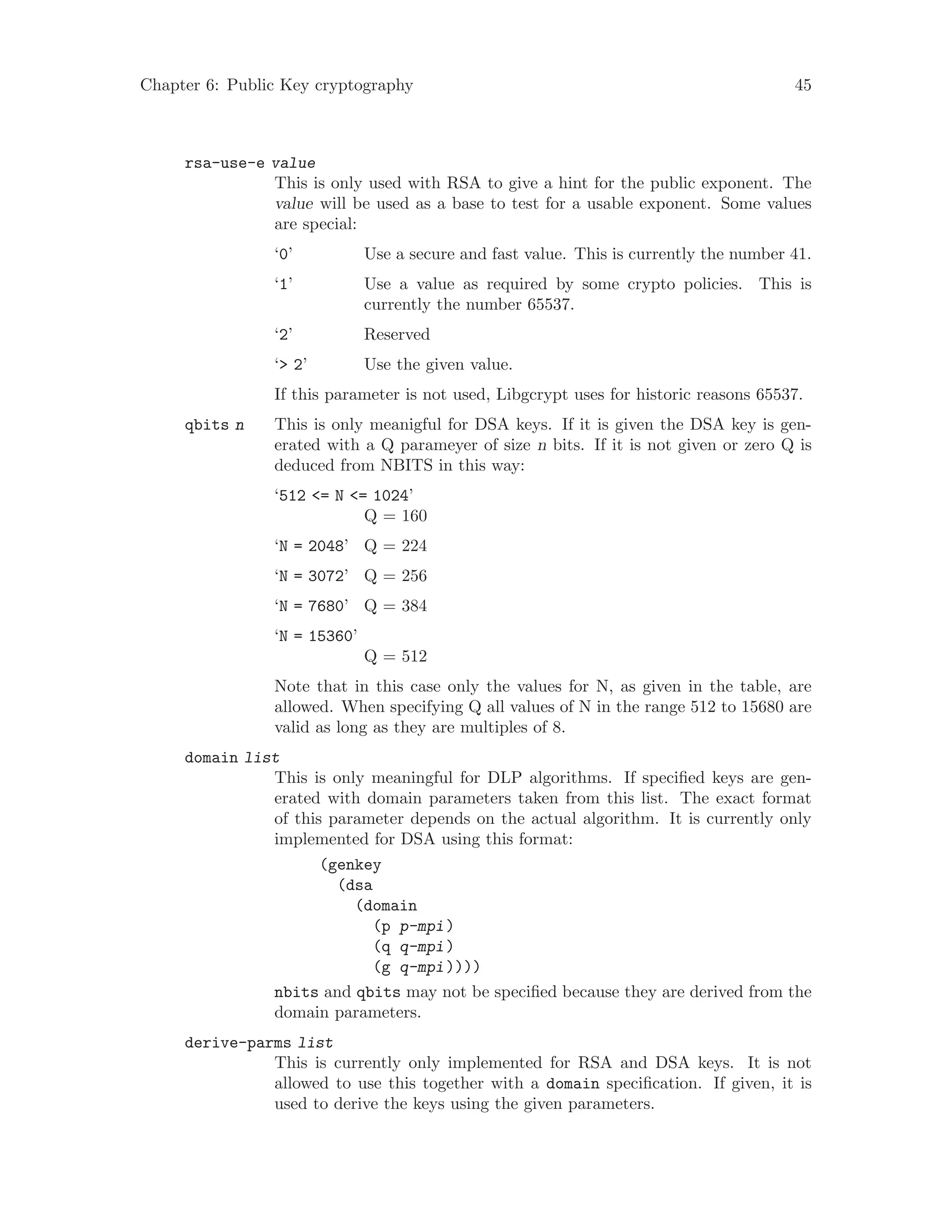
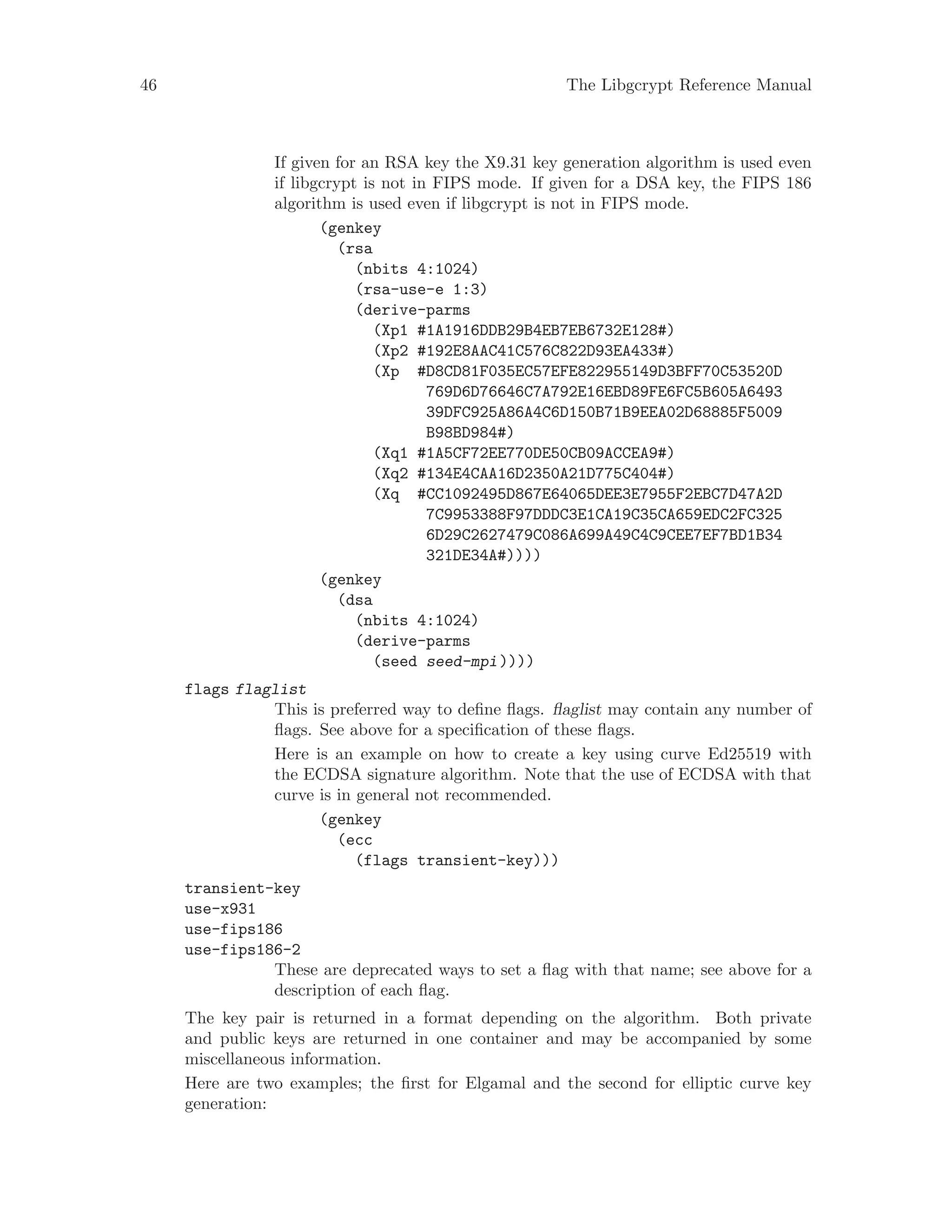
![Chapter 6: Public Key cryptography 47
(key-data
(public-key
(elg
(p p-mpi)
(g g-mpi)
(y y-mpi)))
(private-key
(elg
(p p-mpi)
(g g-mpi)
(y y-mpi)
(x x-mpi)))
(misc-key-info
(pm1-factors n1 n2 ... nn))
(key-data
(public-key
(ecc
(curve Ed25519)
(flags eddsa)
(q q-value)))
(private-key
(ecc
(curve Ed25519)
(flags eddsa)
(q q-value)
(d d-value))))
As you can see, some of the information is duplicated, but this provides an easy way
to extract either the public or the private key. Note that the order of the elements is
not defined, e.g. the private key may be stored before the public key. n1 n2 ... nn is
a list of prime numbers used to composite p-mpi; this is in general not a very useful
information and only available if the key generation algorithm provides them.
Future versions of Libgcrypt will have extended versions of the public key interfaced which
will take an additional context to allow for pre-computations, special operations, and other
optimization. As a first step a new function is introduced to help using the ECC algorithms
in new ways:
[Function]gcry_error_t gcry_pubkey_get_sexp (gcry sexp t *r_sexp,
int mode, gcry ctx t ctx)
Return an S-expression representing the context ctx. Depending on the state of that
context, the S-expression may either be a public key, a private key or any other object
used with public key operations. On success 0 is returned and a new S-expression is
stored at r sexp; on error an error code is returned and NULL is stored at r sexp.
mode must be one of:
0 Decide what to return depending on the context. For example if the
private key parameter is available a private key is returned, if not a public
key is returned.](https://image.slidesharecdn.com/gcrypt-170906152619/75/Gcrypt-55-2048.jpg)

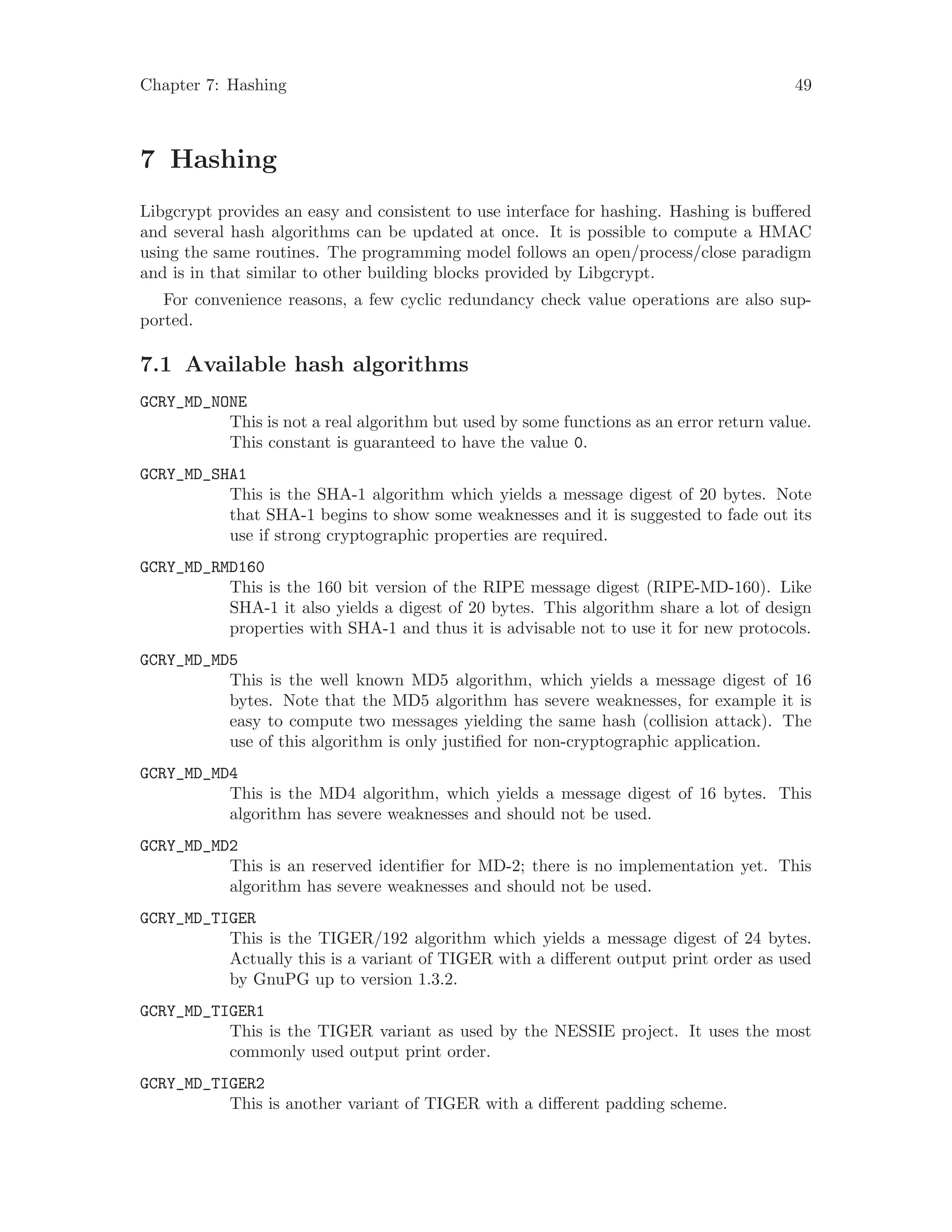
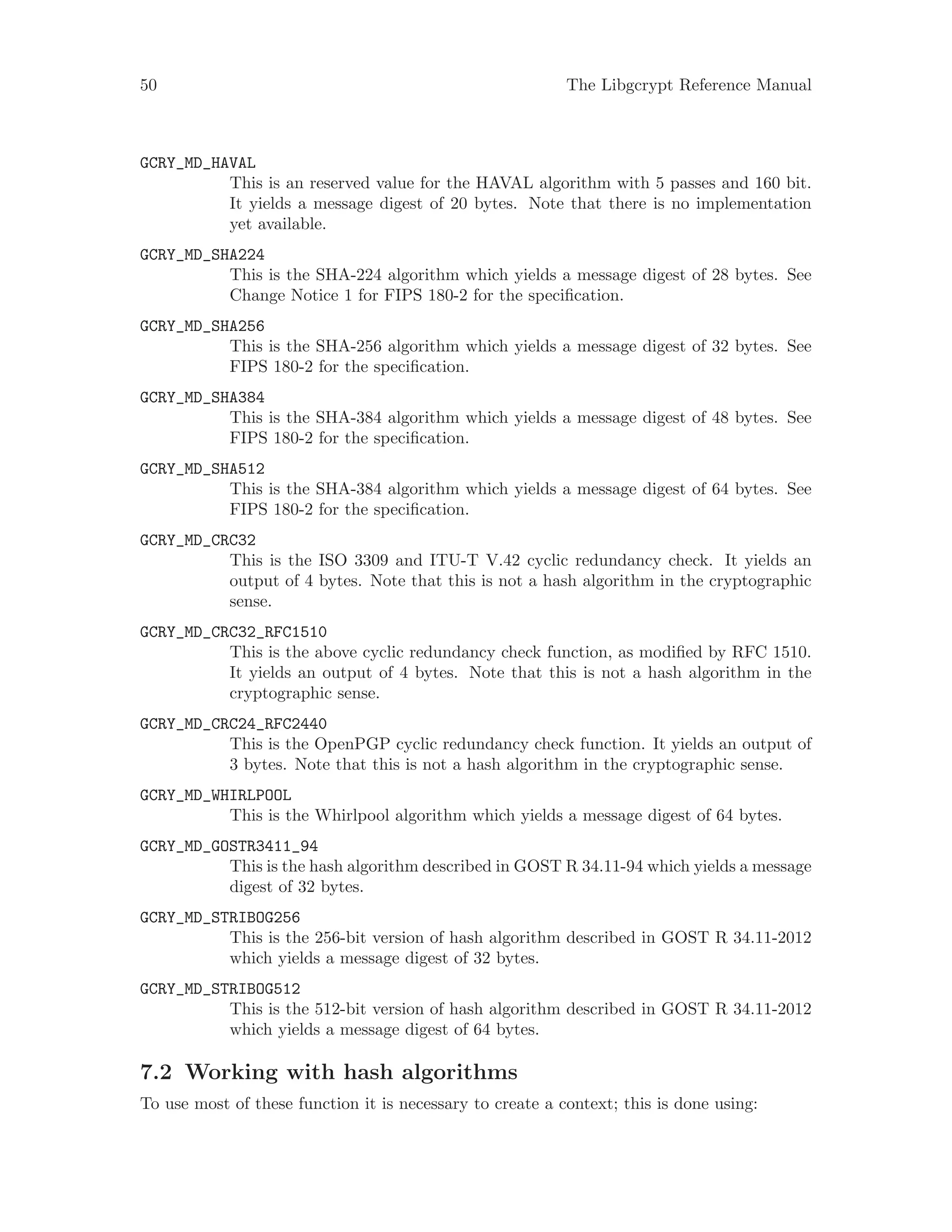
![Chapter 7: Hashing 51
[Function]gcry_error_t gcry_md_open (gcry md hd t *hd, int algo, unsigned
int flags)
Create a message digest object for algorithm algo. flags may be given as an bitwise
OR of constants described below. algo may be given as 0 if the algorithms to use are
later set using gcry_md_enable. hd is guaranteed to either receive a valid handle or
NULL.
For a list of supported algorithms, see See Section 7.1 [Available hash algorithms],
page 49.
The flags allowed for mode are:
GCRY_MD_FLAG_SECURE
Allocate all buffers and the resulting digest in "secure memory". Use this
is the hashed data is highly confidential.
GCRY_MD_FLAG_HMAC
Turn the algorithm into a HMAC message authentication algorithm. This
only works if just one algorithm is enabled for the handle. Note that the
function gcry_md_setkey must be used to set the MAC key. The size of
the MAC is equal to the message digest of the underlying hash algorithm.
If you want CBC message authentication codes based on a cipher, see See
Section 5.3 [Working with cipher handles], page 29.
GCRY_MD_FLAG_BUGEMU1
Versions of Libgcrypt before 1.6.0 had a bug in the Whirlpool code which
led to a wrong result for certain input sizes and write patterns. Using
this flag emulates that bug. This may for example be useful for applica-
tions which use Whirlpool as part of their key generation. It is strongly
suggested to use this flag only if really needed and if possible to the data
should be re-processed using the regular Whirlpool algorithm.
Note that this flag works for the entire hash context. If needed arises it
may be used to enable bug emulation for other hash algorithms. Thus
you should not use this flag for a multi-algorithm hash context.
You may use the function gcry_md_is_enabled to later check whether an algorithm
has been enabled.
If you want to calculate several hash algorithms at the same time, you have to use the
following function right after the gcry_md_open:
[Function]gcry_error_t gcry_md_enable (gcry md hd t h, int algo)
Add the message digest algorithm algo to the digest object described by handle h.
Duplicated enabling of algorithms is detected and ignored.
If the flag GCRY_MD_FLAG_HMAC was used, the key for the MAC must be set using the
function:
[Function]gcry_error_t gcry_md_setkey (gcry md hd t h, const void *key,
size t keylen)
For use with the HMAC feature, set the MAC key to the value of key of length keylen
bytes. There is no restriction on the length of the key.](https://image.slidesharecdn.com/gcrypt-170906152619/75/Gcrypt-59-2048.jpg)
![52 The Libgcrypt Reference Manual
After you are done with the hash calculation, you should release the resources by using:
[Function]void gcry_md_close (gcry md hd t h)
Release all resources of hash context h. h should not be used after a call to this
function. A NULL passed as h is ignored. The function also zeroises all sensitive
information associated with this handle.
Often you have to do several hash operations using the same algorithm. To avoid the
overhead of creating and releasing context, a reset function is provided:
[Function]void gcry_md_reset (gcry md hd t h)
Reset the current context to its initial state. This is effectively identical to a close
followed by an open and enabling all currently active algorithms.
Often it is necessary to start hashing some data and then continue to hash different data.
To avoid hashing the same data several times (which might not even be possible if the data
is received from a pipe), a snapshot of the current hash context can be taken and turned
into a new context:
[Function]gcry_error_t gcry_md_copy (gcry md hd t *handle_dst,
gcry md hd t handle_src)
Create a new digest object as an exact copy of the object described by handle han-
dle src and store it in handle dst. The context is not reset and you can continue to
hash data using this context and independently using the original context.
Now that we have prepared everything to calculate hashes, it is time to see how it is
actually done. There are two ways for this, one to update the hash with a block of memory
and one macro to update the hash by just one character. Both methods can be used on the
same hash context.
[Function]void gcry_md_write (gcry md hd t h, const void *buffer, size t
length)
Pass length bytes of the data in buffer to the digest object with handle h to update
the digest values. This function should be used for large blocks of data.
[Function]void gcry_md_putc (gcry md hd t h, int c)
Pass the byte in c to the digest object with handle h to update the digest value. This
is an efficient function, implemented as a macro to buffer the data before an actual
update.
The semantics of the hash functions do not provide for reading out intermediate message
digests because the calculation must be finalized first. This finalization may for example
include the number of bytes hashed in the message digest or some padding.
[Function]void gcry_md_final (gcry md hd t h)
Finalize the message digest calculation. This is not really needed because gcry_md_
read does this implicitly. After this has been done no further updates (by means of
gcry_md_write or gcry_md_putc are allowed. Only the first call to this function has
an effect. It is implemented as a macro.
The way to read out the calculated message digest is by using the function:](https://image.slidesharecdn.com/gcrypt-170906152619/75/Gcrypt-60-2048.jpg)
![Chapter 7: Hashing 53
[Function]unsigned char * gcry_md_read (gcry md hd t h, int algo)
gcry_md_read returns the message digest after finalizing the calculation. This func-
tion may be used as often as required but it will always return the same value for
one handle. The returned message digest is allocated within the message context
and therefore valid until the handle is released or reseted (using gcry_md_close or
gcry_md_reset. algo may be given as 0 to return the only enabled message digest or
it may specify one of the enabled algorithms. The function does return NULL if the
requested algorithm has not been enabled.
Because it is often necessary to get the message digest of blocks of memory, two fast
convenience function are available for this task:
[Function]gpg_err_code_t gcry_md_hash_buffers ( int algo,
unsigned int flags, void *digest, const gcry buffer t *iov, int iovcnt )
gcry_md_hash_buffers is a shortcut function to calculate a message digest from
several buffers. This function does not require a context and immediately returns the
message digest of of the data described by iov and iovcnt. digest must be allocated
by the caller, large enough to hold the message digest yielded by the the specified
algorithm algo. This required size may be obtained by using the function gcry_md_
get_algo_dlen.
iov is an array of buffer descriptions with iovcnt items. The caller should zero out the
structures in this array and for each array item set the fields .data to the address of
the data to be hashed, .len to number of bytes to be hashed. If .off is also set, the
data is taken starting at .off bytes from the begin of the buffer. The field .size is
not used.
The only supported flag value for flags is GCRY MD FLAG HMAC which turns this
function into a HMAC function; the first item in iov is then used as the key.
On success the function returns 0 and stores the resulting hash or MAC at digest.
[Function]void gcry_md_hash_buffer (int algo, void *digest, const void
*buffer, size t length);
gcry_md_hash_buffer is a shortcut function to calculate a message digest of a buffer.
This function does not require a context and immediately returns the message digest
of the length bytes at buffer. digest must be allocated by the caller, large enough to
hold the message digest yielded by the the specified algorithm algo. This required
size may be obtained by using the function gcry_md_get_algo_dlen.
Note that in contrast to gcry_md_hash_buffers this function will abort the process
if an unavailable algorithm is used.
Hash algorithms are identified by internal algorithm numbers (see gcry_md_open for a
list). However, in most applications they are used by names, so two functions are available
to map between string representations and hash algorithm identifiers.
[Function]const char * gcry_md_algo_name (int algo)
Map the digest algorithm id algo to a string representation of the algorithm name.
For unknown algorithms this function returns the string "?". This function should
not be used to test for the availability of an algorithm.](https://image.slidesharecdn.com/gcrypt-170906152619/75/Gcrypt-61-2048.jpg)
![54 The Libgcrypt Reference Manual
[Function]int gcry_md_map_name (const char *name)
Map the algorithm with name to a digest algorithm identifier. Returns 0 if the algo-
rithm name is not known. Names representing ASN.1 object identifiers are recognized
if the IETF dotted format is used and the OID is prefixed with either "oid." or
"OID.". For a list of supported OIDs, see the source code at ‘cipher/md.c’. This
function should not be used to test for the availability of an algorithm.
[Function]gcry_error_t gcry_md_get_asnoid (int algo, void *buffer, size t
*length)
Return an DER encoded ASN.1 OID for the algorithm algo in the user allocated
buffer. length must point to variable with the available size of buffer and receives
after return the actual size of the returned OID. The returned error code may be GPG_
ERR_TOO_SHORT if the provided buffer is to short to receive the OID; it is possible to
call the function with NULL for buffer to have it only return the required size. The
function returns 0 on success.
To test whether an algorithm is actually available for use, the following macro should
be used:
[Function]gcry_error_t gcry_md_test_algo (int algo)
The macro returns 0 if the algorithm algo is available for use.
If the length of a message digest is not known, it can be retrieved using the following
function:
[Function]unsigned int gcry_md_get_algo_dlen (int algo)
Retrieve the length in bytes of the digest yielded by algorithm algo. This is often
used prior to gcry_md_read to allocate sufficient memory for the digest.
In some situations it might be hard to remember the algorithm used for the ongoing
hashing. The following function might be used to get that information:
[Function]int gcry_md_get_algo (gcry md hd t h)
Retrieve the algorithm used with the handle h. Note that this does not work reliable
if more than one algorithm is enabled in h.
The following macro might also be useful:
[Function]int gcry_md_is_secure (gcry md hd t h)
This function returns true when the digest object h is allocated in "secure memory";
i.e. h was created with the GCRY_MD_FLAG_SECURE.
[Function]int gcry_md_is_enabled (gcry md hd t h, int algo)
This function returns true when the algorithm algo has been enabled for the digest
object h.
Tracking bugs related to hashing is often a cumbersome task which requires to add a
lot of printf statements into the code. Libgcrypt provides an easy way to avoid this. The
actual data hashed can be written to files on request.](https://image.slidesharecdn.com/gcrypt-170906152619/75/Gcrypt-62-2048.jpg)
![Chapter 7: Hashing 55
[Function]void gcry_md_debug (gcry md hd t h, const char *suffix)
Enable debugging for the digest object with handle h. This creates create files named
‘dbgmd-<n>.<string>’ while doing the actual hashing. suffix is the string part in the
filename. The number is a counter incremented for each new hashing. The data in
the file is the raw data as passed to gcry_md_write or gcry_md_putc. If NULL is used
for suffix, the debugging is stopped and the file closed. This is only rarely required
because gcry_md_close implicitly stops debugging.](https://image.slidesharecdn.com/gcrypt-170906152619/75/Gcrypt-63-2048.jpg)

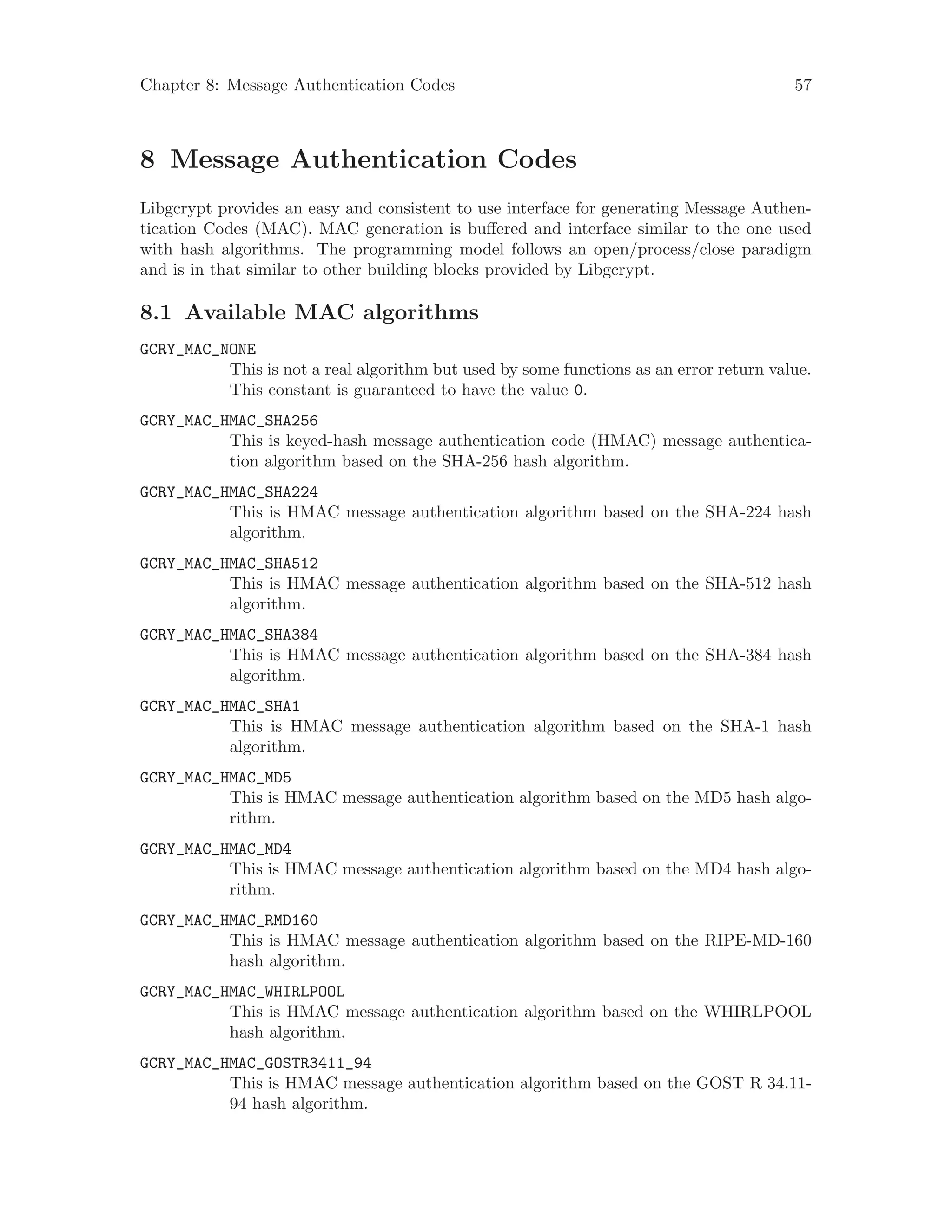
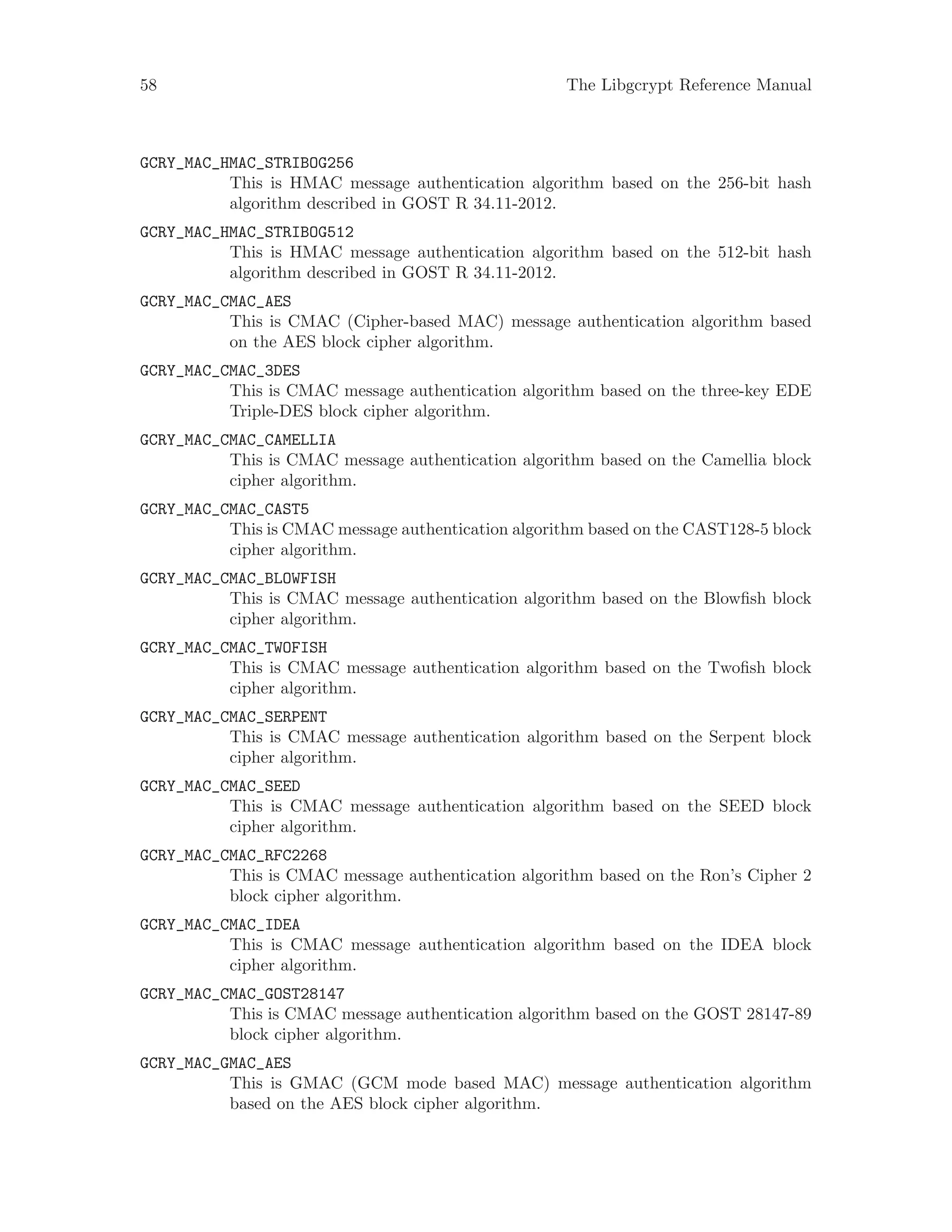
![Chapter 8: Message Authentication Codes 59
GCRY_MAC_GMAC_CAMELLIA
This is GMAC message authentication algorithm based on the Camellia block
cipher algorithm.
GCRY_MAC_GMAC_TWOFISH
This is GMAC message authentication algorithm based on the Twofish block
cipher algorithm.
GCRY_MAC_GMAC_SERPENT
This is GMAC message authentication algorithm based on the Serpent block
cipher algorithm.
GCRY_MAC_GMAC_SEED
This is GMAC message authentication algorithm based on the SEED block
cipher algorithm.
8.2 Working with MAC algorithms
To use most of these function it is necessary to create a context; this is done using:
[Function]gcry_error_t gcry_mac_open (gcry mac hd t *hd, int algo, unsigned
int flags, gcry ctx t ctx)
Create a MAC object for algorithm algo. flags may be given as an bitwise OR of
constants described below. hd is guaranteed to either receive a valid handle or NULL.
ctx is context object to associate MAC object with. ctx maybe set to NULL.
For a list of supported algorithms, see See Section 8.1 [Available MAC algorithms],
page 57.
The flags allowed for mode are:
GCRY_MAC_FLAG_SECURE
Allocate all buffers and the resulting MAC in "secure memory". Use this
if the MAC data is highly confidential.
In order to use a handle for performing MAC algorithm operations, a ‘key’ has to be set
first:
[Function]gcry_error_t gcry_mac_setkey (gcry mac hd t h, const void *key,
size t keylen)
Set the MAC key to the value of key of length keylen bytes. With HMAC algorithms,
there is no restriction on the length of the key. With CMAC algorithms, the length
of the key is restricted to those supported by the underlying block cipher.
GMAC algorithms need initialization vector to be set, which can be performed with
function:
[Function]gcry_error_t gcry_mac_setiv (gcry mac hd t h, const void *iv,
size t ivlen)
Set the IV to the value of iv of length ivlen bytes.
After you are done with the MAC calculation, you should release the resources by using:](https://image.slidesharecdn.com/gcrypt-170906152619/75/Gcrypt-67-2048.jpg)
![60 The Libgcrypt Reference Manual
[Function]void gcry_mac_close (gcry mac hd t h)
Release all resources of MAC context h. h should not be used after a call to this func-
tion. A NULL passed as h is ignored. The function also clears all sensitive information
associated with this handle.
Often you have to do several MAC operations using the same algorithm. To avoid the
overhead of creating and releasing context, a reset function is provided:
[Function]gcry_error_t gcry_mac_reset (gcry mac hd t h)
Reset the current context to its initial state. This is effectively identical to a close
followed by an open and setting same key.
Note that gcry mac reset is implemented as a macro.
Now that we have prepared everything to calculate MAC, it is time to see how it is
actually done.
[Function]gcry_error_t gcry_mac_write (gcry mac hd t h, const void *buffer,
size t length)
Pass length bytes of the data in buffer to the MAC object with handle h to update
the MAC values.
The way to read out the calculated MAC is by using the function:
[Function]gcry_error_t gcry_mac_read (gcry mac hd t h, void *buffer, size t
*length)
gcry_mac_read returns the MAC after finalizing the calculation. Function copies the
resulting MAC value to buffer of the length length. If length is larger than length of
resulting MAC value, then length of MAC is returned through length.
To compare existing MAC value with recalculated MAC, one is to use the function:
[Function]gcry_error_t gcry_mac_verify (gcry mac hd t h, void *buffer,
size t length)
gcry_mac_verify finalizes MAC calculation and compares result with length bytes
of data in buffer. Error code GPG_ERR_CHECKSUM is returned if the MAC value in the
buffer buffer does not match the MAC calculated in object h.
MAC algorithms are identified by internal algorithm numbers (see gcry_mac_open for a
list). However, in most applications they are used by names, so two functions are available
to map between string representations and MAC algorithm identifiers.
[Function]const char * gcry_mac_algo_name (int algo)
Map the MAC algorithm id algo to a string representation of the algorithm name.
For unknown algorithms this function returns the string "?". This function should
not be used to test for the availability of an algorithm.
[Function]int gcry_mac_map_name (const char *name)
Map the algorithm with name to a MAC algorithm identifier. Returns 0 if the algo-
rithm name is not known. This function should not be used to test for the availability
of an algorithm.](https://image.slidesharecdn.com/gcrypt-170906152619/75/Gcrypt-68-2048.jpg)
![Chapter 8: Message Authentication Codes 61
To test whether an algorithm is actually available for use, the following macro should
be used:
[Function]gcry_error_t gcry_mac_test_algo (int algo)
The macro returns 0 if the MAC algorithm algo is available for use.
If the length of a message digest is not known, it can be retrieved using the following
function:
[Function]unsigned int gcry_mac_get_algo_maclen (int algo)
Retrieve the length in bytes of the MAC yielded by algorithm algo. This is often used
prior to gcry_mac_read to allocate sufficient memory for the MAC value. On error
0 is returned.
[Function]unsigned int gcry_mac_get_algo_keylen (algo)
This function returns length of the key for MAC algorithm algo. If the algorithm
supports multiple key lengths, the default supported key length is returned. On error
0 is returned. The key length is returned as number of octets.](https://image.slidesharecdn.com/gcrypt-170906152619/75/Gcrypt-69-2048.jpg)

![Chapter 9: Key Derivation 63
9 Key Derivation
Libgcypt provides a general purpose function to derive keys from strings.
[Function]gpg_error_t gcry_kdf_derive ( const void *passphrase,
size t passphraselen, int algo, int subalgo, const void *salt,
size t saltlen, unsigned long iterations, size t keysize,
void *keybuffer )
Derive a key from a passphrase. keysize gives the requested size of the keys in octets.
keybuffer is a caller provided buffer filled on success with the derived key. The
input passphrase is taken from passphrase which is an arbitrary memory buffer of
passphraselen octets. algo specifies the KDF algorithm to use; see below. subalgo
specifies an algorithm used internally by the KDF algorithms; this is usually a hash
algorithm but certain KDF algorithms may use it differently. salt is a salt of length
saltlen octets, as needed by most KDF algorithms. iterations is a positive integer
parameter to most KDFs.
On success 0 is returned; on failure an error code.
Currently supported KDFs (parameter algo):
GCRY_KDF_SIMPLE_S2K
The OpenPGP simple S2K algorithm (cf. RFC4880). Its use is strongly
deprecated. salt and iterations are not needed and may be passed as
NULL/0.
GCRY_KDF_SALTED_S2K
The OpenPGP salted S2K algorithm (cf. RFC4880). Usually not used.
iterations is not needed and may be passed as 0. saltlen must be given
as 8.
GCRY_KDF_ITERSALTED_S2K
The OpenPGP iterated+salted S2K algorithm (cf. RFC4880). This is
the default for most OpenPGP applications. saltlen must be given as 8.
Note that OpenPGP defines a special encoding of the iterations; however
this function takes the plain decoded iteration count.
GCRY_KDF_PBKDF2
The PKCS#5 Passphrase Based Key Derivation Function number 2.
GCRY_KDF_SCRYPT
The SCRYPT Key Derivation Function. The subalgorithm is used to
specify the CPU/memory cost parameter N, and the number of iterations
is used for the parallelization parameter p. The block size is fixed at 8 in
the current implementation.](https://image.slidesharecdn.com/gcrypt-170906152619/75/Gcrypt-71-2048.jpg)

![Chapter 10: Random Numbers 65
10 Random Numbers
10.1 Quality of random numbers
Libgcypt offers random numbers of different quality levels:
[Data type]gcry_random_level_t
The constants for the random quality levels are of this enum type.
GCRY_WEAK_RANDOM
For all functions, except for gcry_mpi_randomize, this level maps to
GCRY STRONG RANDOM. If you do not want this, consider using
gcry_create_nonce.
GCRY_STRONG_RANDOM
Use this level for session keys and similar purposes.
GCRY_VERY_STRONG_RANDOM
Use this level for long term key material.
10.2 Retrieving random numbers
[Function]void gcry_randomize (unsigned char *buffer, size t length, enum
gcry random level level)
Fill buffer with length random bytes using a random quality as defined by level.
[Function]void * gcry_random_bytes (size t nbytes, enum gcry random level
level)
Convenience function to allocate a memory block consisting of nbytes fresh random
bytes using a random quality as defined by level.
[Function]void * gcry_random_bytes_secure (size t nbytes, enum
gcry random level level)
Convenience function to allocate a memory block consisting of nbytes fresh random
bytes using a random quality as defined by level. This function differs from gcry_
random_bytes in that the returned buffer is allocated in a “secure” area of the mem-
ory.
[Function]void gcry_create_nonce (unsigned char *buffer, size t length)
Fill buffer with length unpredictable bytes. This is commonly called a nonce and
may also be used for initialization vectors and padding. This is an extra function
nearly independent of the other random function for 3 reasons: It better protects the
regular random generator’s internal state, provides better performance and does not
drain the precious entropy pool.](https://image.slidesharecdn.com/gcrypt-170906152619/75/Gcrypt-73-2048.jpg)

![Chapter 11: S-expressions 67
11 S-expressions
S-expressions are used by the public key functions to pass complex data struc-
tures around. These LISP like objects are used by some cryptographic protocols
(cf. RFC-2692) and Libgcrypt provides functions to parse and construct them.
For detailed information, see Ron Rivest, code and description of S-expressions,
http://theory.lcs.mit.edu/~rivest/sexp.html.
11.1 Data types for S-expressions
[Data type]gcry_sexp_t
The gcry_sexp_t type describes an object with the Libgcrypt internal representation
of an S-expression.
11.2 Working with S-expressions
There are several functions to create an Libgcrypt S-expression object from its external
representation or from a string template. There is also a function to convert the internal
representation back into one of the external formats:
[Function]gcry_error_t gcry_sexp_new (gcry sexp t *r_sexp,
const void *buffer, size t length, int autodetect)
This is the generic function to create an new S-expression object from its external
representation in buffer of length bytes. On success the result is stored at the address
given by r sexp. With autodetect set to 0, the data in buffer is expected to be in
canonized format, with autodetect set to 1 the parses any of the defined external
formats. If buffer does not hold a valid S-expression an error code is returned and
r sexp set to NULL. Note that the caller is responsible for releasing the newly allocated
S-expression using gcry_sexp_release.
[Function]gcry_error_t gcry_sexp_create (gcry sexp t *r_sexp,
void *buffer, size t length, int autodetect, void (*freefnc)(void*))
This function is identical to gcry_sexp_new but has an extra argument freefnc, which,
when not set to NULL, is expected to be a function to release the buffer; most likely the
standard free function is used for this argument. This has the effect of transferring
the ownership of buffer to the created object in r sexp. The advantage of using this
function is that Libgcrypt might decide to directly use the provided buffer and thus
avoid extra copying.
[Function]gcry_error_t gcry_sexp_sscan (gcry sexp t *r_sexp,
size t *erroff, const char *buffer, size t length)
This is another variant of the above functions. It behaves nearly identical but provides
an erroff argument which will receive the offset into the buffer where the parsing
stopped on error.
[Function]gcry_error_t gcry_sexp_build (gcry sexp t *r_sexp,
size t *erroff, const char *format, ...)
This function creates an internal S-expression from the string template format and
stores it at the address of r sexp. If there is a parsing error, the function returns an](https://image.slidesharecdn.com/gcrypt-170906152619/75/Gcrypt-75-2048.jpg)
![68 The Libgcrypt Reference Manual
appropriate error code and stores the offset into format where the parsing stopped in
erroff. The function supports a couple of printf-like formatting characters and expects
arguments for some of these escape sequences right after format. The following format
characters are defined:
‘%m’ The next argument is expected to be of type gcry_mpi_t and a copy of
its value is inserted into the resulting S-expression. The MPI is stored as
a signed integer.
‘%M’ The next argument is expected to be of type gcry_mpi_t and a copy of
its value is inserted into the resulting S-expression. The MPI is stored as
an unsigned integer.
‘%s’ The next argument is expected to be of type char * and that string is
inserted into the resulting S-expression.
‘%d’ The next argument is expected to be of type int and its value is inserted
into the resulting S-expression.
‘%u’ The next argument is expected to be of type unsigned int and its value
is inserted into the resulting S-expression.
‘%b’ The next argument is expected to be of type int directly followed by an
argument of type char *. This represents a buffer of given length to be
inserted into the resulting S-expression.
‘%S’ The next argument is expected to be of type gcry_sexp_t and a copy of
that S-expression is embedded in the resulting S-expression. The argu-
ment needs to be a regular S-expression, starting with a parenthesis.
No other format characters are defined and would return an error. Note that the
format character ‘%%’ does not exists, because a percent sign is not a valid character
in an S-expression.
[Function]void gcry_sexp_release (gcry sexp t sexp)
Release the S-expression object sexp. If the S-expression is stored in secure memory
it explicitly zeroises that memory; note that this is done in addition to the zeroisation
always done when freeing secure memory.
The next 2 functions are used to convert the internal representation back into a regular
external S-expression format and to show the structure for debugging.
[Function]size_t gcry_sexp_sprint (gcry sexp t sexp, int mode,
char *buffer, size t maxlength)
Copies the S-expression object sexp into buffer using the format specified in mode.
maxlength must be set to the allocated length of buffer. The function returns the
actual length of valid bytes put into buffer or 0 if the provided buffer is too short.
Passing NULL for buffer returns the required length for buffer. For convenience reasons
an extra byte with value 0 is appended to the buffer.
The following formats are supported:
GCRYSEXP_FMT_DEFAULT
Returns a convenient external S-expression representation.](https://image.slidesharecdn.com/gcrypt-170906152619/75/Gcrypt-76-2048.jpg)
![Chapter 11: S-expressions 69
GCRYSEXP_FMT_CANON
Return the S-expression in canonical format.
GCRYSEXP_FMT_BASE64
Not currently supported.
GCRYSEXP_FMT_ADVANCED
Returns the S-expression in advanced format.
[Function]void gcry_sexp_dump (gcry sexp t sexp)
Dumps sexp in a format suitable for debugging to Libgcrypt’s logging stream.
Often canonical encoding is used in the external representation. The following function can
be used to check for valid encoding and to learn the length of the S-expression"
[Function]size_t gcry_sexp_canon_len (const unsigned char *buffer,
size t length, size t *erroff, int *errcode)
Scan the canonical encoded buffer with implicit length values and return the actual
length this S-expression uses. For a valid S-expression it should never return 0. If
length is not 0, the maximum length to scan is given; this can be used for syntax
checks of data passed from outside. errcode and erroff may both be passed as NULL.
There are functions to parse S-expressions and retrieve elements:
[Function]gcry_sexp_t gcry_sexp_find_token (const gcry sexp t list,
const char *token, size t toklen)
Scan the S-expression for a sublist with a type (the car of the list) matching the string
token. If toklen is not 0, the token is assumed to be raw memory of this length. The
function returns a newly allocated S-expression consisting of the found sublist or NULL
when not found.
[Function]int gcry_sexp_length (const gcry sexp t list)
Return the length of the list. For a valid S-expression this should be at least 1.
[Function]gcry_sexp_t gcry_sexp_nth (const gcry sexp t list, int number)
Create and return a new S-expression from the element with index number in list.
Note that the first element has the index 0. If there is no such element, NULL is
returned.
[Function]gcry_sexp_t gcry_sexp_car (const gcry sexp t list)
Create and return a new S-expression from the first element in list; this is called the
"type" and should always exist per S-expression specification and in general be a
string. NULL is returned in case of a problem.
[Function]gcry_sexp_t gcry_sexp_cdr (const gcry sexp t list)
Create and return a new list form all elements except for the first one. Note that this
function may return an invalid S-expression because it is not guaranteed, that the
type exists and is a string. However, for parsing a complex S-expression it might be
useful for intermediate lists. Returns NULL on error.](https://image.slidesharecdn.com/gcrypt-170906152619/75/Gcrypt-77-2048.jpg)
![70 The Libgcrypt Reference Manual
[Function]const char * gcry_sexp_nth_data (const gcry sexp t list,
int number, size t *datalen)
This function is used to get data from a list. A pointer to the actual data with index
number is returned and the length of this data will be stored to datalen. If there
is no data at the given index or the index represents another list, NULL is returned.
Caution: The returned pointer is valid as long as list is not modified or released.
Here is an example on how to extract and print the surname (Meier) from the S-
expression ‘(Name Otto Meier (address Burgplatz 3))’:
size_t len;
const char *name;
name = gcry_sexp_nth_data (list, 2, &len);
printf ("my name is %.*sn", (int)len, name);
[Function]void * gcry_sexp_nth_buffer (const gcry sexp t list, int number,
size t *rlength)
This function is used to get data from a list. A malloced buffer with the actual data at
list index number is returned and the length of this buffer will be stored to rlength.
If there is no data at the given index or the index represents another list, NULL is
returned. The caller must release the result using gcry_free.
Here is an example on how to extract and print the CRC value from the S-expression
‘(hash crc32 #23ed00d7)’:
size_t len;
char *value;
value = gcry_sexp_nth_buffer (list, 2, &len);
if (value)
fwrite (value, len, 1, stdout);
gcry_free (value);
[Function]char * gcry_sexp_nth_string (gcry sexp t list, int number)
This function is used to get and convert data from a list. The data is assumed to be a
Nul terminated string. The caller must release this returned value using gcry_free.
If there is no data at the given index, the index represents a list or the value can’t be
converted to a string, NULL is returned.
[Function]gcry_mpi_t gcry_sexp_nth_mpi (gcry sexp t list, int number,
int mpifmt)
This function is used to get and convert data from a list. This data is assumed to
be an MPI stored in the format described by mpifmt and returned as a standard
Libgcrypt MPI. The caller must release this returned value using gcry_mpi_release.
If there is no data at the given index, the index represents a list or the value can’t be
converted to an MPI, NULL is returned. If you use this function to parse results of a
public key function, you most likely want to use GCRYMPI_FMT_USG.](https://image.slidesharecdn.com/gcrypt-170906152619/75/Gcrypt-78-2048.jpg)
![Chapter 11: S-expressions 71
[Function]gpg_error_t gcry_sexp_extract_param ( gcry sexp t sexp,
const char *path, const char *list, ...)
Extract parameters from an S-expression using a list of parameter names. The names
of these parameters are specified in LIST. White space between the parameter names
are ignored. Some special characters may be given to control the conversion:
‘+’ Switch to unsigned integer format (GCRYMPI FMT USG). This is the
default mode.
‘-’ Switch to standard signed format (GCRYMPI FMT STD).
‘/’ Switch to opaque MPI format. The resulting MPIs may not be used for
computations; see gcry_mpi_get_opaque for details.
‘&’ Switch to buffer descriptor mode. See below for details.
‘?’ If immediately following a parameter letter (no white space allowed), that
parameter is considered optional.
In general parameter names are single letters. To use a string for a parameter name,
enclose the name in single quotes.
Unless in buffer descriptor mode for each parameter name a pointer to an gcry_mpi_t
variable is expected finally followed by a NULL. For example
_gcry_sexp_extract_param (key, NULL, "n/x+e d-’foo’",
&mpi_n, &mpi_x, &mpi_e, &mpi_foo, NULL)
stores the parameter ’n’ from key as an unsigned MPI into mpi n, the parameter
’x’ as an opaque MPI into mpi x, the parameter ’e’ again as an unsigned MPI into
mpi e, and the parameter ’foo’ as a signed MPI.
path is an optional string used to locate a token. The exclamation mark separated to-
kens are used via gcry_sexp_find_token to find a start point inside the S-expression.
In buffer descriptor mode a pointer to a gcry_buffer_t descriptor is expected instead
of a pointer to an MPI. The caller may use two different operation modes here: If
the data field of the provided descriptor is NULL, the function allocates a new buffer
and stores it at data; the other fields are set accordingly with off set to 0. If data
is not NULL, the function assumes that the data, size, and off fields specify a buffer
where to but the value of the respective parameter; on return the len field receives
the number of bytes copied to that buffer; in case the buffer is too small, the function
immediately returns with an error code (and len is set to 0).
The function returns NULL on success. On error an error code is returned and the
passed MPIs are either unchanged or set to NULL.](https://image.slidesharecdn.com/gcrypt-170906152619/75/Gcrypt-79-2048.jpg)

![Chapter 12: MPI library 73
12 MPI library
Public key cryptography is based on mathematics with large numbers. To implement the
public key functions, a library for handling these large numbers is required. Because of the
general usefulness of such a library, its interface is exposed by Libgcrypt. In the context
of Libgcrypt and in most other applications, these large numbers are called MPIs (multi-
precision-integers).
12.1 Data types
[Data type]gcry_mpi_t
This type represents an object to hold an MPI.
[Data type]gcry_mpi_point_t
This type represents an object to hold a point for elliptic curve math.
12.2 Basic functions
To work with MPIs, storage must be allocated and released for the numbers. This can be
done with one of these functions:
[Function]gcry_mpi_t gcry_mpi_new (unsigned int nbits)
Allocate a new MPI object, initialize it to 0 and initially allocate enough memory
for a number of at least nbits. This pre-allocation is only a small performance issue
and not actually necessary because Libgcrypt automatically re-allocates the required
memory.
[Function]gcry_mpi_t gcry_mpi_snew (unsigned int nbits)
This is identical to gcry_mpi_new but allocates the MPI in the so called "secure
memory" which in turn will take care that all derived values will also be stored in this
"secure memory". Use this for highly confidential data like private key parameters.
[Function]gcry_mpi_t gcry_mpi_copy (const gcry mpi t a)
Create a new MPI as the exact copy of a but with the constant and immutable flags
cleared.
[Function]void gcry_mpi_release (gcry mpi t a)
Release the MPI a and free all associated resources. Passing NULL is allowed and
ignored. When a MPI stored in the "secure memory" is released, that memory gets
wiped out immediately.
The simplest operations are used to assign a new value to an MPI:
[Function]gcry_mpi_t gcry_mpi_set (gcry mpi t w, const gcry mpi t u)
Assign the value of u to w and return w. If NULL is passed for w, a new MPI is
allocated, set to the value of u and returned.
[Function]gcry_mpi_t gcry_mpi_set_ui (gcry mpi t w, unsigned long u)
Assign the value of u to w and return w. If NULL is passed for w, a new MPI is
allocated, set to the value of u and returned. This function takes an unsigned int
as type for u and thus it is only possible to set w to small values (usually up to the
word size of the CPU).](https://image.slidesharecdn.com/gcrypt-170906152619/75/Gcrypt-81-2048.jpg)
![74 The Libgcrypt Reference Manual
[Function]void gcry_mpi_swap (gcry mpi t a, gcry mpi t b)
Swap the values of a and b.
[Function]void gcry_mpi_snatch (gcry mpi t w, const gcry mpi t u)
Set u into w and release u. If w is NULL only u will be released.
[Function]void gcry_mpi_neg (gcry mpi t w, gcry mpi t u)
Set the sign of w to the negative of u.
[Function]void gcry_mpi_abs (gcry mpi t w)
Clear the sign of w.
12.3 MPI formats
The following functions are used to convert between an external representation of an MPI
and the internal one of Libgcrypt.
[Function]gcry_error_t gcry_mpi_scan (gcry mpi t *r_mpi,
enum gcry mpi format format, const unsigned char *buffer, size t buflen,
size t *nscanned)
Convert the external representation of an integer stored in buffer with a length of
buflen into a newly created MPI returned which will be stored at the address of
r mpi. For certain formats the length argument is not required and should be passed
as 0. After a successful operation the variable nscanned receives the number of bytes
actually scanned unless nscanned was given as NULL. format describes the format of
the MPI as stored in buffer:
GCRYMPI_FMT_STD
2-complement stored without a length header. Note that gcry_mpi_
print stores a 0 as a string of zero length.
GCRYMPI_FMT_PGP
As used by OpenPGP (only defined as unsigned). This is basically
GCRYMPI_FMT_STD with a 2 byte big endian length header.
GCRYMPI_FMT_SSH
As used in the Secure Shell protocol. This is GCRYMPI_FMT_STD with a 4
byte big endian header.
GCRYMPI_FMT_HEX
Stored as a string with each byte of the MPI encoded as 2 hex digits.
Negative numbers are prefix with a minus sign and in addition the high
bit is always zero to make clear that an explicit sign ist used. When using
this format, buflen must be zero.
GCRYMPI_FMT_USG
Simple unsigned integer.
Note that all of the above formats store the integer in big-endian format (MSB first).](https://image.slidesharecdn.com/gcrypt-170906152619/75/Gcrypt-82-2048.jpg)
![Chapter 12: MPI library 75
[Function]gcry_error_t gcry_mpi_print (enum gcry mpi format format,
unsigned char *buffer, size t buflen, size t *nwritten,
const gcry mpi t a)
Convert the MPI a into an external representation described by format (see above)
and store it in the provided buffer which has a usable length of at least the buflen
bytes. If nwritten is not NULL, it will receive the number of bytes actually stored in
buffer after a successful operation.
[Function]gcry_error_t gcry_mpi_aprint (enum gcry mpi format format,
unsigned char **buffer, size t *nbytes, const gcry mpi t a)
Convert the MPI a into an external representation described by format (see above)
and store it in a newly allocated buffer which address will be stored in the variable
buffer points to. The number of bytes stored in this buffer will be stored in the
variable nbytes points to, unless nbytes is NULL.
Even if nbytes is zero, the function allocates at least one byte and store a zero there.
Thus with formats GCRYMPI_FMT_STD and GCRYMPI_FMT_USG the caller may safely set
a returned length of 0 to 1 to represent a zero as a 1 byte string.
[Function]void gcry_mpi_dump (const gcry mpi t a)
Dump the value of a in a format suitable for debugging to Libgcrypt’s logging stream.
Note that one leading space but no trailing space or linefeed will be printed. It is
okay to pass NULL for a.
12.4 Calculations
Basic arithmetic operations:
[Function]void gcry_mpi_add (gcry mpi t w, gcry mpi t u, gcry mpi t v)
w = u + v.
[Function]void gcry_mpi_add_ui (gcry mpi t w, gcry mpi t u, unsigned long v)
w = u + v. Note that v is an unsigned integer.
[Function]void gcry_mpi_addm (gcry mpi t w, gcry mpi t u, gcry mpi t v,
gcry mpi t m)
w = u + v mod m.
[Function]void gcry_mpi_sub (gcry mpi t w, gcry mpi t u, gcry mpi t v)
w = u − v.
[Function]void gcry_mpi_sub_ui (gcry mpi t w, gcry mpi t u, unsigned long v)
w = u − v. v is an unsigned integer.
[Function]void gcry_mpi_subm (gcry mpi t w, gcry mpi t u, gcry mpi t v,
gcry mpi t m)
w = u − v mod m.
[Function]void gcry_mpi_mul (gcry mpi t w, gcry mpi t u, gcry mpi t v)
w = u ∗ v.](https://image.slidesharecdn.com/gcrypt-170906152619/75/Gcrypt-83-2048.jpg)
![76 The Libgcrypt Reference Manual
[Function]void gcry_mpi_mul_ui (gcry mpi t w, gcry mpi t u, unsigned long v)
w = u ∗ v. v is an unsigned integer.
[Function]void gcry_mpi_mulm (gcry mpi t w, gcry mpi t u, gcry mpi t v,
gcry mpi t m)
w = u ∗ v mod m.
[Function]void gcry_mpi_mul_2exp (gcry mpi t w, gcry mpi t u,
unsigned long e)
w = u ∗ 2e
.
[Function]void gcry_mpi_div (gcry mpi t q, gcry mpi t r,
gcry mpi t dividend, gcry mpi t divisor, int round)
q = dividend/divisor, r = dividend mod divisor. q and r may be passed as NULL.
round should be negative or 0.
[Function]void gcry_mpi_mod (gcry mpi t r, gcry mpi t dividend,
gcry mpi t divisor)
r = dividend mod divisor.
[Function]void gcry_mpi_powm (gcry mpi t w, const gcry mpi t b,
const gcry mpi t e, const gcry mpi t m)
w = be
mod m.
[Function]int gcry_mpi_gcd (gcry mpi t g, gcry mpi t a, gcry mpi t b)
Set g to the greatest common divisor of a and b. Return true if the g is 1.
[Function]int gcry_mpi_invm (gcry mpi t x, gcry mpi t a, gcry mpi t m)
Set x to the multiplicative inverse of a mod m. Return true if the inverse exists.
12.5 Comparisons
The next 2 functions are used to compare MPIs:
[Function]int gcry_mpi_cmp (const gcry mpi t u, const gcry mpi t v)
Compare the multi-precision-integers number u and v returning 0 for equality, a
positive value for u > v and a negative for u < v. If both numbers are opaque values
(cf, gcry mpi set opaque) the comparison is done by checking the bit sizes using
memcmp. If only one number is an opaque value, the opaque value is less than the
other number.
[Function]int gcry_mpi_cmp_ui (const gcry mpi t u, unsigned long v)
Compare the multi-precision-integers number u with the unsigned integer v returning
0 for equality, a positive value for u > v and a negative for u < v.
[Function]int gcry_mpi_is_neg (const gcry mpi t a)
Return 1 if a is less than zero; return 0 if zero or positive.](https://image.slidesharecdn.com/gcrypt-170906152619/75/Gcrypt-84-2048.jpg)
![Chapter 12: MPI library 77
12.6 Bit manipulations
There are a couple of functions to get information on arbitrary bits in an MPI and to set
or clear them:
[Function]unsigned int gcry_mpi_get_nbits (gcry mpi t a)
Return the number of bits required to represent a.
[Function]int gcry_mpi_test_bit (gcry mpi t a, unsigned int n)
Return true if bit number n (counting from 0) is set in a.
[Function]void gcry_mpi_set_bit (gcry mpi t a, unsigned int n)
Set bit number n in a.
[Function]void gcry_mpi_clear_bit (gcry mpi t a, unsigned int n)
Clear bit number n in a.
[Function]void gcry_mpi_set_highbit (gcry mpi t a, unsigned int n)
Set bit number n in a and clear all bits greater than n.
[Function]void gcry_mpi_clear_highbit (gcry mpi t a, unsigned int n)
Clear bit number n in a and all bits greater than n.
[Function]void gcry_mpi_rshift (gcry mpi t x, gcry mpi t a, unsigned int n)
Shift the value of a by n bits to the right and store the result in x.
[Function]void gcry_mpi_lshift (gcry mpi t x, gcry mpi t a, unsigned int n)
Shift the value of a by n bits to the left and store the result in x.
12.7 EC functions
Libgcrypt provides an API to access low level functions used by its elliptic curve imple-
mentation. These functions allow to implement elliptic curve methods for which no explicit
support is available.
[Function]gcry_mpi_point_t gcry_mpi_point_new (unsigned int nbits)
Allocate a new point object, initialize it to 0, and allocate enough memory for a points
of at least nbits. This pre-allocation yields only a small performance win and is not
really necessary because Libgcrypt automatically re-allocates the required memory.
Using 0 for nbits is usually the right thing to do.
[Function]void gcry_mpi_point_release (gcry mpi point t point)
Release point and free all associated resources. Passing NULL is allowed and ignored.
[Function]void gcry_mpi_point_get (gcry mpi t x, gcry mpi t y, gcry mpi t z,
gcry mpi point t point)
Store the projective coordinates from point into the MPIs x, y, and z. If a coordinate
is not required, NULL may be used for x, y, or z.](https://image.slidesharecdn.com/gcrypt-170906152619/75/Gcrypt-85-2048.jpg)
![78 The Libgcrypt Reference Manual
[Function]void gcry_mpi_point_snatch_get (gcry mpi t x, gcry mpi t y,
gcry mpi t z, gcry mpi point t point)
Store the projective coordinates from point into the MPIs x, y, and z. If a coordinate
is not required, NULL may be used for x, y, or z. The object point is then released.
Using this function instead of gcry_mpi_point_get and gcry_mpi_point_release
has the advantage of avoiding some extra memory allocations and copies.
[Function]gcry_mpi_point_t gcry_mpi_point_set ( gcry mpi point t point,
gcry mpi t x, gcry mpi t y, gcry mpi t z)
Store the projective coordinates from x, y, and z into point. If a coordinate is given
as NULL, the value 0 is used. If NULL is used for point a new point object is allocated
and returned. Returns point or the newly allocated point object.
[Function]gcry_mpi_point_t gcry_mpi_point_snatch_set (
gcry mpi point t point, gcry mpi t x, gcry mpi t y, gcry mpi t z)
Store the projective coordinates from x, y, and z into point. If a coordinate is given as
NULL, the value 0 is used. If NULL is used for point a new point object is allocated and
returned. The MPIs x, y, and z are released. Using this function instead of gcry_mpi_
point_set and 3 calls to gcry_mpi_release has the advantage of avoiding some extra
memory allocations and copies. Returns point or the newly allocated point object.
[Function]gpg_error_t gcry_mpi_ec_p_new (gpg ctx t *r_ctx,
gcry sexp t keyparam, const char *curvename)
Allocate a new context for elliptic curve operations. If keyparam is given it specifies
the parameters of the curve (see [ecc keyparam], page 36). If curvename is given in
addition to keyparam and the key parameters do not include a named curve reference,
the string curvename is used to fill in missing parameters. If only curvename is given,
the context is initialized for this named curve.
If a parameter specifying a point (e.g. g or q) is not found, the parser looks for a
non-encoded point by appending .x, .y, and .z to the parameter name and looking
them all up to create a point. A parameter with the suffix .z is optional and defaults
to 1.
On success the function returns 0 and stores the new context object at r ctx; this
object eventually needs to be released (see [gcry ctx release], page 85). On error the
function stores NULL at r ctx and returns an error code.
[Function]gcry_mpi_t gcry_mpi_ec_get_mpi ( const char *name,
gcry ctx t ctx, int copy)
Return the MPI with name from the context ctx. If not found NULL is returned. If
the returned MPI may later be modified, it is suggested to pass 1 to copy, so that
the function guarantees that a modifiable copy of the MPI is returned. If 0 is used
for copy, this function may return a constant flagged MPI. In any case gcry_mpi_
release needs to be called to release the result. For valid names [ecc keyparam],
page 36. If the public key q is requested but only the private key d is available, q
will be recomputed on the fly. If a point parameter is requested it is returned as an
uncompressed encoded point unless these special names are used:
q@eddsa Return an EdDSA style compressed point. This is only supported for
Twisted Edwards curves.](https://image.slidesharecdn.com/gcrypt-170906152619/75/Gcrypt-86-2048.jpg)
![Chapter 12: MPI library 79
[Function]gcry_mpi_point_t gcry_mpi_ec_get_point ( const char *name,
gcry ctx t ctx, int copy)
Return the point with name from the context ctx. If not found NULL is returned. If
the returned MPI may later be modified, it is suggested to pass 1 to copy, so that
the function guarantees that a modifiable copy of the MPI is returned. If 0 is used
for copy, this function may return a constant flagged point. In any case gcry_mpi_
point_release needs to be called to release the result. If the public key q is requested
but only the private key d is available, q will be recomputed on the fly.
[Function]gpg_error_t gcry_mpi_ec_set_mpi ( const char *name,
gcry mpi t newvalue, gcry ctx t ctx)
Store the MPI newvalue at name into the context ctx. On success 0 is returned; on
error an error code. Valid names are the MPI parameters of an elliptic curve (see
[ecc keyparam], page 36).
[Function]gpg_error_t gcry_mpi_ec_set_point ( const char *name,
gcry mpi point t newvalue, gcry ctx t ctx)
Store the point newvalue at name into the context ctx. On success 0 is returned; on
error an error code. Valid names are the point parameters of an elliptic curve (see
[ecc keyparam], page 36).
[Function]int gcry_mpi_ec_get_affine ( gcry mpi t x, gcry mpi t y,
gcry mpi point t point, gcry ctx t ctx)
Compute the affine coordinates from the projective coordinates in point and store
them into x and y. If one coordinate is not required, NULL may be passed to x or y.
ctx is the context object which has been created using gcry_mpi_ec_new. Returns 0
on success or not 0 if point is at infinity.
Note that you can use gcry_mpi_ec_set_point with the value GCRYMPI_CONST_ONE
for z to convert affine coordinates back into projective coordinates.
[Function]void gcry_mpi_ec_dup ( gcry mpi point t w, gcry mpi point t u,
gcry ctx t ctx)
Double the point u of the elliptic curve described by ctx and store the result into w.
[Function]void gcry_mpi_ec_add ( gcry mpi point t w, gcry mpi point t u,
gcry mpi point t v, gcry ctx t ctx)
Add the points u and v of the elliptic curve described by ctx and store the result into
w.
[Function]void gcry_mpi_ec_mul ( gcry mpi point t w, gcry mpi t n,
gcry mpi point t u, gcry ctx t ctx)
Multiply the point u of the elliptic curve described by ctx by n and store the result
into w.
[Function]int gcry_mpi_ec_curve_point ( gcry mpi point t point,
gcry ctx t ctx)
Return true if point is on the elliptic curve described by ctx.](https://image.slidesharecdn.com/gcrypt-170906152619/75/Gcrypt-87-2048.jpg)
![80 The Libgcrypt Reference Manual
12.8 Miscellaneous
An MPI data type is allowed to be “misused” to store an arbitrary value. Two functions
implement this kludge:
[Function]gcry_mpi_t gcry_mpi_set_opaque (gcry mpi t a, void *p,
unsigned int nbits)
Store nbits of the value p points to in a and mark a as an opaque value (i.e. an value
that can’t be used for any math calculation and is only used to store an arbitrary bit
pattern in a). Ownership of p is taken by this function and thus the user may not use
dereference the passed value anymore. It is required that them memory referenced
by p has been allocated in a way that gcry_free is able to release it.
WARNING: Never use an opaque MPI for actual math operations. The only valid
functions are gcry mpi get opaque and gcry mpi release. Use gcry mpi scan to con-
vert a string of arbitrary bytes into an MPI.
[Function]gcry_mpi_t gcry_mpi_set_opaque_copy (gcry mpi t a,
const void *p, unsigned int nbits)
Same as gcry_mpi_set_opaque but ownership of p is not taken instead a copy of p
is used.
[Function]void * gcry_mpi_get_opaque (gcry mpi t a, unsigned int *nbits)
Return a pointer to an opaque value stored in a and return its size in nbits. Note
that the returned pointer is still owned by a and that the function should never be
used for an non-opaque MPI.
Each MPI has an associated set of flags for special purposes. The currently defined flags
are:
GCRYMPI_FLAG_SECURE
Setting this flag converts a into an MPI stored in "secure memory". Clearing
this flag is not allowed.
GCRYMPI_FLAG_OPAQUE
This is an interanl flag, indicating the an opaque valuue and not an integer is
stored. This is an read-only flag; it may not be set or cleared.
GCRYMPI_FLAG_IMMUTABLE
If this flag is set, the MPI is marked as immutable. Setting or changing the value
of that MPI is ignored and an error message is logged. The flag is sometimes
useful for debugging.
GCRYMPI_FLAG_CONST
If this flag is set, the MPI is marked as a constant and as immutable Setting or
changing the value of that MPI is ignored and an error message is logged. Such
an MPI will never be deallocated and may thus be used without copying. Note
that using gcry mpi copy will return a copy of that constant with this and the
immutable flag cleared. A few commonly used constants are pre-defined and ac-
cessible using the macros GCRYMPI_CONST_ONE, GCRYMPI_CONST_TWO, GCRYMPI_
CONST_THREE, GCRYMPI_CONST_FOUR, and GCRYMPI_CONST_EIGHT.](https://image.slidesharecdn.com/gcrypt-170906152619/75/Gcrypt-88-2048.jpg)
![Chapter 12: MPI library 81
GCRYMPI_FLAG_USER1
GCRYMPI_FLAG_USER2
GCRYMPI_FLAG_USER3
GCRYMPI_FLAG_USER4
These flags are reserved for use by the application.
[Function]void gcry_mpi_set_flag (gcry mpi t a, enum gcry mpi flag flag)
Set the flag for the MPI a. The only allowed flags are GCRYMPI_FLAG_SECURE,
GCRYMPI_FLAG_IMMUTABLE, and GCRYMPI_FLAG_CONST.
[Function]void gcry_mpi_clear_flag (gcry mpi t a, enum gcry mpi flag flag)
Clear flag for the multi-precision-integers a. The only allowed flag is GCRYMPI_FLAG_
IMMUTABLE but only if GCRYMPI_FLAG_CONST is not set. If GCRYMPI_FLAG_CONST is
set, clearing GCRYMPI_FLAG_IMMUTABLE will simply be ignored.
o
[Function]int gcry_mpi_get_flag (gcry mpi t a, enum gcry mpi flag flag)
Return true if flag is set for a.
To put a random value into an MPI, the following convenience function may be used:
[Function]void gcry_mpi_randomize (gcry mpi t w, unsigned int nbits,
enum gcry random level level)
Set the multi-precision-integers w to a random non-negative number of nbits, using
random data quality of level level. In case nbits is not a multiple of a byte, nbits
is rounded up to the next byte boundary. When using a level of GCRY_WEAK_RANDOM
this function makes use of gcry_create_nonce.](https://image.slidesharecdn.com/gcrypt-170906152619/75/Gcrypt-89-2048.jpg)

![Chapter 13: Prime numbers 83
13 Prime numbers
13.1 Generation
[Function]gcry_error_t gcry_prime_generate (gcry mpi t *prime,unsigned int
prime_bits, unsigned int factor_bits, gcry mpi t **factors,
gcry prime check func t cb_func, void *cb_arg, gcry random level t
random_level, unsigned int flags)
Generate a new prime number of prime bits bits and store it in prime. If factor bits
is non-zero, one of the prime factors of (prime - 1) / 2 must be factor bits bits long.
If factors is non-zero, allocate a new, NULL-terminated array holding the prime factors
and store it in factors. flags might be used to influence the prime number generation
process.
[Function]gcry_error_t gcry_prime_group_generator (gcry mpi t *r_g,
gcry mpi t prime, gcry mpi t *factors, gcry mpi t start_g)
Find a generator for prime where the factorization of (prime-1) is in the NULL termi-
nated array factors. Return the generator as a newly allocated MPI in r g. If start g
is not NULL, use this as the start for the search.
[Function]void gcry_prime_release_factors (gcry mpi t *factors)
Convenience function to release the factors array.
13.2 Checking
[Function]gcry_error_t gcry_prime_check (gcry mpi t p, unsigned int flags)
Check whether the number p is prime. Returns zero in case p is indeed a prime,
returns GPG_ERR_NO_PRIME in case p is not a prime and a different error code in case
something went horribly wrong.](https://image.slidesharecdn.com/gcrypt-170906152619/75/Gcrypt-91-2048.jpg)

![Chapter 14: Utilities 85
14 Utilities
14.1 Memory allocation
[Function]void * gcry_malloc (size t n)
This function tries to allocate n bytes of memory. On success it returns a pointer to
the memory area, in an out-of-core condition, it returns NULL.
[Function]void * gcry_malloc_secure (size t n)
Like gcry_malloc, but uses secure memory.
[Function]void * gcry_calloc (size t n, size t m)
This function allocates a cleared block of memory (i.e. initialized with zero bytes)
long enough to contain a vector of n elements, each of size m bytes. On success it
returns a pointer to the memory block; in an out-of-core condition, it returns NULL.
[Function]void * gcry_calloc_secure (size t n, size t m)
Like gcry_calloc, but uses secure memory.
[Function]void * gcry_realloc (void *p, size t n)
This function tries to resize the memory area pointed to by p to n bytes. On success
it returns a pointer to the new memory area, in an out-of-core condition, it returns
NULL. Depending on whether the memory pointed to by p is secure memory or not,
gcry realloc tries to use secure memory as well.
[Function]void gcry_free (void *p)
Release the memory area pointed to by p.
14.2 Context management
Some function make use of a context object. As of now there are only a few math functions.
However, future versions of Libgcrypt may make more use of this context object.
[Data type]gcry_ctx_t
This type is used to refer to the general purpose context object.
[Function]void gcry_ctx_release (gcry ctx t ctx)
Release the context object ctx and all associated resources. A NULL passed as ctx is
ignored.
14.3 Buffer description
To help hashing non-contiguous areas of memory a general purpose data type is defined:
[Data type]gcry_buffer_t
This type is a structure to describe a buffer. The user should make sure that this
structure is initialized to zero. The available fields of this structure are:
.size This is either 0 for no information available or indicates the allocated
length of the buffer.](https://image.slidesharecdn.com/gcrypt-170906152619/75/Gcrypt-93-2048.jpg)

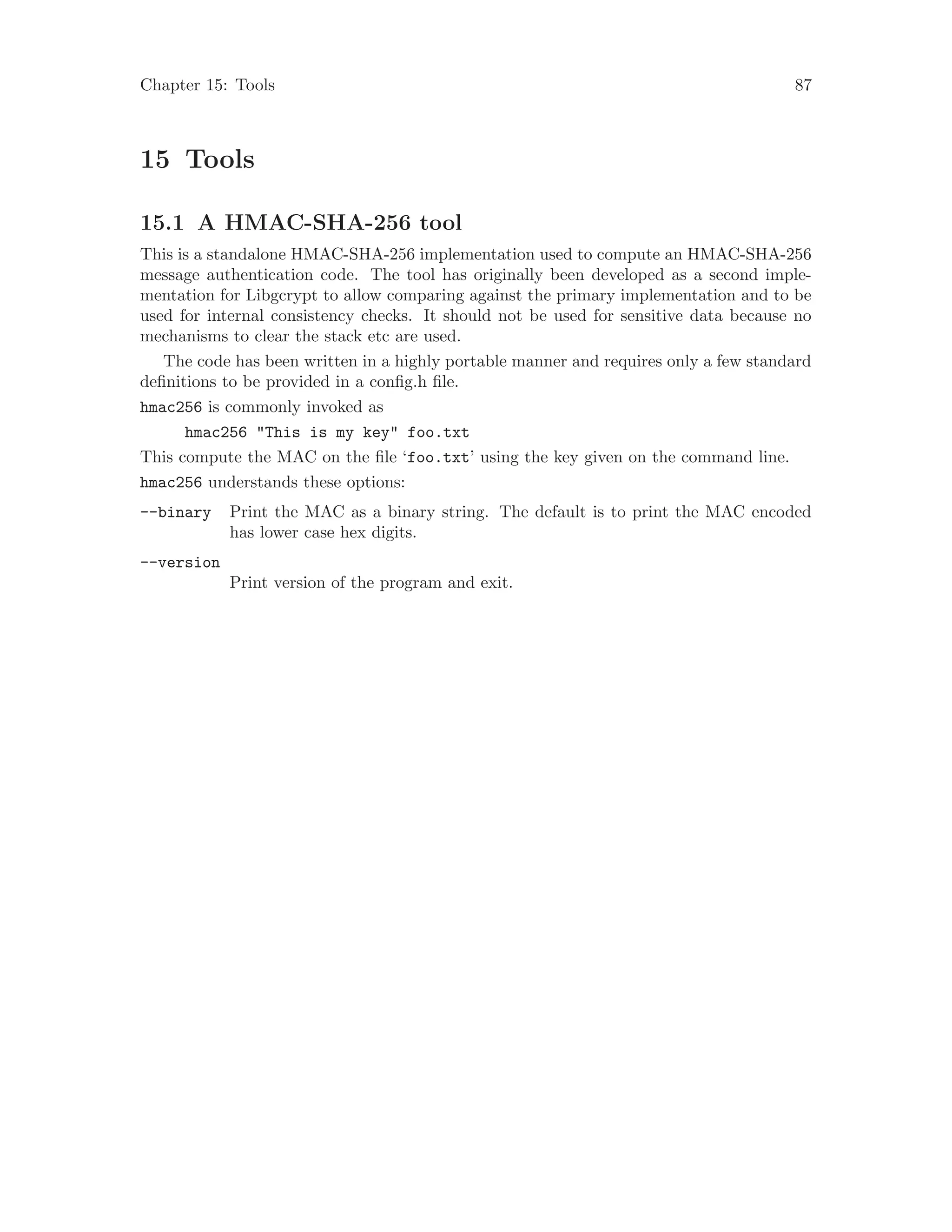

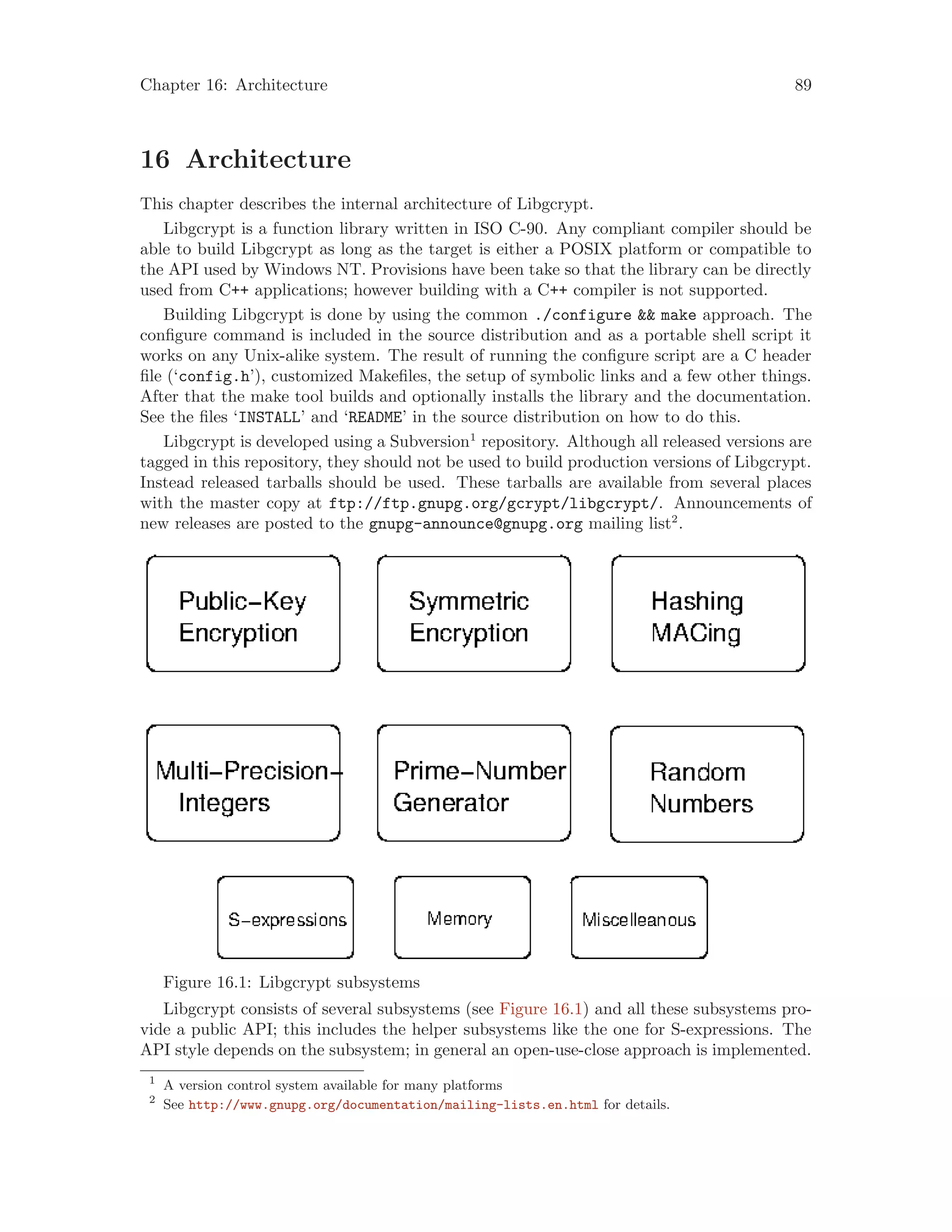
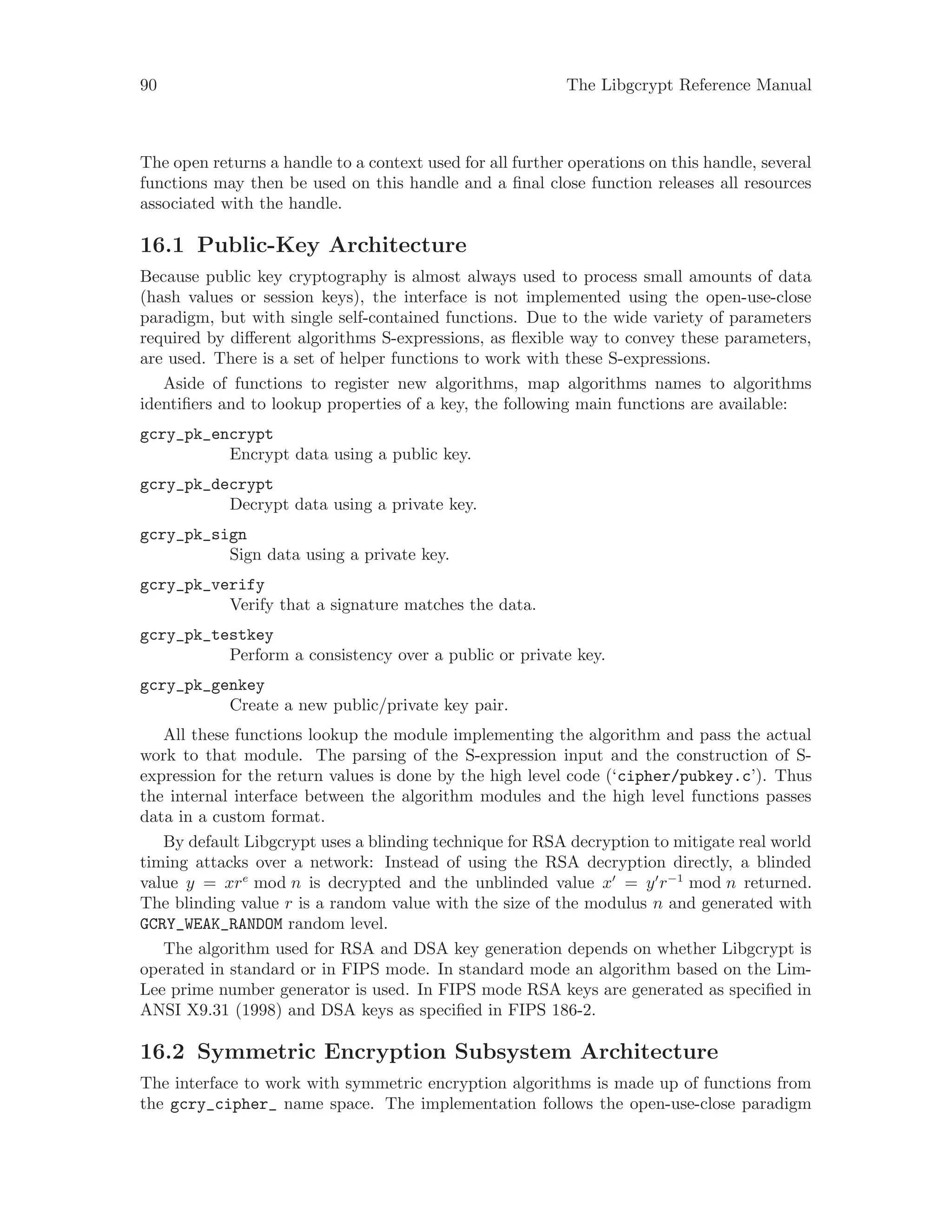
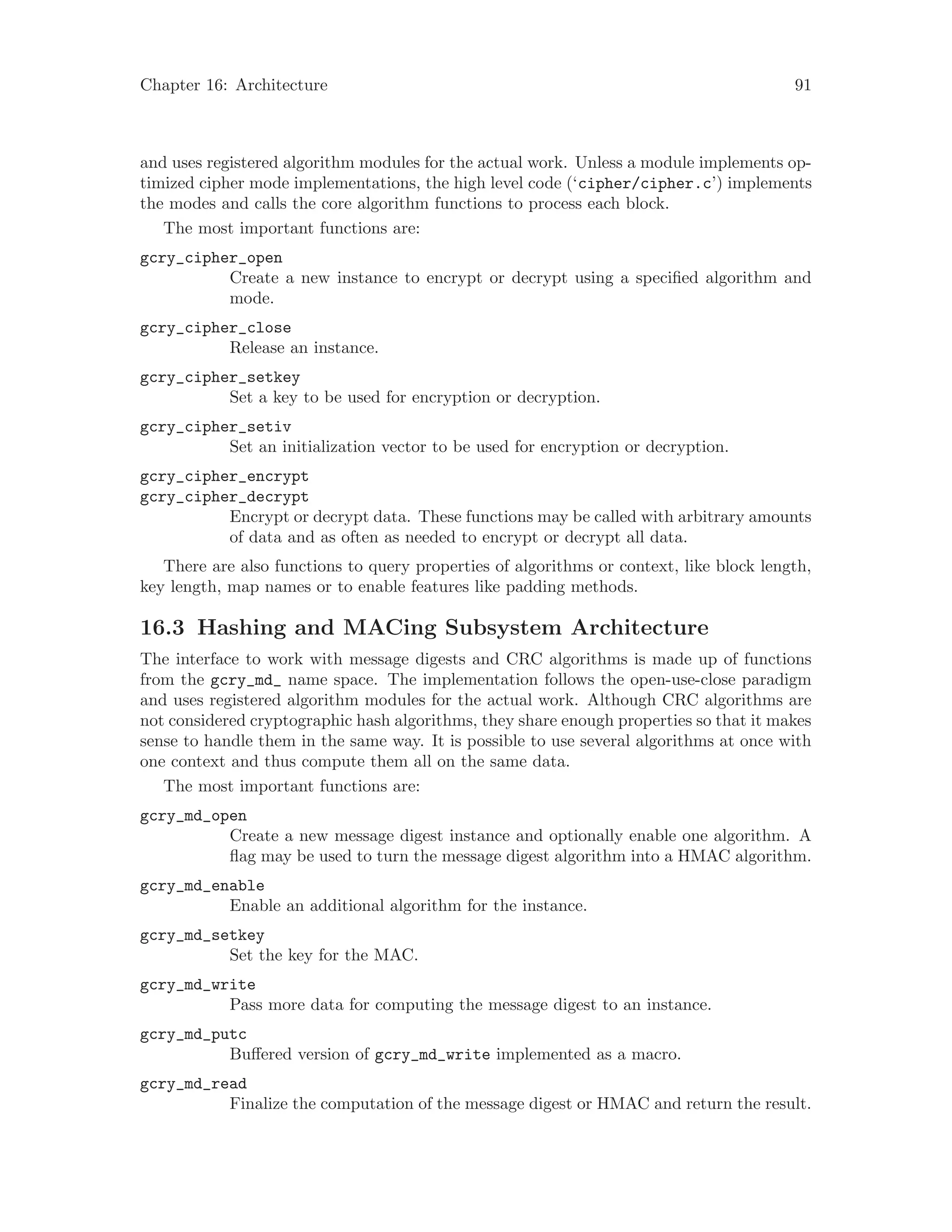
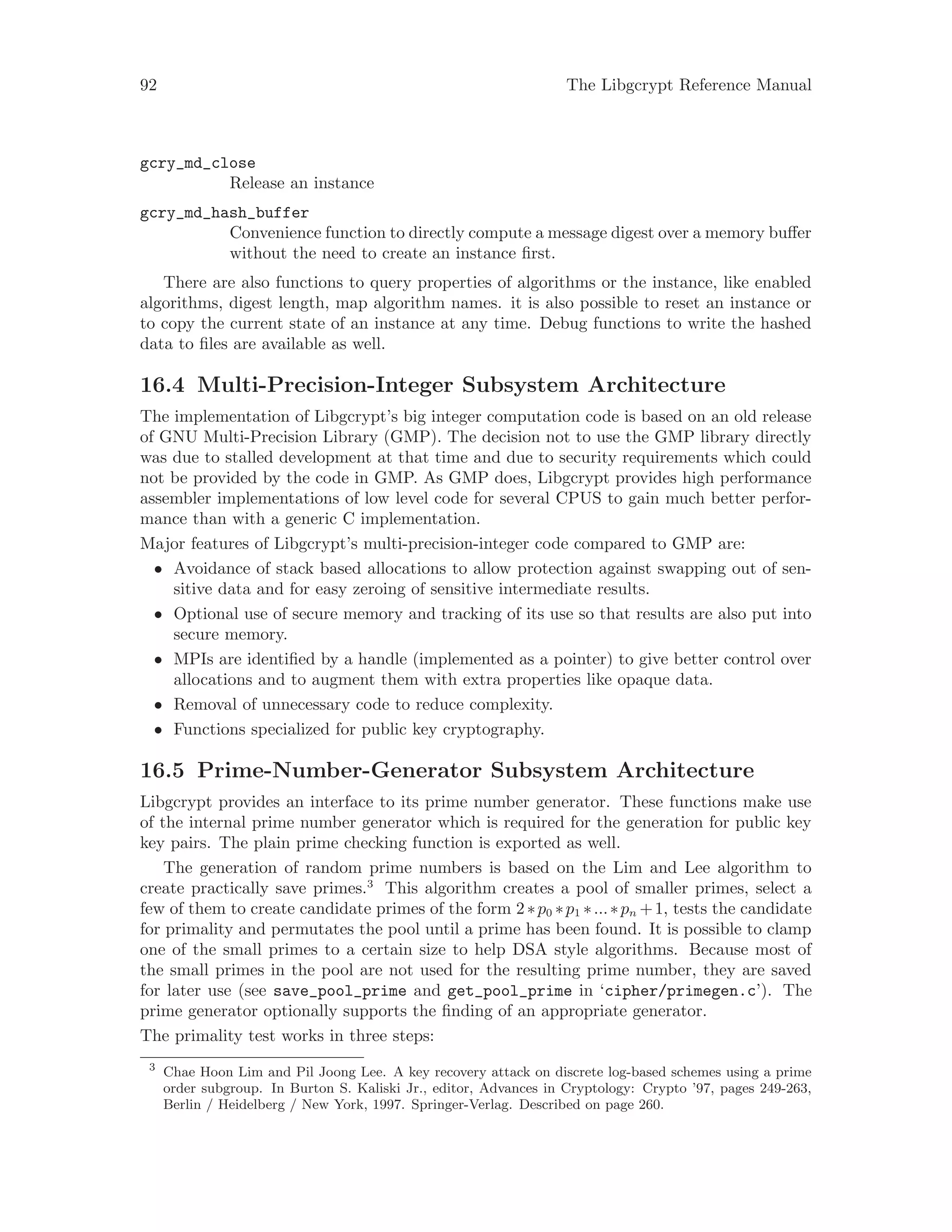
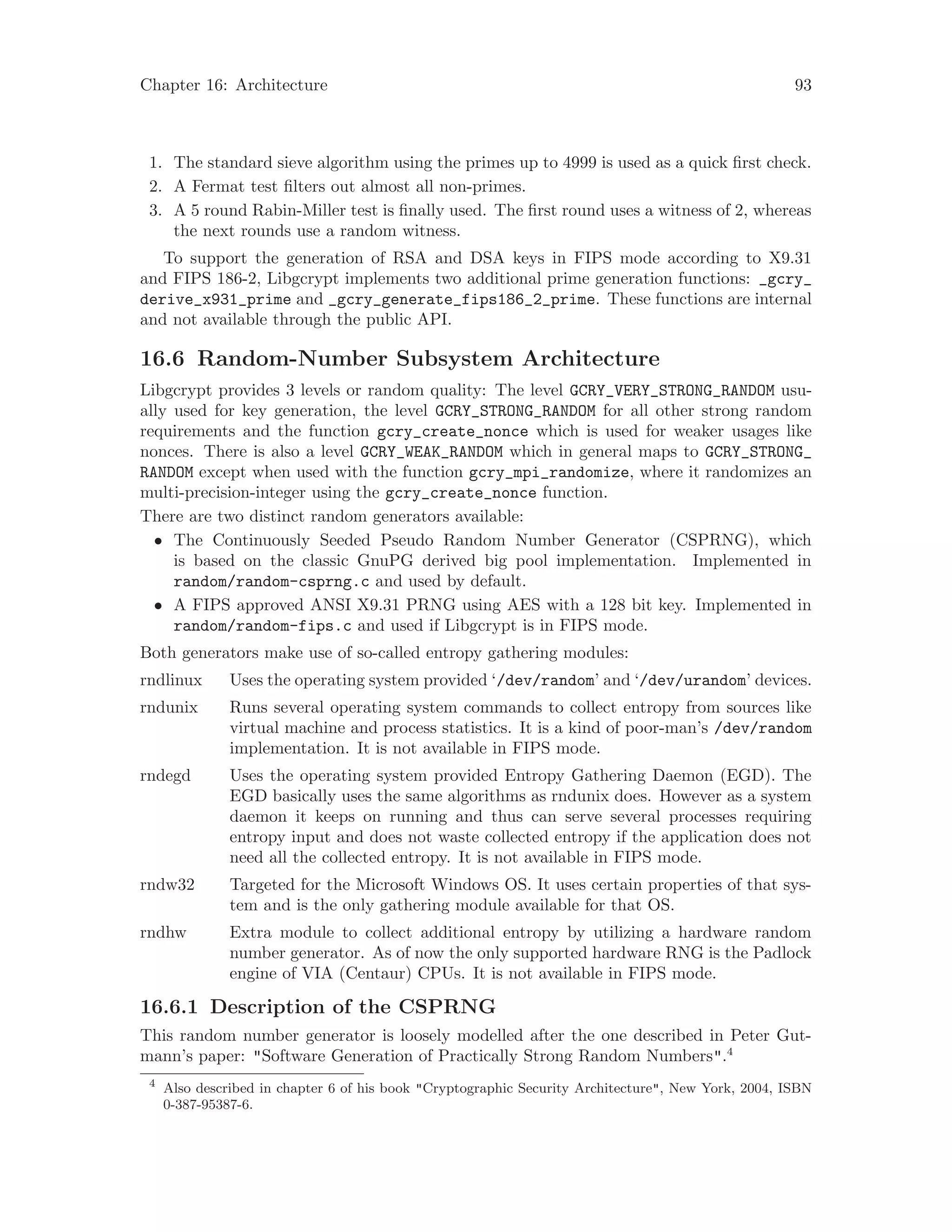
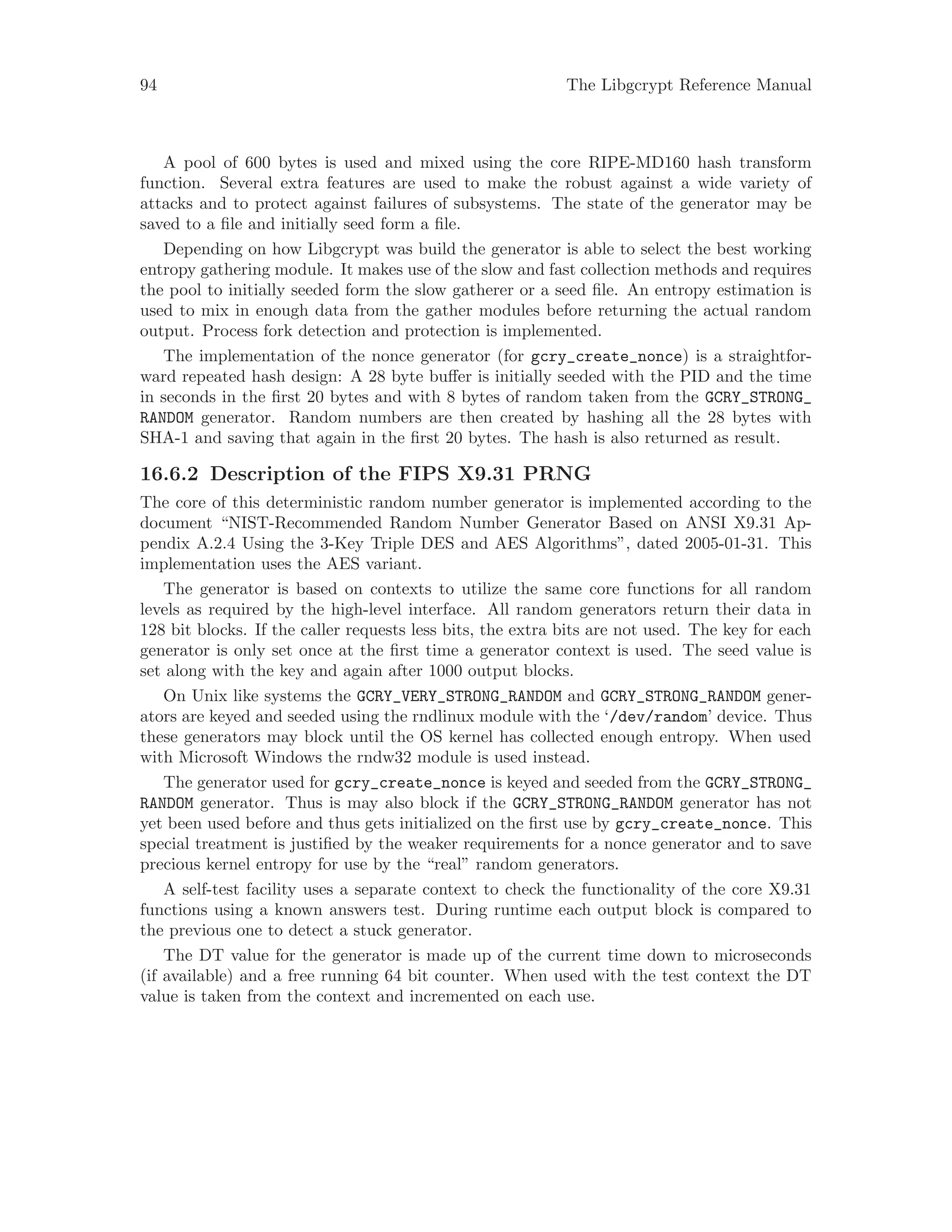
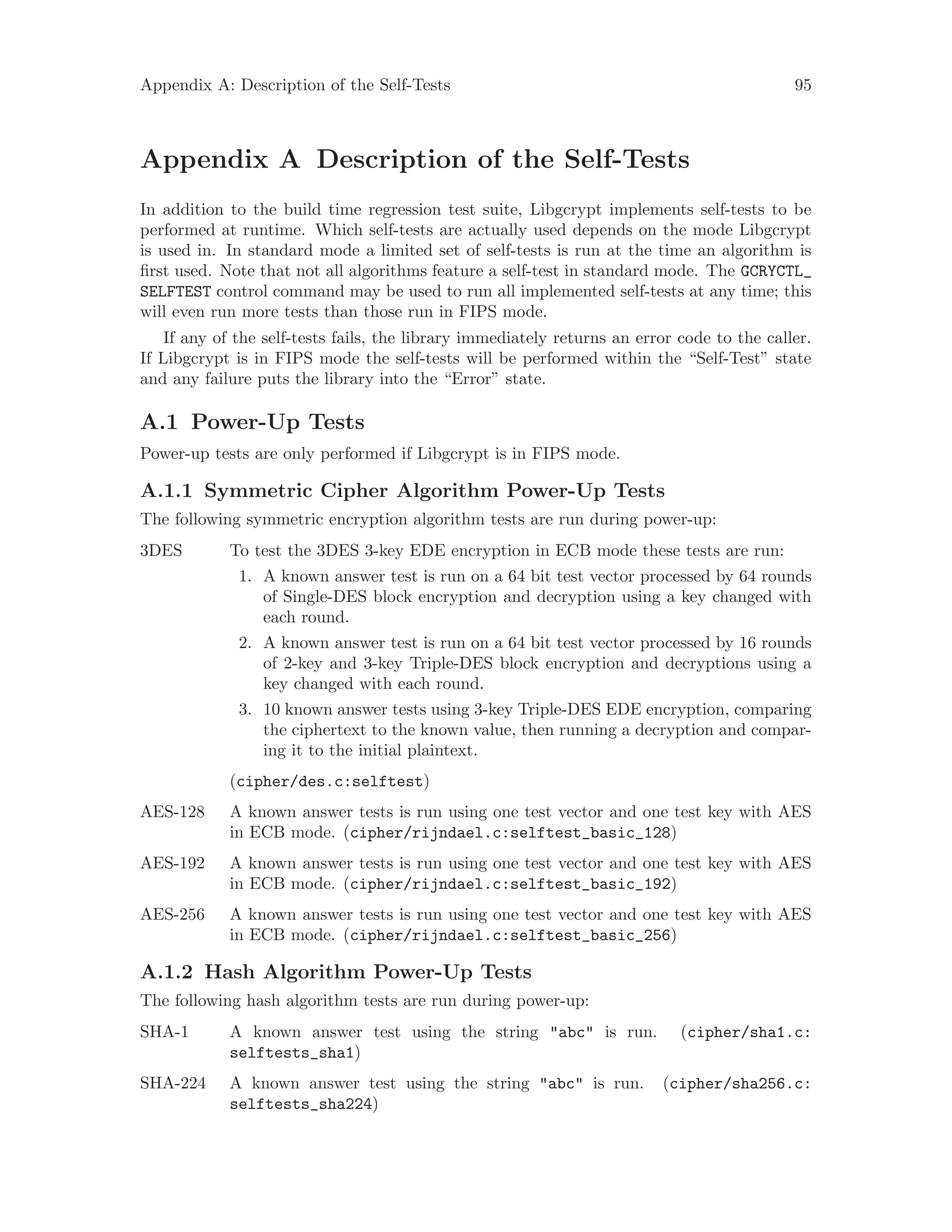
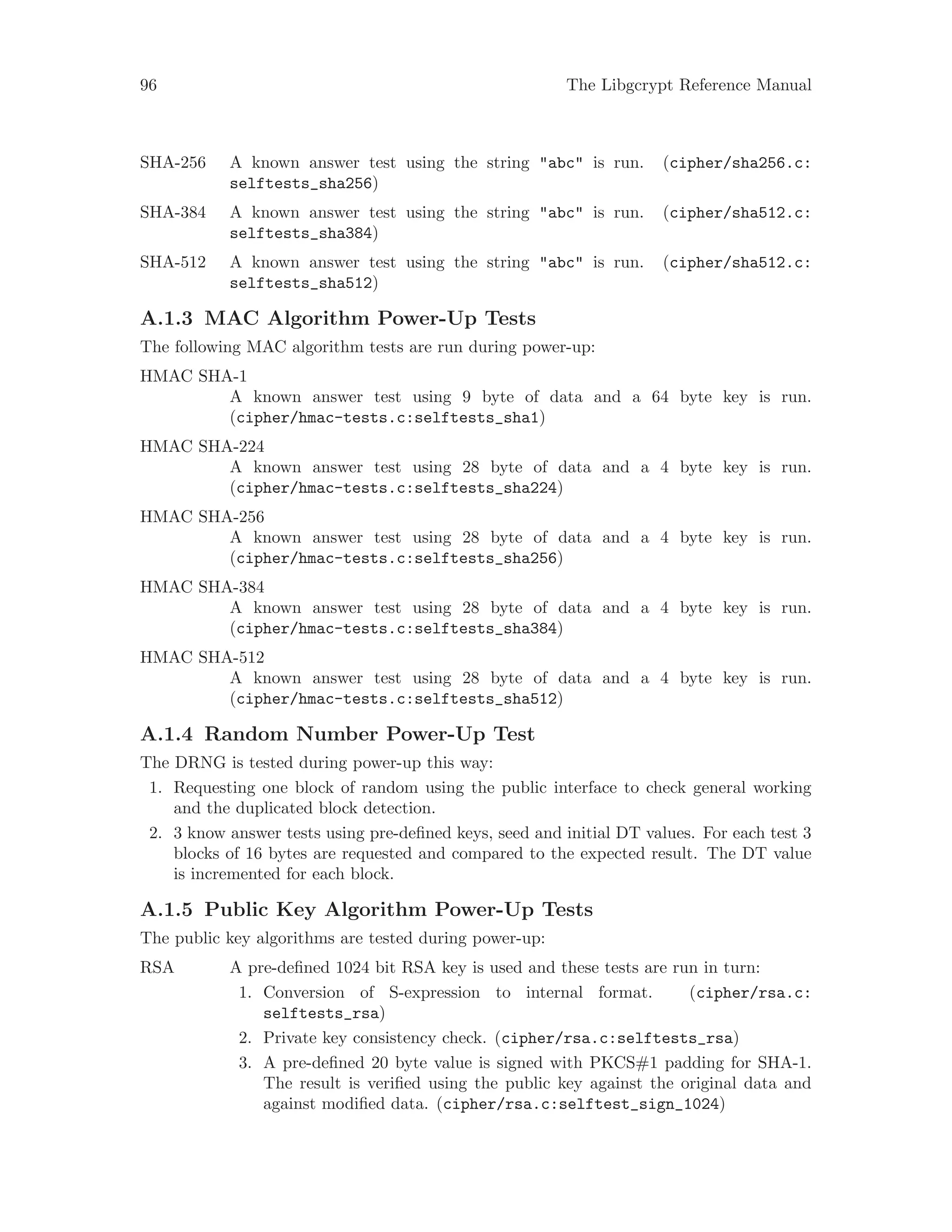
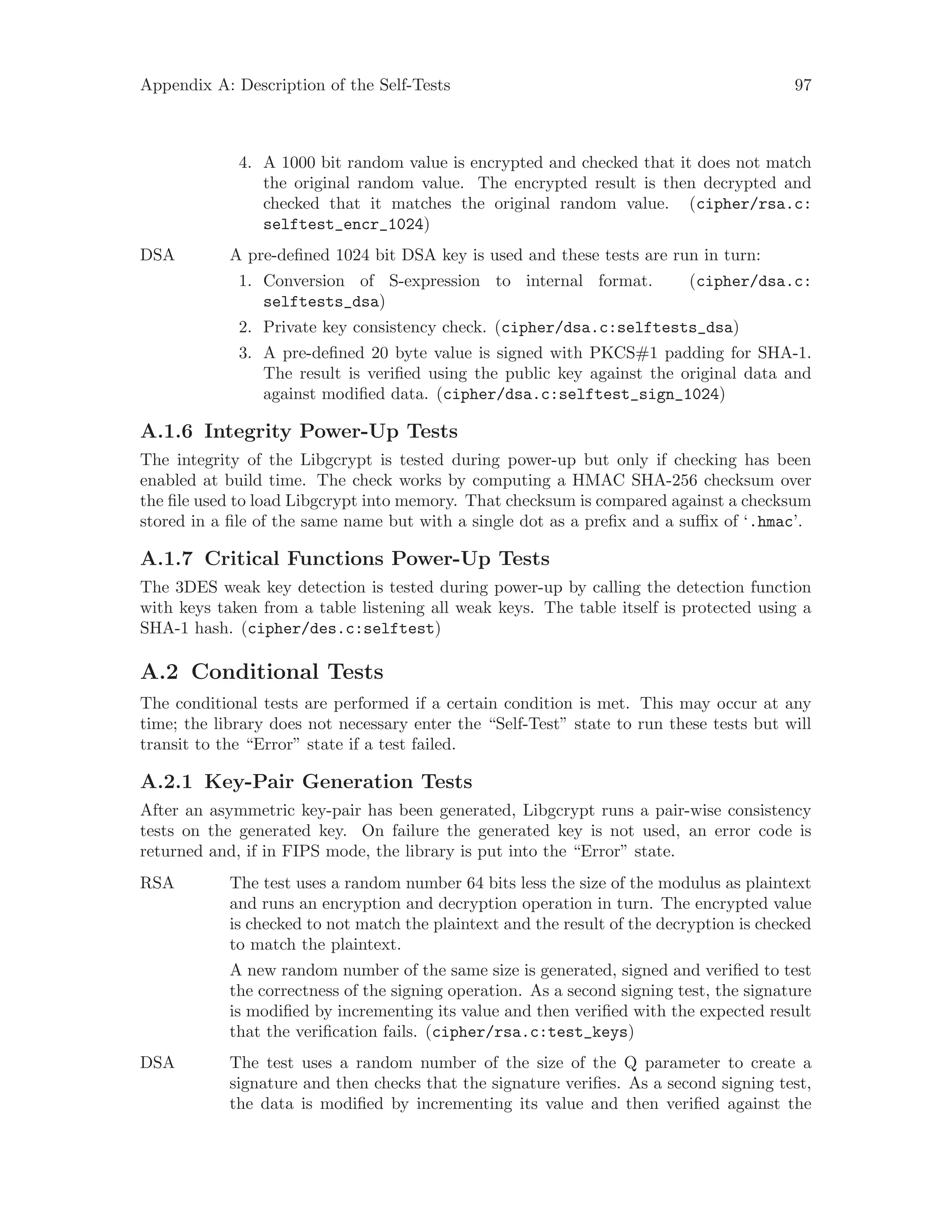
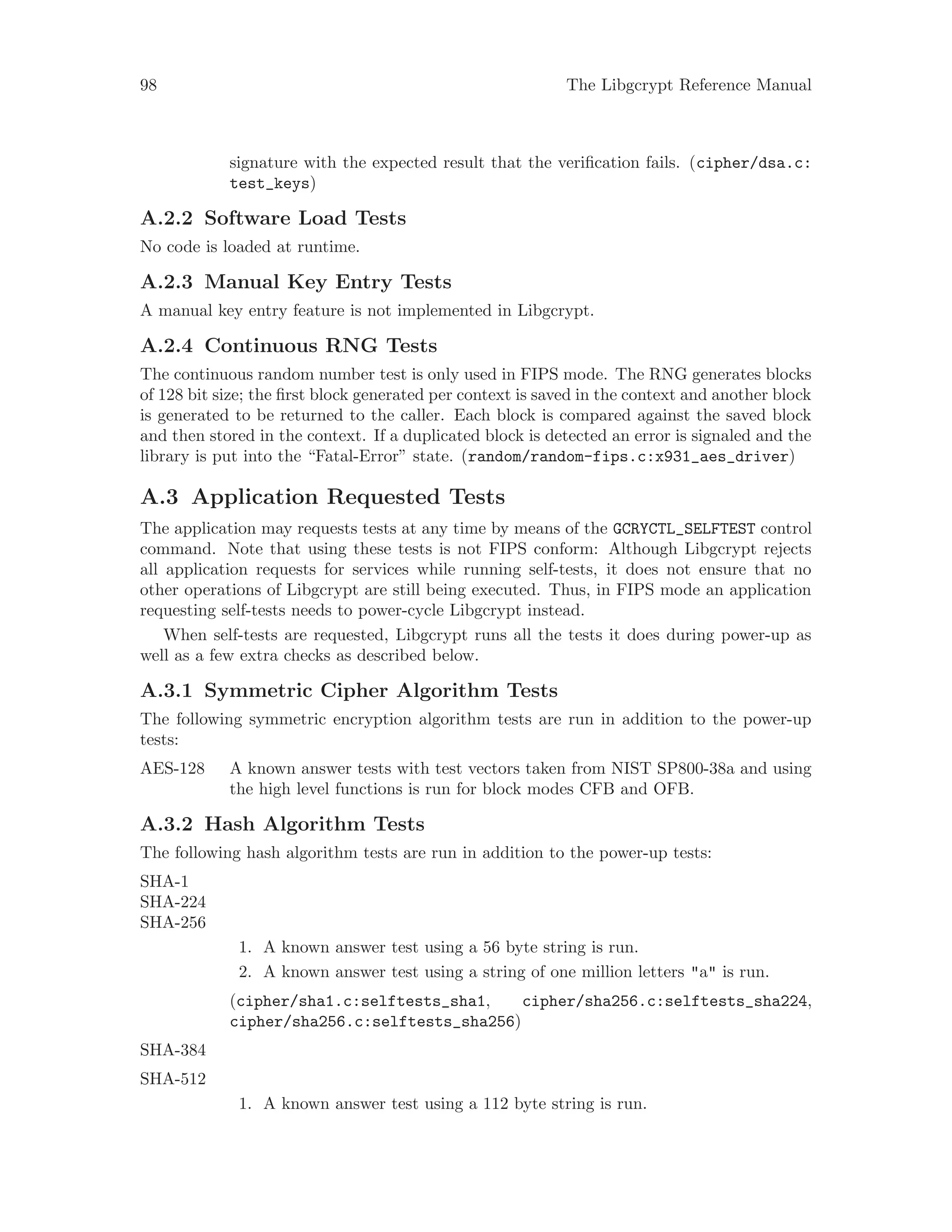


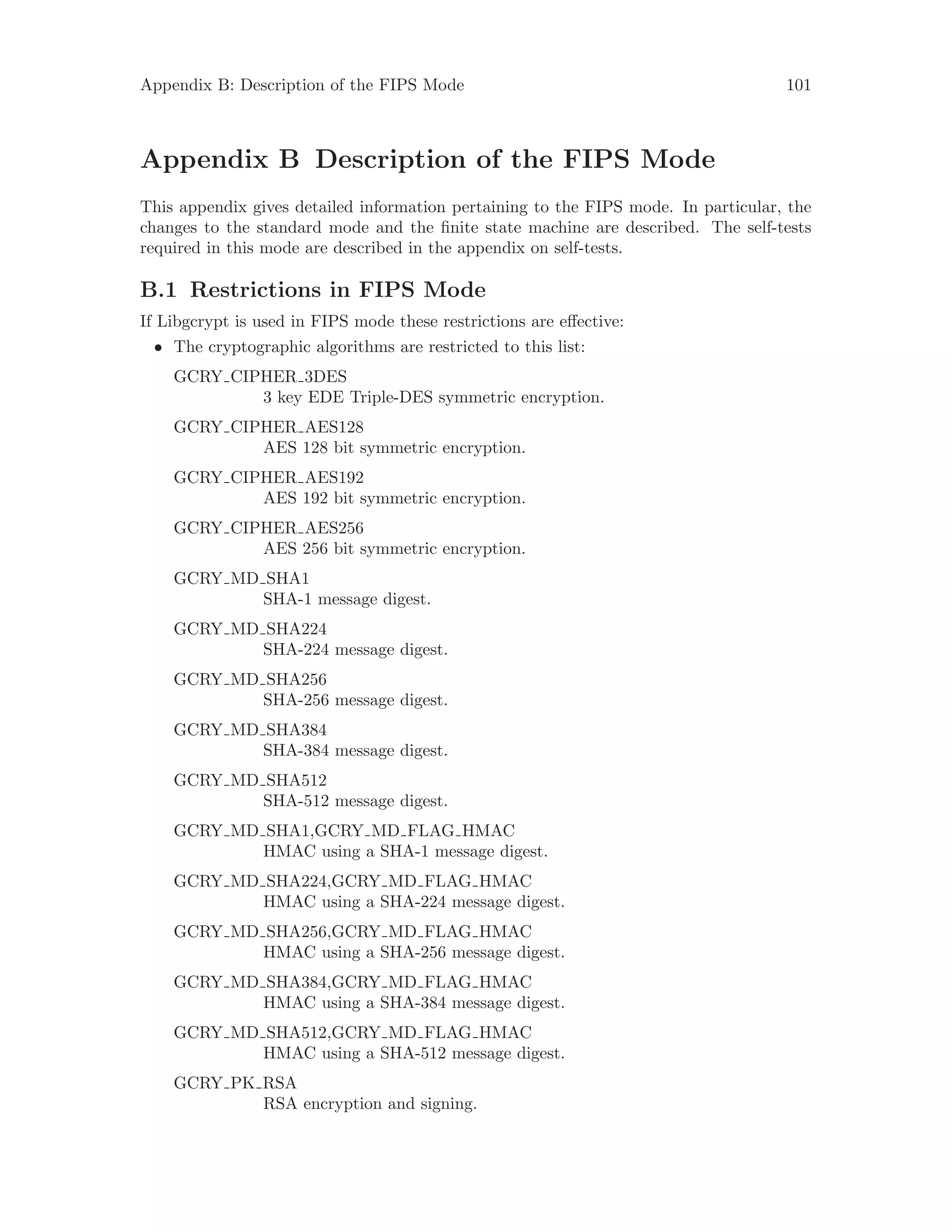
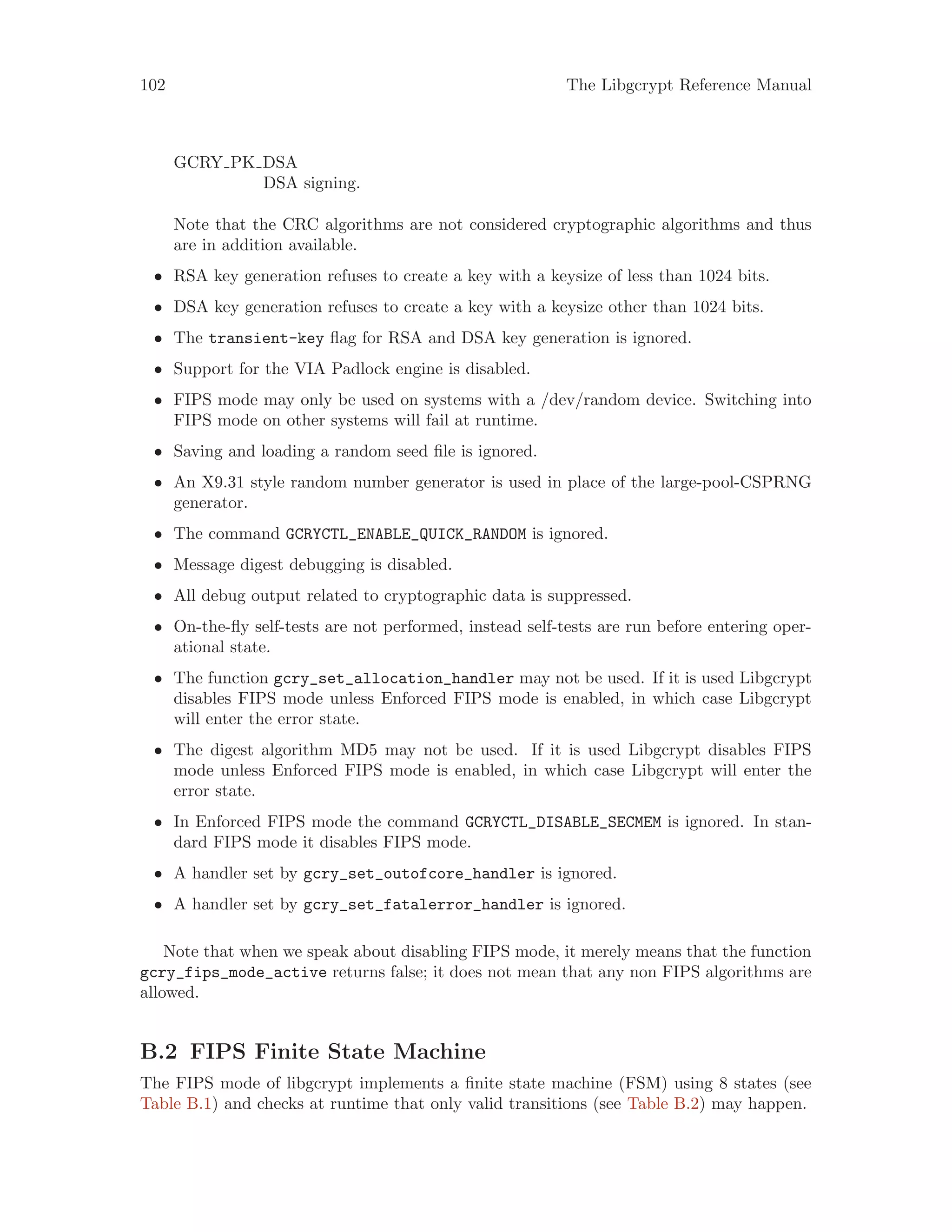
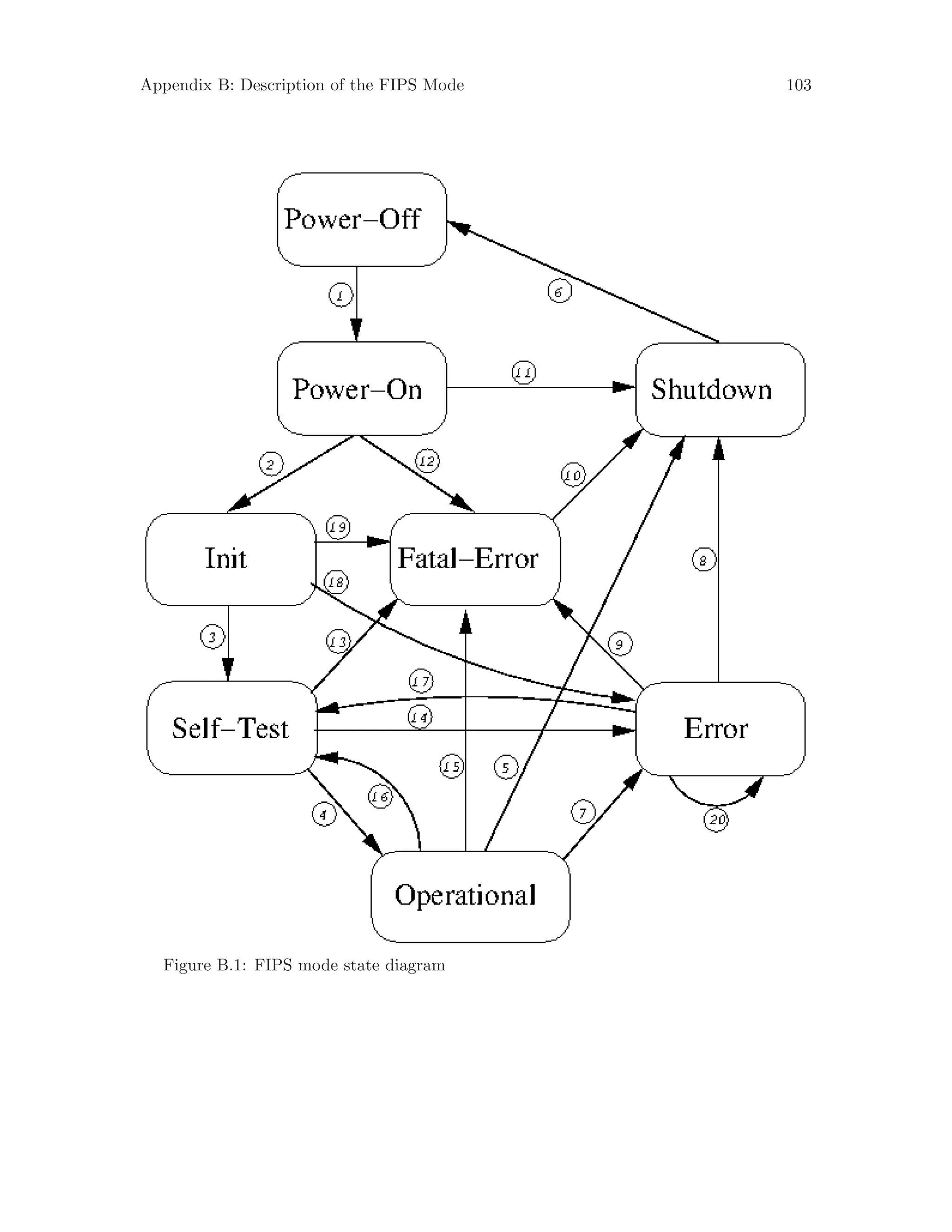
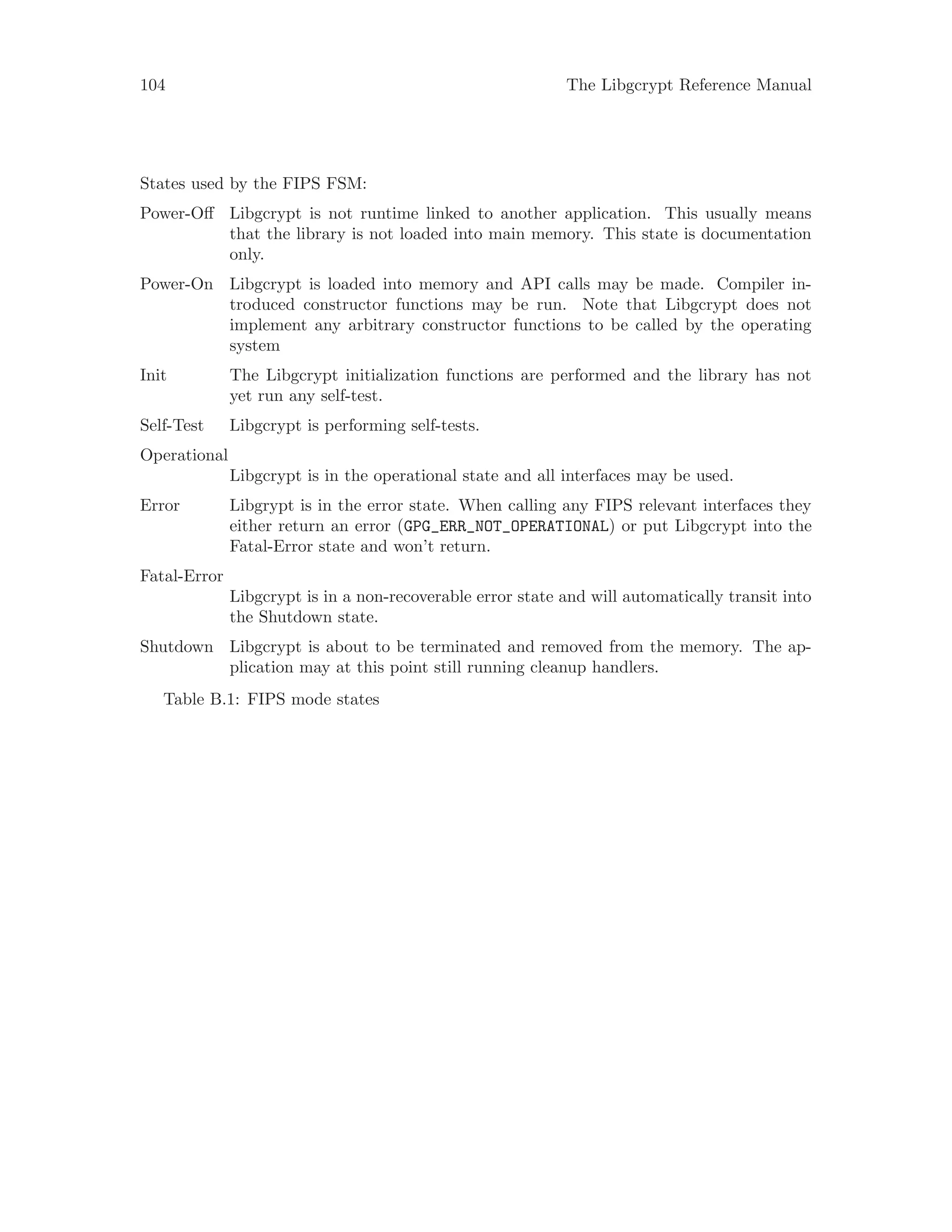
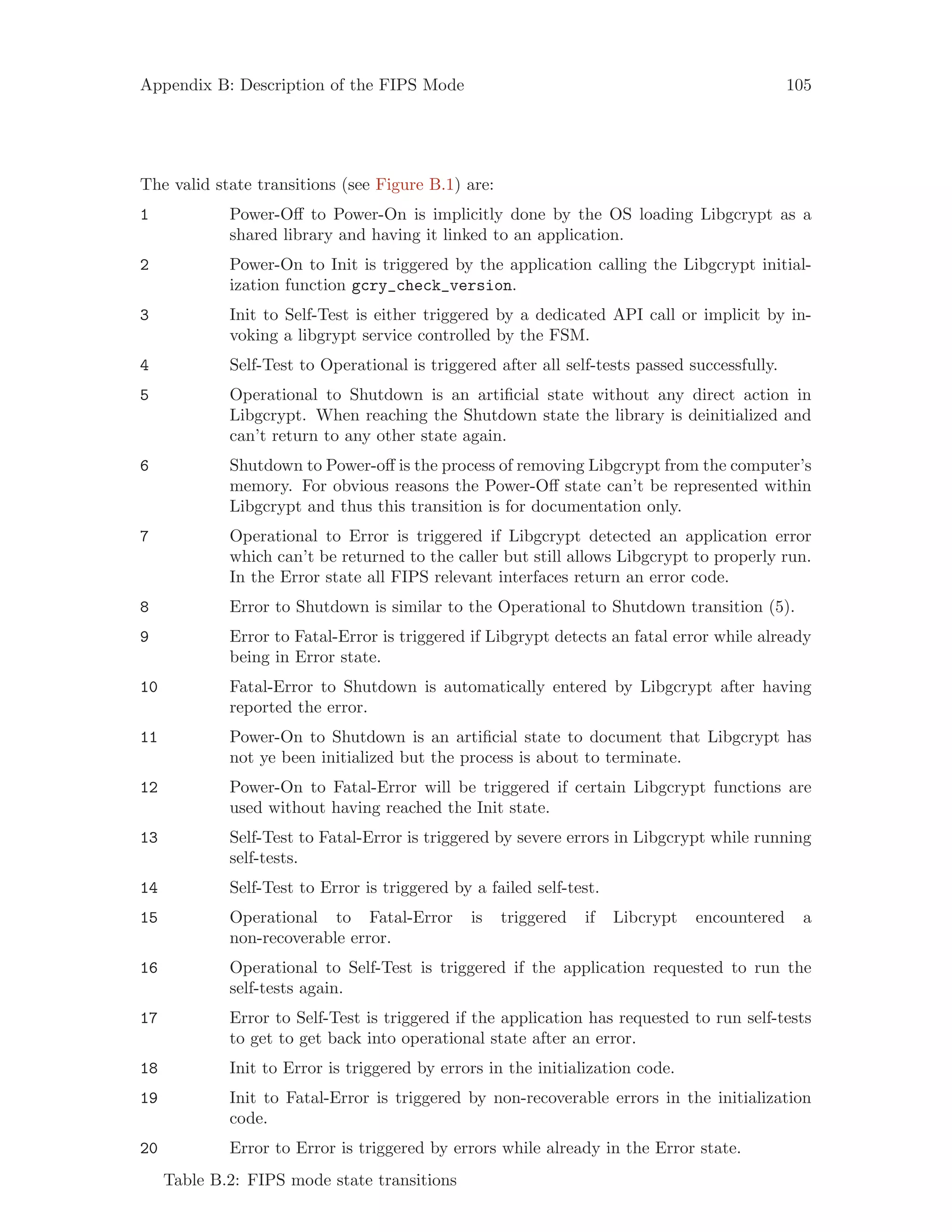
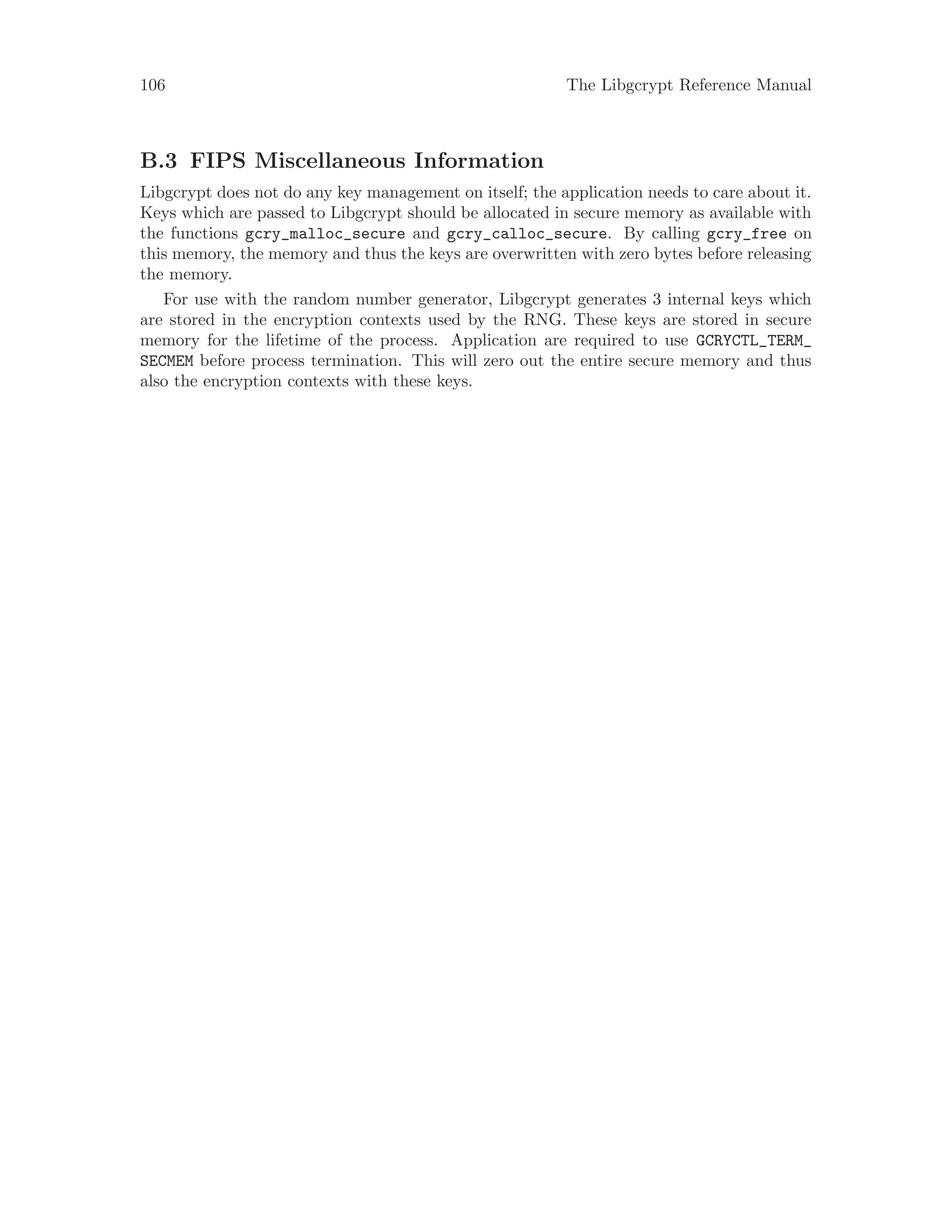
![GNU Lesser General Public License 107
GNU Lesser General Public License
Version 2.1, February 1999
Copyright c 1991, 1999 Free Software Foundation, Inc.
59 Temple Place – Suite 330, Boston, MA 02111-1307, USA
Everyone is permitted to copy and distribute verbatim copies
of this license document, but changing it is not allowed.
[This is the first released version of the Lesser GPL. It also counts
as the successor of the GNU Library Public License, version 2, hence the
version number 2.1.]
Preamble
The licenses for most software are designed to take away your freedom to share and change
it. By contrast, the GNU General Public Licenses are intended to guarantee your freedom
to share and change free software—to make sure the software is free for all its users.
This license, the Lesser General Public License, applies to some specially designated
software—typically libraries—of the Free Software Foundation and other authors who decide
to use it. You can use it too, but we suggest you first think carefully about whether this
license or the ordinary General Public License is the better strategy to use in any particular
case, based on the explanations below.
When we speak of free software, we are referring to freedom of use, not price. Our
General Public Licenses are designed to make sure that you have the freedom to distribute
copies of free software (and charge for this service if you wish); that you receive source code
or can get it if you want it; that you can change the software and use pieces of it in new
free programs; and that you are informed that you can do these things.
To protect your rights, we need to make restrictions that forbid distributors to deny you
these rights or to ask you to surrender these rights. These restrictions translate to certain
responsibilities for you if you distribute copies of the library or if you modify it.
For example, if you distribute copies of the library, whether gratis or for a fee, you must
give the recipients all the rights that we gave you. You must make sure that they, too,
receive or can get the source code. If you link other code with the library, you must provide
complete object files to the recipients, so that they can relink them with the library after
making changes to the library and recompiling it. And you must show them these terms so
they know their rights.
We protect your rights with a two-step method: (1) we copyright the library, and (2) we
offer you this license, which gives you legal permission to copy, distribute and/or modify
the library.
To protect each distributor, we want to make it very clear that there is no warranty for
the free library. Also, if the library is modified by someone else and passed on, the recipients
should know that what they have is not the original version, so that the original author’s
reputation will not be affected by problems that might be introduced by others.
Finally, software patents pose a constant threat to the existence of any free program.
We wish to make sure that a company cannot effectively restrict the users of a free program](https://image.slidesharecdn.com/gcrypt-170906152619/75/Gcrypt-115-2048.jpg)
